
Clarington remembers the sacrifices and achievements of the local men and women who served in Canada's military in times of war, military conflict and peace. We also remember those who have died since returning home from Active Service.
Over 240 Clarington streets and many schools bear the names of local veterans who served Canada as a way to honour their contributions and sacrifices.
Indigenous Veterans Day
November 8 is Indigenous Veterans Day, a day of remembrance and commemoration of the contributions of Indigenous veterans during the First World War, Second World War, and Korean War.
Clarington Remembrance Services
- Check back in fall 2026 for a list of Remembrance Day Services across Clarington.
Veteran banners
Each year, from October to mid-November, Veteran banners hang on the street posts throughout our downtowns to pay tribute to the men and women from Clarington who served in the military. We would like to thank our local Royal Canadian Legion Branch 178 for their assistance in compiling the images and stories below.
| Robert E. (AI) Adams |
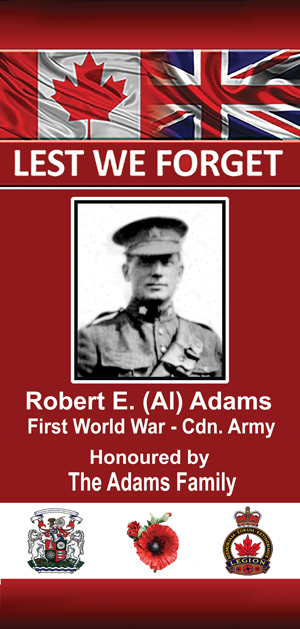 Robert Elmer Adams was born on February 18, 1885, to Thomas and Maria (nee Bullied). He was one of 14 siblings raised on a farm in Clarke Township near the Canadian Tire Motorsport Park. All the children worked alongside their parents on the farm, and attended a local one-room rural schoolhouse. Robert Elmer Adams was born on February 18, 1885, to Thomas and Maria (nee Bullied). He was one of 14 siblings raised on a farm in Clarke Township near the Canadian Tire Motorsport Park. All the children worked alongside their parents on the farm, and attended a local one-room rural schoolhouse.
Although his given name was Robert, he went with his middle name Elmer, shortened to the nickname Al. Al and two of his brothers were part of the 1901 Champion Leskard Football (soccer) Team in the Clarke Football Association, which had 11 members. He worked on a train crew as a brakeman on the Ontario and Quebec Railway, a subsidiary of the Canadian Pacific Railway (CPR) that operated the Toronto to Peterborough line that traverses the northern boundary of Clarington. At 30, Al volunteered to serve in the First World War on February 25, 1915, and was assigned to a Southwestern Ontario cavalry unit, the 7th Canadian Mounted Rifles. The cavalry unit mobilized in London, Ontario on March 15, 1915, for training and shipped out of Montreal for England on June 9, 1915. On arrival, they trained at the Canadian Cavalry Depot in Canterbury and later landed in France on September 17, 1915. The nature of warfare had changed considerably, making cavalry units redundant. With the increasing use of machine guns and accurate artillery, fighting battles from horseback became a thing of the past. Cavalry units were dismounted, with most of the men absorbed into infantry units. At some point, Al was reassigned to the Canadian Field Artillery. Not much is known of the battles in which he was engaged, but he did serve for almost three years in various First World War battle theatres. The First World War was the first major conflict involving large-scale use of aircraft. The aircraft played a critical role in reconnaissance, especially for ranging and correcting artillery fire, and could also be utilized for bombing raids. A branch of artillery, anti-aircraft batteries, was created to counter this threat. On August 29, 1918, Al was manning an anti-aircraft battery near the French town of Fampoux. A war diary indicates his battery engaged six enemy aircraft on this date but came under constant shelling from enemy artillery. Al was killed in action. He was 33. |
| Jarvis Edward Belsey |
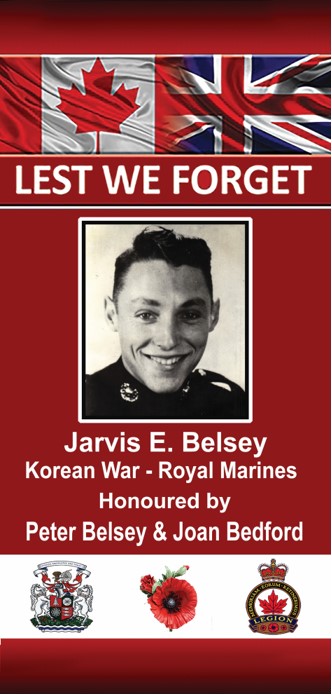
Corporal Jarvis Belsey was born April 8, 1927, to Edward and Gladys (nee Smith) Belsey in Dover, England. His father, Edward (Ted), served in the Royal Navy for 27 years. Jarvis left high school before graduation and enlisted with the Royal Marines on his 18th birthday in 1945, just before the end of the Second World War. In 1947, Ted and Gladys immigrated to Newcastle, Ontario. Jarvis served in the Royal Marines in England and could not join the family in the move to Newcastle, but in 1949, he had three months of leave and stayed with his family, helping his father build their home. During the Second World War, the Royal Marines developed into light infantry battalions and re-organized as commando units, utilized on coastal raids and amphibious invasions. Commando units are the elite troops used for special operations requiring dedicated operational techniques and specializing in unconventional assaults on high-value targets. They perform in enemy territory beyond the fronts of their regular infantry; often, they are paratroopers. In 1950, the Royal Marines reconstituted 41 (independent) Commando, following a request from the United Nations Command for more amphibious raiding forces. The independent designation meant that their commander had sole responsibility for their deployment. Jarvis was assigned to this unit and then transported to Korea on November 10. Before leaving for Korea, he married Joyce West in August 1950. His unit joined the United Nations advance into North Korea, where they served with the United States Marine Corps. Immediately, they were deployed to execute a series of raids on the North Korean coast near Wonsan to disrupt North Korean transportation facilities. Jarvis' commando unit then joined other UN infantry units, about 30,000 strong, to push inland from Wonson through the Korean peninsula. The ensuing battles for 17 days found the UN troops surrounded, necessitating a fighting withdrawal to break out of the encirclement and retreat to the coast. A bitter cold streak plunged temperatures into the minus 30s, causing thousands of casualties due to frostbite. Jarvis' unit was assigned to relieve a US Marine Corps battalion at Koto-ri south of the Chosin Reservoir. On November 29, 1950, his unit came under attack. He was in a transport convoy that the Chinese mortared. He died when struck by shrapnel while riding in a troop truck. A successful evacuation of UN troops and personnel took place at the North Korean coastal city of Hungnam. Jarvis was buried in a military cemetery in the South Korean city of Pusan. Although a resident of Clarington for only three months, family members still reside locally. Jarvis' name is on the cenotaph in Newcastle. |
| Robert Alexander Bothwell |
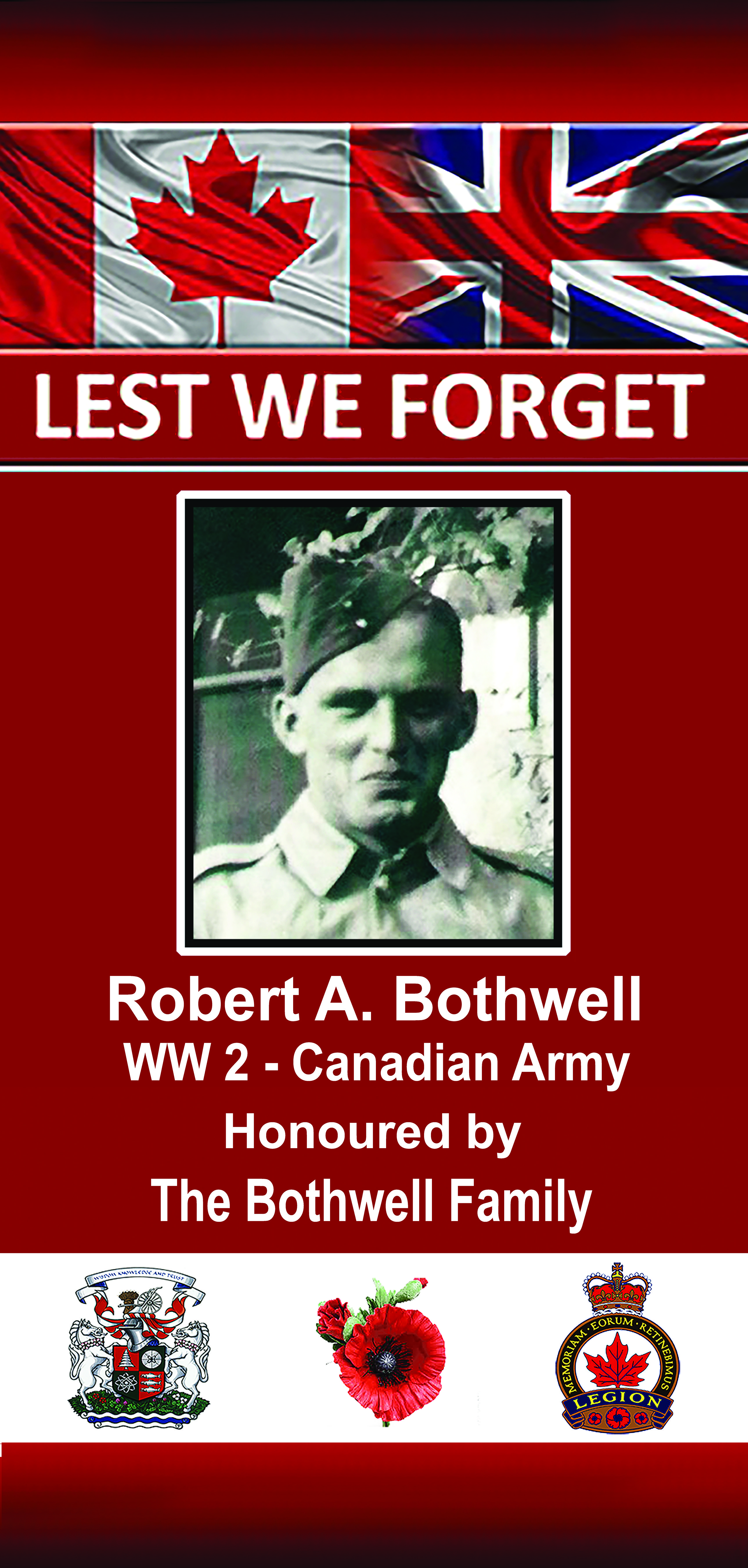
Robert (Bob) Alexander Bothwell was born in Toronto, Ontario, on October 1, 1917, to David and Elizabeth Bothwell, and was one of eight boys. The family moved to the Maple Grove area when Bob was relatively young. He attended Maple Grove Secondary School and then assisted in the family business of building homes in the area. Bob enlisted with the 47th Battery of the Light Anti-Aircraft, Royal Canadian Artillery, on July 28, 1940, at 22. After training, he shipped out on Louis Pasteur's troopship on September 19, 1941. On October 26, 1943, the Regiment shipped out of Liverpool, England, and over the next two years, Bob served as a motorcycle dispatch rider in Italy, France, Holland and Belgium. While stationed in Italy, Bob and his younger brother Roy won a regimental horseshoe championship. After a motorcycle accident and time recovering in the hospital, he returned to civilian life on October 23, 1945. Upon returning home, he worked for General Motors for a couple of years before rejoining the family business, building homes in the Maple Grove area. In 1947, he began constructing the family home and married Norma Jean, who gave him two sons. He later owned and operated "Maple Grove Sash and Door" for several years on Highway 2. As times got tough for a self-employed family man, Bob closed his business in the early 1960s. He returned to General Motors before retiring in the mid-1970s. Throughout his working life, Bob tackled large and small projects in his garage, from building and selling dog houses, wishing wells and boats and refashioning cars into unique and functional trucks. He enjoyed fishing at the cottage with his family and Sunday drives in the Kawarthas. In his later years, he enjoyed watching his garden grow. After suffering a stroke on December 27, 1996, Bob died at 79. |
| Donald R. Brooks |
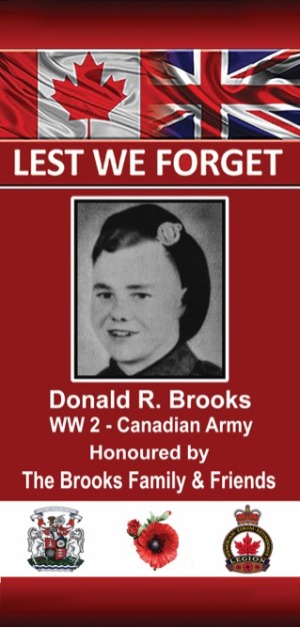 On October 7, 1924, Donald Brooks was born to George and Lydia Brooks and raised in Bowmanville along with his ten brothers and sisters. Donald enlisted to serve in the Second World War on January 8, 1942, at 17, lying about his birthday so he could immediately serve overseas. When sent to England later in 1942, he trained with The Fort Garry Horse Armoured Regiment. In June of 1943, a reorganization of the armoured units took place, and this unit became the 10th Canadian Armoured Regiment of the 2nd Canadian Armoured Brigade. On October 7, 1924, Donald Brooks was born to George and Lydia Brooks and raised in Bowmanville along with his ten brothers and sisters. Donald enlisted to serve in the Second World War on January 8, 1942, at 17, lying about his birthday so he could immediately serve overseas. When sent to England later in 1942, he trained with The Fort Garry Horse Armoured Regiment. In June of 1943, a reorganization of the armoured units took place, and this unit became the 10th Canadian Armoured Regiment of the 2nd Canadian Armoured Brigade.
The tank crews trained on Duplex Drive (DD) tanks, modifications that allowed tanks to swim from landing craft to shore. In addition, the 2nd Armoured Brigade worked closely with the 3rd Canadian Infantry Division, the very infantry units that Donald’s armoured unit would be supporting when the Normandy invasion took place. On D-Day, the infantry of the Queens Own Rifles, part of the 3rd Canadian Infantry, were supported by the armour of the Fort Garry Horse. They were the only allied units on all the Normandy beaches to achieve their first-day objective, 13 kilometres inland. They pushed further but were forced to back off as they were in danger of overrunning their supply chain. Nevertheless, this armoured regiment remained active in Northwest Europe, fighting throughout the campaign until Victory in Europe Day (VE Day) eleven months later, supporting any infantry needing armoured support. They won battle honours on 13 different occasions. Donald was demobilized on April 30, 1946, and returned home. Through the Department of Veterans Affairs, Donald received vocational training as a carpenter. He later became a master carpenter and worked as a private contractor building homes in Durham Region over the next forty years. Donald met his wife, Doris May Tullock, and they married on June 28, 1947, raising three children. He built his final dream home north of Port Hope, where he and his wife lived on a large, wooded farm property, which would become the favourite place for all his grandchildren. His passions included travel and long car rides, visiting family and friends in Florida and New York State, as well as numerous adventures across the entire country up to the final years of his life. He died peacefully with family by his side on March 29, 2008. He was 83. |
| Frederick Brown |
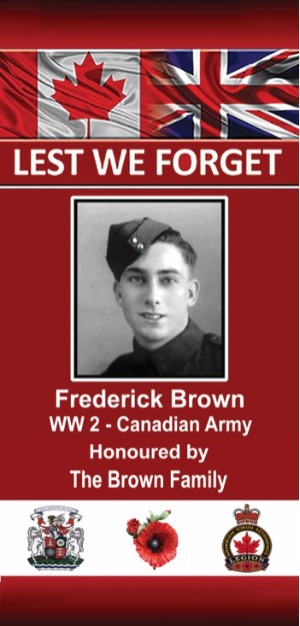 Frederick Brown was born on September 1, 1923, in Weston, Ontario. He was the ninth child of Charles and Mildred Brown, who raised a family of eleven children. Upon leaving school, Fred worked at Canadian Cycle and Motor Co. Ltd., the largest employer in Weston. Frederick Brown was born on September 1, 1923, in Weston, Ontario. He was the ninth child of Charles and Mildred Brown, who raised a family of eleven children. Upon leaving school, Fred worked at Canadian Cycle and Motor Co. Ltd., the largest employer in Weston.
When Fred turned 18 in 1941, he enlisted to serve in the Second World War in the Canadian Army, assigned to the Royal Canadian Corps of Signals. Fred transported equipment to where it was required and laid wireline communications cable from rear command centres to active fighting units on the fronts. This technology became invaluable during the Second World War, providing wireless communications to mobile army units and the constantly shifting fronts. When established overseas, the Canadian Signals were based at various locations in southeast England. Preparing for the Normandy invasion, they trained with Canadian infantry, artillery and armoured units throughout the UK. Fred went ashore in France after D-day, supporting the Canadian fighting units through France, Belgium, Netherlands and Germany. Fred met Mary Adams at a cinema in Aberdeen, Scotland, and married her before being demobilized in November 1945. He went home to Weston, and Mary followed him eight months later in July 1946. They moved to Vancouver Island with one child, later returning to Ontario with two children. Fred worked construction jobs in Kingston, Oshawa and Toronto as a heavy equipment operator, but the family moved to Bowmanville in December 1953 with four children. In 1972, he began work as a road superintendent for the Town of Bowmanville until he retired in 1988. Fred was a member of the local Royal Canadian Legion Branch, served as its president and was a frequent member of the colour party. In September 2014, a representative from the Armée de Terre (French Army) and the ambassador from their Ottawa embassy presented Fred with a service medal for the role he played in helping liberate France. He was amazed when he was kissed on both cheeks, a traditional Gallic honour. Fred died on April 25, 2015, at 93. |
| Mabel Emma Bruce |
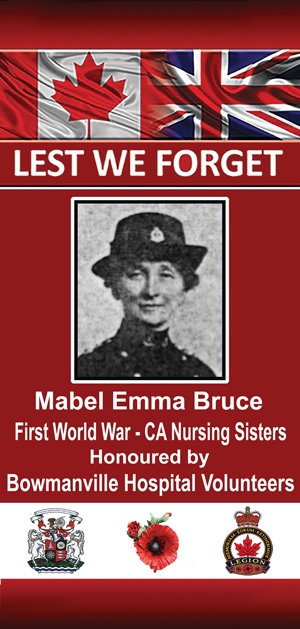 Mabel Bruce was born on July 29, 1878, in the Cartwright Township village of Caesarea, on the shore of Lake Scugog. She trained as a nurse in St. Catharines, Ontario and completed post-graduate work at Bellevue Hospital in New York City. In 1911, she was briefly employed as an instructor at the Toronto Wellesley Hospital. When the Bowmanville Hospital opened on March 26, 1913, Mabel became the hospital's first superintendent. During her time at the hospital, she was responsible for teaching the first class of nurses. Mabel Bruce was born on July 29, 1878, in the Cartwright Township village of Caesarea, on the shore of Lake Scugog. She trained as a nurse in St. Catharines, Ontario and completed post-graduate work at Bellevue Hospital in New York City. In 1911, she was briefly employed as an instructor at the Toronto Wellesley Hospital. When the Bowmanville Hospital opened on March 26, 1913, Mabel became the hospital's first superintendent. During her time at the hospital, she was responsible for teaching the first class of nurses.
Mabel constantly gave herself to others, and in 1915, after the war broke out overseas, she decided to enlist and become a Nursing Sister to help the war effort. She went to England and France as part of the first Canadian Field Ambulance. During the war, Mabel wrote many letters describing what hospitals were like behind the lines. In one of her letters, she describes Christmas at the hospital where she worked, "Christmas time we decorated our ward to represent a Canadian snowstorm. I was on night duty, so I played the part of Santa Claus. We had bunches of cotton strung on thread and festooned from beams and rafters." Mabel distinguished herself and her work, and was honoured with the Mons Star service and victory medals and was presented with the Royal Red Cross by King George V at Buckingham Palace. The Royal Red Cross was a prestigious honour and was a medal awarded to nurses for their exceptional services, devotion, and professionalism in British military nursing. After the war, she married Charles G. M. Evans. They settled down and made a life for themselves in Manitoba, later in Victoria, British Columbia, where she continued to help others. Her nursing knowledge and experience made her an asset as there was no doctor in the area where she lived. Mabel Bruce Evans died on June 2, 1951. She was 72. Newspapers reported that she had been having health problems for quite some time, "having undermined her strength by giving her skill, time and energies so freely to others all her life." Mabel's medals and awards were given to the Bowmanville Hospital. Hospital volunteers paid to have them framed and displayed in the hospital she helped to start in 1913. Her legacy will forever continue, and she is remembered for the quiet assurance she met all problems inspired confidence and trust in all those under her care. Her untiring energy and devotion to duty will be long remembered by those privileged to associate with her. The original hospital building still stands, now known as the Bowmanville Hospital Foundation, and the street that it fronts upon has been named in her honour. |
| Jack Burgess |
|
Biography coming soon. |
| Mel Burgess |
|
Biography coming soon. 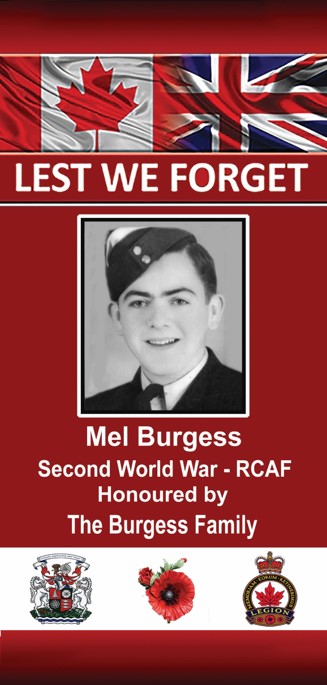 |
| Bruce R. Burley |
|
The family moved to Port Hope in 1949 as their bus service expanded, but Ron left in 1956 to work for the Province in the Department of Highways. At 13, Bruce joined the Air Cadets, where he served four years, initially in Cobourg and then in Port Hope. In June of 1963, at 17, Bruce joined the RCAF as a Bandsman. He transferred to the Tri-Service School of Music in Esquimalt, B.C. In January 1965, he was transferred to Camp Borden for Military Police training to support CAF missions by investigating incidents involving military or criminal offences, developing crime prevention measures to protect military communities against criminal acts and securing nuclear weapons. In June 1965, Bruce was sent overseas on a NATO deployment to an RCAF base in Germany. The cold war between the West and the Soviet Republic led to the development of NATO Dispersed Operating Bases throughout Western Europe to counter the threat. Bruce was stationed at the Zweibrücken Air Base, where nuclear weapons were stored. He performed his military police duties at this location for three years before returning to Camp Borden in 1968. Bruce left the RCAF in 1970 and joined the Ontario Provincial Police. He served five years in a uniform capacity at the Bracebridge detachment and spent the next 22 years in various investigative functions until his retirement in 1997. Post-retirement, he worked at CSIS for ten years, retiring in 2008. Bruce has two sons and six granddaughters. He currently resides in Port Hope and is a member of the Bowmanville Branch of the Royal Canadian Legion. |
| Ronald Percy Burley |
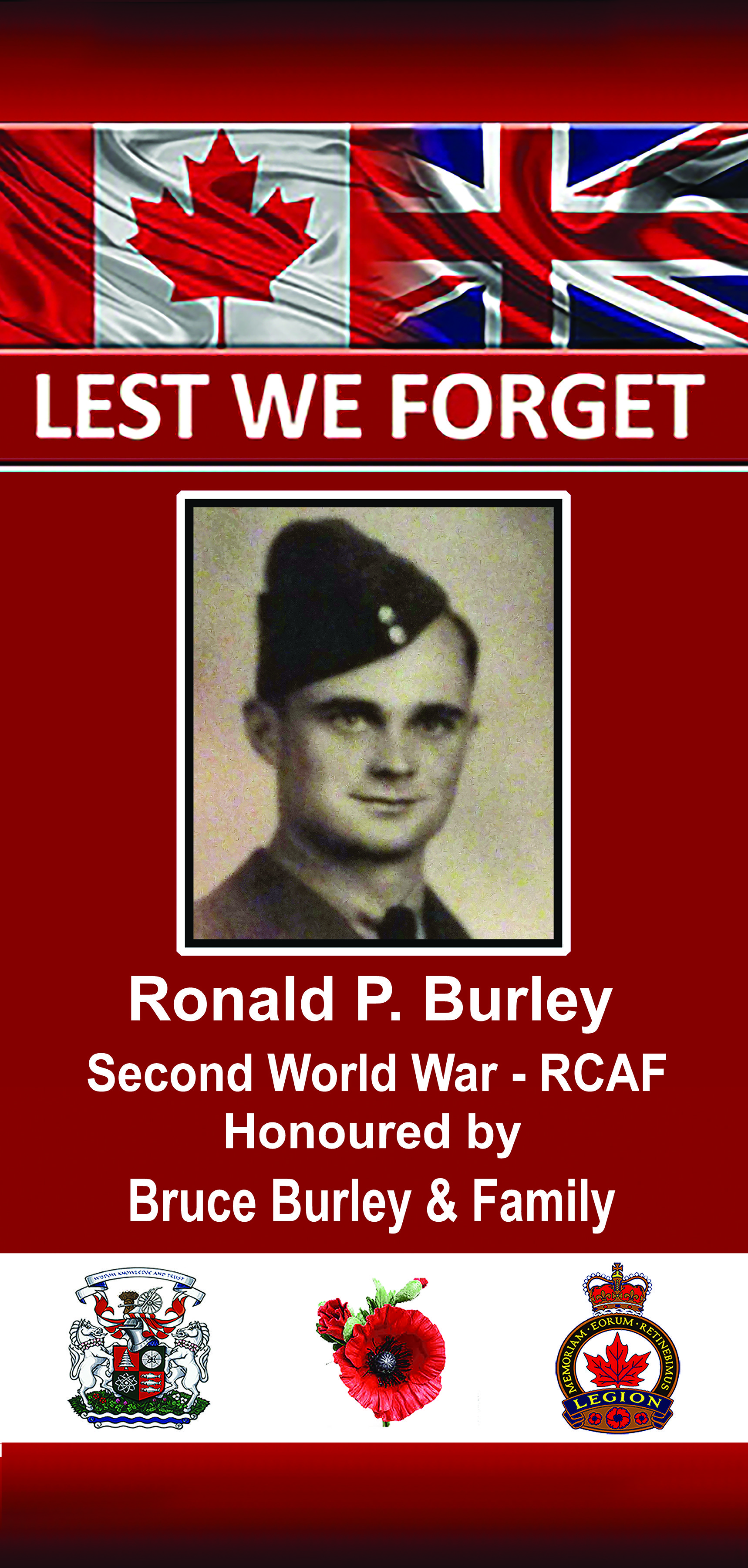
On June 1, 1918, Ronald Burley (Ron) was born to Cecil and Agnes Burley. He was raised in the hamlet of Port Granby in Clarke Township. Ron and his five siblings went to an elementary school in Newtonville and a secondary school in Port Hope. Ron was mechanically inclined, no doubt due to the garage exposure. At 21, Ron and two of his brothers volunteered for service in the Second World War. Ron opted for the Royal Canadian Air Force (RCAF) as a flight engineer (FE). The position of FE evolved with more complex systems, so, with wartime bombers and long-distance patrol aircraft, monitoring the engines and other critical systems freed the pilot to fly the aircraft. The FE sat in the cockpit to the pilot’s right. Ron was assigned to bases on the Atlantic and Pacific coasts, flying in long-range patrol aircraft. In Nova Scotia, at RCAF Station Dartmouth (present-day CFB Shearwater), his flights provided convoy escorts and conducted anti-submarine patrols. On Vancouver Island, RCAF Coal Harbour, he was stationed at a sea base for floatplanes and flying boats. Reconnaissance flights operated daily at this location to survey potential threats to the BC coast. After being demobilized in 1945, Ron returned to civilian life in Newtonville, where he married Margaret Denault and raised two boys. Ron founded the Burley Bus Lines with his brothers. In 1949, he moved the family to Port Hope, and in 1956, he accepted a position with the Department of Highways in Ontario. At the Department of Highways, Ron became a diesel mechanic instructor at the Provincial Institute of Trade. He left the Department of Highways in 1967, moved to Newcastle, and worked as a diesel mechanic for Howard L. Woods Transport in Bowmanville before retiring in 1981. Ron died in 2003 at 85. |
| Frederick Lionel Byam |
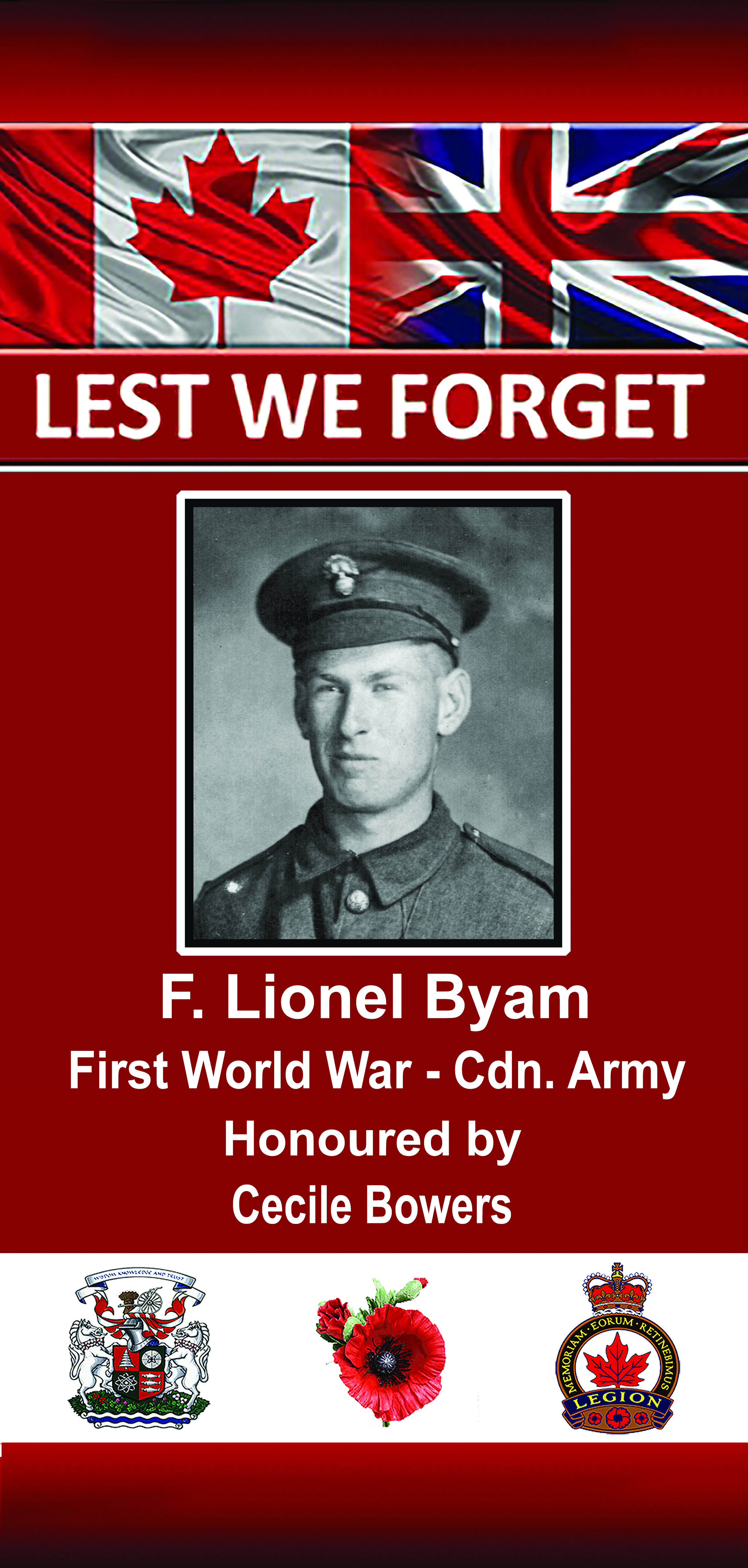 Frederick Lionel Byam, known as Lionel, was born in Tyrone, Ontario, on May 21, 1895. His parents, Frederick Gideon and Clarissa Byam, were storekeepers operating Byam’s General Store in Tyrone, which opened before 1890. As a child of shopkeepers, Lionel grew up helping around the store. He was an avid soccer player and played in the Darlington Soccer League, arguably the oldest league in Canada, founded in 1880. Frederick Lionel Byam, known as Lionel, was born in Tyrone, Ontario, on May 21, 1895. His parents, Frederick Gideon and Clarissa Byam, were storekeepers operating Byam’s General Store in Tyrone, which opened before 1890. As a child of shopkeepers, Lionel grew up helping around the store. He was an avid soccer player and played in the Darlington Soccer League, arguably the oldest league in Canada, founded in 1880.
On February 17, 1916, at 20, he enlisted for overseas service in the First World War with the 136th Battalion (Durham). Initial infantry training took place in Port Hope and Bowmanville. Lionel’s unit departed Halifax on September 27, 1916, sailing overseas to Liverpool on October 5, 1916. On December 5, 1916, Lionel was reassigned to the 87th Battalion, the Canadian Grenadier Guards. Lionel was moved forward to the trenches on February 21, 1917. At that time, his unit was located outside Arras. Less than two weeks later, he was seriously wounded after suffering three shrapnel wounds to his left arm and hand. He was evacuated to England and hospitalized for treatment and recovery but lost the index finger on his left hand. During this time, he was placed on the 23rd Canadian Reserves. In October 1917, he became an instructor at various ranges and sniping courses. He returned to the 87th on November 26, 1917, and moved to the front lines in late December, where he faced heavy fighting at the Battle of Passchendaele. On February 23, 1918, Lionel was notified that his father had died. He was granted leave on compassionate grounds and left France on March 5. Lionel was sent home to run the family business on July 3, 1918, and received his discharge from service on September 20, 1918. Lionel married Ethel Lillicrapp on October 15, 1919, and had four children. After Ethel died in 1961, Lionel married Elva Beckett in 1965 and sold the store to Clifford, his eldest son. Elva died in 1975, but Lionel carried on being very involved in Tyrone Seniors, Legion Branch 178 and especially in L.O.L. 764. He could always be found rocking on the store porch, waving, and greeting all who passed. Many from Tyrone and the surrounding area say that some families would not have survived the Depression if not for Lionel Byam's compassion. Lionel had served the Tyrone community through his general store for 50 years. The Tyrone Post Office was in the back of the store, where he was Postmaster for 44 years. Lionel died on November 24, 1982, at 87. |
| Darryl Caswell |
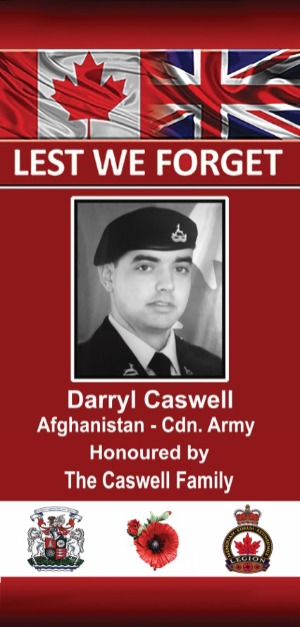 Darryl was born on July 31, 1981, in Bowmanville to Paul Caswell and Darlene Nesbitt. Growing up, Darryl wanted to try everything and got his first motorcycle at ten. He was adventurous, fearless, full of excitement and a life-long daredevil. Like so many other young men, Darryl had been a bit of a handful, but he was reasonable and appreciative. Darryl was born on July 31, 1981, in Bowmanville to Paul Caswell and Darlene Nesbitt. Growing up, Darryl wanted to try everything and got his first motorcycle at ten. He was adventurous, fearless, full of excitement and a life-long daredevil. Like so many other young men, Darryl had been a bit of a handful, but he was reasonable and appreciative.
Darryl’s parents divorced, but both remarried, giving Darryl two siblings, one in each family. The common bond for each family was Darryl. He was the cement that kept them together, and he inspired his brother and sister, who praised him. Darryl cherished his family. When he attended Bowmanville High School, Darryl was a young man of high morals, someone who chose what was suitable for him, regardless of the opinions of others. At times, this made him unreceptive to rules and authority. After high school, Darryl wanted to become a police officer and attended his first year of college before determining that it was not for him. In 2003, Darryl worked at the Goodyear plant in Bowmanville but found it mundane and left after six months. Since Darryl liked to challenge authority figures, his parents were surprised when he chose to join the Forces in September 2004. However, he embraced this new life with enthusiasm. Darryl was pleased with his decision and new responsibilities. He matured dramatically and exercised his good qualities in the military, which gave him purpose. Darryl joined the Royal Canadian Dragoons, the senior armoured regiment in the Canadian Army. Nobody was prouder to be a Dragoon than Darryl. He thrived on the camaraderie, a soldierly combination of simple affection and affectionate harassment. The Dragoons were reconnaissance and tank crews to the Canadian Task Forces that served in Afghanistan from 2002 to 2014. On June 11, 2007, Darryl travelled with a convoy carrying supplies to a forward operating base in Khakriz when a roadside bomb exploded near his vehicle and killed him. He was 25. Darryl’s high school held a special memorial ceremony in his honour and a street in Bowmanville commemorates his name. The Highway of Heroes Durham LAV Monument in Bowmanville also notes his sacrifice. It was dedicated in 2017. |
| Alexander (Alec) C. Colville |
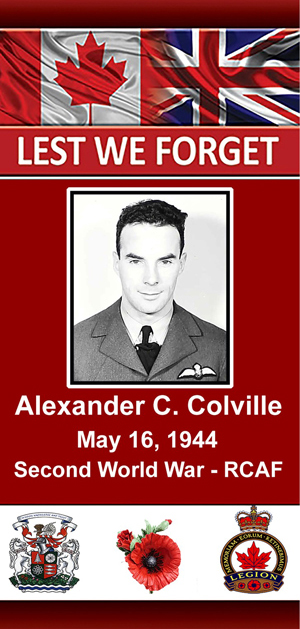 Alexander (Alec) Colville was born on September 19, 1915, to Alexander and Annie Josephine Colville. They raised five children in Bowmanville, with Alec being the eldest of three brothers. He and his brothers attended Bowmanville High School as incredible athletes, playing football and baseball and were regularly featured in the local newspaper, which covered their exploits. The Ottawa Roughriders, a CFL team, expressed interest in Alec but could not lure him away from home. Alexander (Alec) Colville was born on September 19, 1915, to Alexander and Annie Josephine Colville. They raised five children in Bowmanville, with Alec being the eldest of three brothers. He and his brothers attended Bowmanville High School as incredible athletes, playing football and baseball and were regularly featured in the local newspaper, which covered their exploits. The Ottawa Roughriders, a CFL team, expressed interest in Alec but could not lure him away from home.
After high school, Alec worked at Goodyear Tire and Rubber Company in Bowmanville. He enlisted for service in the Royal Canadian Air Force (RCAF) at 24 on September 9, 1940. Alec graduated training as a Flight Sergeant Air Gunner and was later awarded his second wing commissioned as a Pilot Officer. He was posted at bases in Canada and Newfoundland (which was not part of Canada at that time) before being shipped overseas in January 1944. Alec was assigned to the 408 “Goose” Squadron, Bomber Command and based at Linton-on-Ouse in Yorkshire in England. The 408 Squadron was created in June 1941, the second of 25 Canadian bomber squadrons overseas. Alec flew on his first bombing mission on March 7, 1944, as a co-pilot. The raids were conducted at night to hide from enemy fighter aircraft. On his third mission, Alec was the pilot of a Lancaster bomber, departing base on the evening of March 15, 1944, for Stuttgart, Germany. The official account reads: “The aircraft was reported missing on 16 March while serving overseas with 408 Squadron, and no further information having become available, he is presumed for official purposes to have died on that date.” No wreckage was found, and it was assumed his plane went down over the English Channel upon return from the sortie (mission). Other pilots on the raid reported constant harassment from enemy fighter aircraft on their return to base. They lost all seven crew members. Alec was 28. Alec’s younger brothers also served in the RCAF and died in action. Bill died on May 6, 1942, and John died on August 18, 1944. Their mother was chosen as the Silver Cross Mother in 1966, laying a wreath at the National War Memorial in Ottawa on Remembrance Day, on behalf of all mothers who lost children in military service of their nation. |
| John S. Colville |
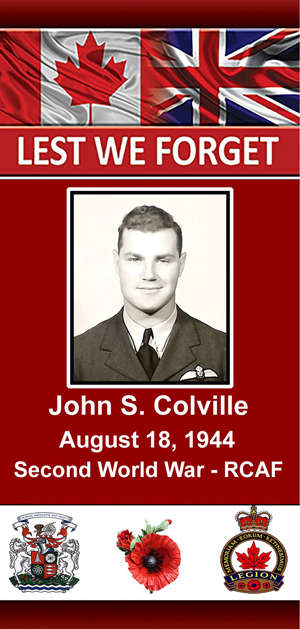 John (Sandy) Colville was born on June 21, 1920, to Alexander and Annie Josephine Colville. He was the youngest of three brothers, raised in a family of five siblings. Although his given name was John, he was known as Sandy. He attended Bowmanville High school, excelled at sports, and was named athlete of the year. In addition, he liked to fish and hunt in the Bowmanville Creek and nearby wetlands. John (Sandy) Colville was born on June 21, 1920, to Alexander and Annie Josephine Colville. He was the youngest of three brothers, raised in a family of five siblings. Although his given name was John, he was known as Sandy. He attended Bowmanville High school, excelled at sports, and was named athlete of the year. In addition, he liked to fish and hunt in the Bowmanville Creek and nearby wetlands.
Both Sandy’s older brothers, Alec and Bill, enlisted for service in the Royal Canadian Air Force (RCAF) in 1940, with Sandy following on June 6, 1942, at 21, one month after Bill died in a maritime patrol bomber crash. His mother later told a newspaper reporter that Sandy went to war to avenge the death of his brother. Sandy followed in the footsteps of his two brothers and took flight training to become a fighter pilot. Upon completion of training, he was assigned to the 440 “Beaver” Squadron. Initially, this squadron took part in defence operations in Western Canada, Alaska and the Aleutian Islands Campaign from November 1941 onward. It was relocated to an RAF base in Ayr, England, in February of 1944. It is not known when Sandy was posted to this unit, before or after relocation. On March 16, 1944, Sandy learned that his eldest brother Alec was reported missing while piloting a bomber on a raid over Stuttgart, Germany and presumed to be killed in action. The 440 Squadron was supplied with British-made Typhoon Fighter/Bombers, a very powerful dual-role aircraft that was the successor to the Spitfire and Hurricane fighters. It excelled at low altitude interception and became the most successful ground-attack aircraft. After the D-Day invasion, the 440 Squadron supported and followed the allied armies through France, Netherlands and then into Germany. Depending on the front location, their bases would be close to a field, with the men living in tents. On August 18, 1944, a flight of three Typhoons took off from their base near Orbec, France on a mission. Near the French town of Vimoutiers they attacked a convoy of ground transports. Two motorized vehicles were destroyed on a strafing run. Sandy’s fighter encountered flak as he pulled out of the dive. His aircraft went into a steep dive and crashed into an orchard. He managed to bail out of the stricken craft, but there was insufficient altitude for his parachute to open. His mother, a recent widow, lost all three sons serving in the RCAF during the Second World War. She was selected as the Silver Cross Mother in 1966, laying a wreath at the National War Memorial in Ottawa on Remembrance Day, on behalf of all mothers who lost children in the military service of their nation. |
| William (Bill) F. Colville |
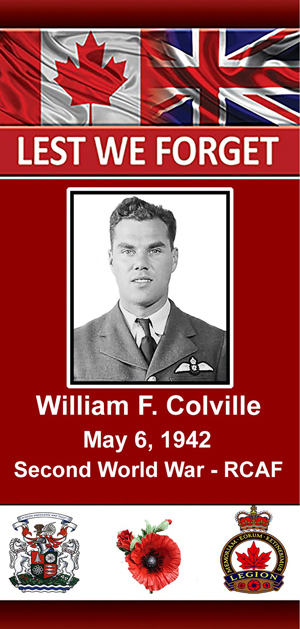 Bill was born on April 29, 1917, to Alexander and Annie Josephine Colville and was the second son of three in a family of five siblings. He was born and raised in Bowmanville, and like his brothers, he represented the town on various sports teams. Bill’s specialty was tennis, and the family would go together to watch him play. Bill was born on April 29, 1917, to Alexander and Annie Josephine Colville and was the second son of three in a family of five siblings. He was born and raised in Bowmanville, and like his brothers, he represented the town on various sports teams. Bill’s specialty was tennis, and the family would go together to watch him play.
After completing school, Bill worked at the Goodyear Tire and Rubber Company in Bowmanville but enlisted in the Royal Canadian Air Force (RCAF) on October 23, 1940, at 23. He followed in the footsteps of his older brother Alec, who had enlisted one month earlier. His younger brother, Sandy, would enlist in the RCAF a year-and-a-half later. He took flight training, a good deal of it based at the airstrip in North Oshawa. Occasionally he brought fellow trainees home for a home-cooked meal that his mother loved to prepare, and then they would gather around the piano and sing until returning to base that evening. Sometimes, when they would be flying over Bowmanville, Jo’s boys, as they were known, would tip their wings and buzz the houses. The neighbours would have fits. On April 29, 1942, Bill joined the 11 Bombing/Reconnaissance (BR) Squadron based in Dartmouth, Nova Scotia. From this base, they would fly Hudson Bombers, a refitted version of the Lockheed Electra airline, overseas to conduct anti-U-boat patrol and convoy escort. On nine different occasions, aircraft from this squadron engaged surfaced U-boats. On May 6, 1942, at 25, Bill was the co-pilot/navigator of a crew selected to ferry an aircraft from Torbay Newfoundland to Dartmouth for a maintenance inspection. Unfortunately, the plane crashed upon takeoff. The official report reads: “Killed in the crash of a Lockheed Hudson Bomber #761 during takeoff from Torbay, Newfoundland, May 6, 1942, along with seven comrades, destination Dartmouth NS.” The plane reached about 100 feet before a suspected engine failure, and it plummeted to the ground. Bill’s two brothers, Alec and Sandy, would also be killed in action in March and June of 1944. Their mother, Annie Josephine Colville, was selected as the Silver Cross Mother in 1966, laying a wreath at the National War Memorial in Ottawa on Remembrance Day, on behalf of all mothers who lost children in the military service of their nation. |
| William S. Colville |
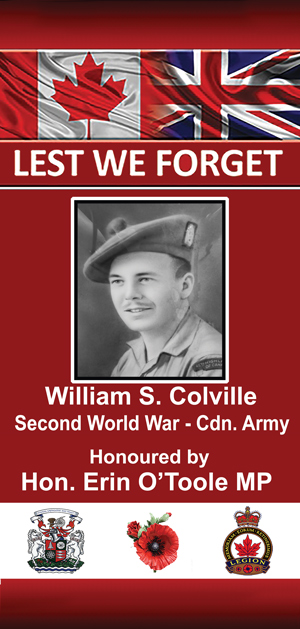 William (Bill) Colville was born on September 21, 1922, in Clarke Township, to Colin Colville and Evelyn (nee Yeo). He was raised and worked on a farm near Clarke Concession Road 7 and the Darlington/Clarke Townline with two brothers and two sisters. He attended elementary school in Orono and high school in Bowmanville and enlisted for duty on November 10, 1942, at 20. William (Bill) Colville was born on September 21, 1922, in Clarke Township, to Colin Colville and Evelyn (nee Yeo). He was raised and worked on a farm near Clarke Concession Road 7 and the Darlington/Clarke Townline with two brothers and two sisters. He attended elementary school in Orono and high school in Bowmanville and enlisted for duty on November 10, 1942, at 20.
Bill trained at Base Borden and was selected to join the 48th Highlanders, a legendary unit that has honourably served our country since 1891. He was transferred overseas to a base in Aldershot, England, in 1943 and participated in the Sicily invasion and the campaign on the Italian mainland. During this time, his unit received the following battle honours:
Bill’s war ended in December 1944 during the battle for the Lamone River crossing, where artillery shrapnel pierced one side of his body from armpit to hip. He begged for water as he lay on a stretcher, typically not given to those facing immediate surgery. He distinctly recalled one of them saying, “Give him some. He’s not going to make it.” After more than a year of mending in a Scottish facility, Bill returned home in June 1945. He worked at the local Goodyear plant in Bowmanville until he retired in 1983. Bill learned to play the bagpipes and, in 1951, was one of the founding members of the Bowmanville Legion pipe band. In 1954, he married Carol Martyn and had one son. In 1953, with assistance from the Veterans Land Act, Bill purchased two acres situated at Baseline Road and Green Road in Bowmanville and built his home. The house sits high atop a hill with a view of Lake Ontario to the south. Many years later, he watched the processions of the Canadian soldiers killed in Afghanistan. Bill worked with MP Erin O’Toole and others to create the Highway of Heroes Durham LAV Monument at Clarington Fields. Bill died on June 24, 2019. He was 97. |
| Robert J. Colwell |
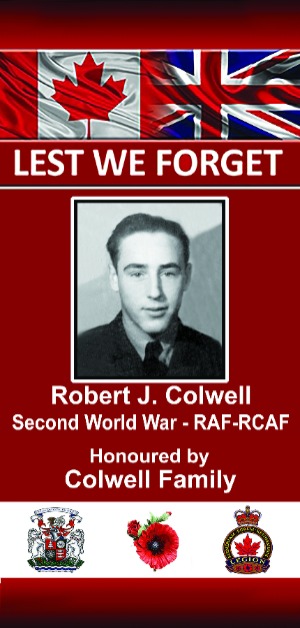 Robert (Bob) Colwell was born on August 17, 1928, in Hereford, England, to Evelyn and Reginald Colwell, a bus route inspector at the local transit authority. He had one older brother who served in the military during the Second World War and then found employment as a correctional officer. Bob’s education ended at 14, the equivalent of grade nine, which was common for most British youth. The country was at war, and although too young to serve in the military, they had to contribute locally to the defence of their communities. In 1942, Bob served with the Civil Defence Service, whose principal role was air raid precautions (ARP). Bob was one of many teenage messengers equipped with nothing more than a bicycle. German bombing raids frequently interrupted landline communications, and it was the messenger’s job to convey information from the site of bombing incidents to ARP headquarters at the Hereford police station. This information would be used to direct rescue teams, first aid, firefighting and gas decontamination. Robert (Bob) Colwell was born on August 17, 1928, in Hereford, England, to Evelyn and Reginald Colwell, a bus route inspector at the local transit authority. He had one older brother who served in the military during the Second World War and then found employment as a correctional officer. Bob’s education ended at 14, the equivalent of grade nine, which was common for most British youth. The country was at war, and although too young to serve in the military, they had to contribute locally to the defence of their communities. In 1942, Bob served with the Civil Defence Service, whose principal role was air raid precautions (ARP). Bob was one of many teenage messengers equipped with nothing more than a bicycle. German bombing raids frequently interrupted landline communications, and it was the messenger’s job to convey information from the site of bombing incidents to ARP headquarters at the Hereford police station. This information would be used to direct rescue teams, first aid, firefighting and gas decontamination.
In 1946 at 18, Bob transferred to the Royal Air Force (RAF). While in training at the RAF base in Hereford, he met Ann Weaver, the love of his life. In 1947, he was sent to the RAF base in Lubeck, Germany as a member of the British Air Forces of Occupation (BAFO) to defend the airbase and radar installations. He was demobilized in 1949 and became a police constable with the Herefordshire Constabulary for six years. He married Ann in 1951 and raised two sons. In 1956, Bob applied to and was accepted by the Royal Canadian Air Force (RCAF). The family emigrated to his new post at Camp Borden, where he served with the military police. A depot at this base had been established in 1940 to supply munitions to the various RCAF flight training locations created in Ontario and Quebec under the British Commonwealth Training Plan. At this time, the base was utilized as an explosives depot, with the military police providing the security for this function involving the defusing of old and unused munitions from the war. Bob left the RCAF in 1960, and the family settled in Bowmanville. He worked at the Bowmanville Training School, and his wife worked at the Memorial Hospital in town. His boys played hockey locally, and Bob was also involved with the teams, eventually named the Bowmanville Toros. He was also one of the founders of the local junior team, the Eagles. In 1966, and for the next 24 years, Bob worked at the Consumers Gas Company. Initially, he worked in their credit section but eventually he moved to pipeline inspection, which he preferred. Bob died in his home on February 10, 2021. He was 93. |
| Ivan Cote |
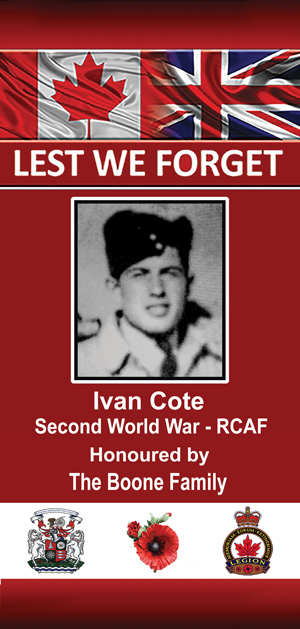 Ivan Cote was born on August 12, 1922, in Russell, Manitoba, to Winnifred and George, and had two sisters and two brothers. His father worked as a hydro lineman and later transferred to Winnipeg. After school, Ivan worked for the T. Eaton Company, first with deliveries and collections and later as a vehicle mechanic, maintaining the company’s fleet of trucks. Ivan Cote was born on August 12, 1922, in Russell, Manitoba, to Winnifred and George, and had two sisters and two brothers. His father worked as a hydro lineman and later transferred to Winnipeg. After school, Ivan worked for the T. Eaton Company, first with deliveries and collections and later as a vehicle mechanic, maintaining the company’s fleet of trucks.
Ivan enlisted for service in the Royal Canadian Air Force (RCAF) for the Second World War in 1940, at 18. He went to a training facility near St. Thomas, presumably the Ontario Police College in Aylmer. He trained to be an aircraft mechanic, including practical studies of aircraft structures, operating systems, instruments, engines, and propellers. After being shipped to England and assigned to the 409 Squadron, Ivan flew Night-Fighters, purpose-built aircraft with powerful twin-engines equipped with radar to intercept and destroy enemy bombers during the night. He worked at a few bases on the English east coast and France after the Normandy invasion. When the war ended, his squadron was on German soil in the Rhine River basin. Ivan married Joan Miller in Newcastle, England, and was demobilized in 1945. He returned to Winnipeg and found employment as a lineman with Winnipeg Electric. In 1953, he transferred to Ontario Hydro, working in Ottawa and Brockville until he retired in 1976. Ivan and his wife raised two daughters, later relocating to Whitby and then North Bay to be near his daughters. Ivan was intelligent, charming and always alert. He possessed an eclectic nature and quickly adapted to computers. In 2014, Bowmanville residents, Lindsey and Travis Boone and their two children met Ivan at a Remembrance Day ceremony in Whitby. Their daughter bestowed a homemade poppy on Ivan and had a photo taken with him at this time. They established a close friendship that remained until the day he died in September 2019. He was 97. The Boone family participates annually with remembrance activities in Clarington, assisting with the poppy campaign and placing crosses on the graves of Clarington veterans. |
| Emmett J. Crough |
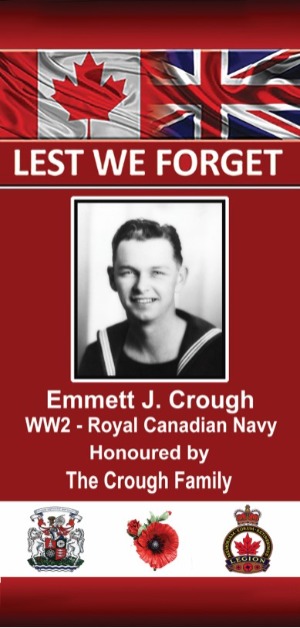 Emmett Crough was born on March 22, 1916, to Frank and Clara Crough on a farm property in Emily Township, Ontario. Emmett had seven siblings, two brothers and four sisters, who worked on the farm with their parents. He continued working on the family farm until January of 1944, when he enlisted for service in the Royal Canadian Navy. Emmett Crough was born on March 22, 1916, to Frank and Clara Crough on a farm property in Emily Township, Ontario. Emmett had seven siblings, two brothers and four sisters, who worked on the farm with their parents. He continued working on the family farm until January of 1944, when he enlisted for service in the Royal Canadian Navy.
He joined work with HMCS Annapolis, one of 50 aged American destroyers provided to the allied effort by the United States in 1940. After training, Emmett was re-assigned to the HMCS Thetford Mines, a new Canadian-built frigate. Before going overseas, he married Muriel Henry on October 10, 1944, in Peterborough. On March 7, 1945, his warship helped sink the German submarine U-1302 in St. George’s Channel. On May 11, 1945, in Northern Ireland waters, the HMCS Thetford Mines accepted the surrender of six German U-boats. Later that month, the warship was decommissioned and returned to Sydney, Nova Scotia. After escorting a convoy across the Atlantic, this warship patrolled British waters until Victory in Europe Day in May 1945. Emmett was honourably discharged on January 8, 1946, and returned to the family farm. Although he wanted to be a teacher, he joined the Ontario Provincial Police (OPP). He first served at the Peterborough detachment and was eventually transferred to the Bowmanville detachment, where he, Muriel and their three children settled. Emmett coached kids’ hockey and baseball and participated in other community volunteer work. He died on March 17, 1967, while still in service of the OPP. He was 51 years old. |
| Carl Evans Devitt |
|
On January 8, 1942, at 22, Carl enlisted for service in the Second World War. He joined the Royal Canadian Corps of Signals. Most signalers supported the army by establishing and maintaining communications between active fronts and the command areas behind the lines with landline and radio connections. However, wireless communications could also be listened to by anyone within the transmission range, which led to Carl’s role of Signals Intelligence (SIGINT). Carl learned the basics of Radio Frequency (RF) interception, directional finding to source an RF transmission, encryption techniques, decryption, decoding and methods to secure their communications. After training in B.C., he joined the #22 Special Wireless Station in Grand Prairie, Alberta. The unit used receiving towers on nearby mountaintops to intercept long-range Japanese communications in the Aleutian Islands. Carl remained in Alberta and married a local girl, Jean, before being summoned back to Victoria, BC. Carl became part of the first Canadian Special Wireless Group and found himself en route to Australia, leaving his pregnant wife in Grand Prairie. In Australia, an interception camp was set up in the northern city of Darwin. After the city was bombed by the Japanese, the inhabitants moved south out of the range of enemy aircraft, while he remained at this location for the duration of the conflict. When he returned to Canada, he and Jean settled in Bowmanville in a house on Jane Street. He returned to the Goodyear plant and had two more children. Carl enjoyed gardening and was known for his prized gladiolas. He was also involved in local hockey and was one of the founders of the Bowmanville Eagles junior hockey team. After retiring early from Goodyear, he moved to Queenston in the Niagara area, where he owned and operated a gasoline bar and variety store. After selling the store, the family moved to Fonthill, Ontario, near his oldest son. After a few years, they moved to Black Creek in Stevensville but eventually returned to Bowmanville. He died on November 16, 2003, at 84. |
| Jack Flewell |
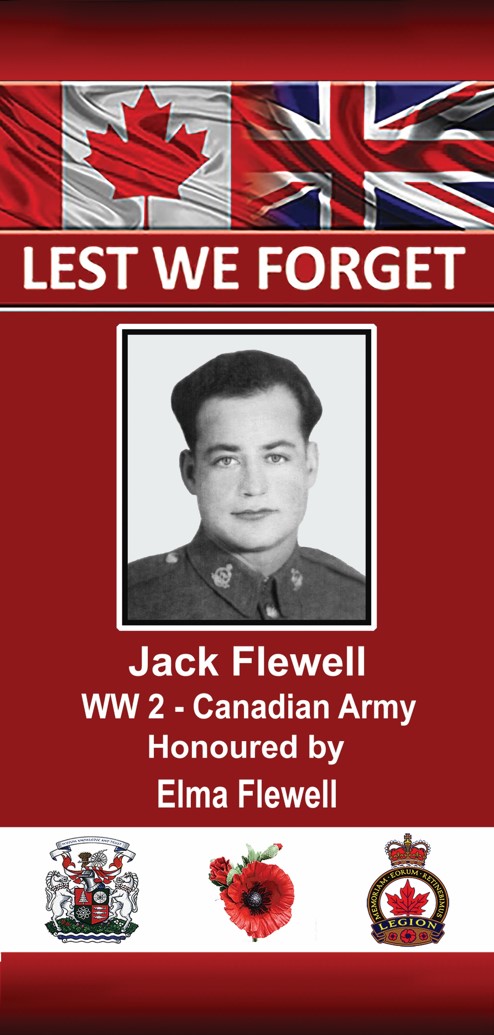 Jack was born on December 5, 1914, in Tyendinaga Township, Ontario, to John Joseph and Mary Ellen Simpson. He was the eldest child and had two younger siblings, a brother and a sister. In 1918, during the Spanish Flu Epidemic, Jack’s mother succumbed to influenza, which led to the break-up of the family. Jack and his brother went into care and became the adopted sons of Alford and Eva Flewell. The Flewell family lived on a rural property outside of Uxbridge, Ontario. There, Jack attended Sanford Public School and upon graduation, he farmed his parent’s acreage. Jack was born on December 5, 1914, in Tyendinaga Township, Ontario, to John Joseph and Mary Ellen Simpson. He was the eldest child and had two younger siblings, a brother and a sister. In 1918, during the Spanish Flu Epidemic, Jack’s mother succumbed to influenza, which led to the break-up of the family. Jack and his brother went into care and became the adopted sons of Alford and Eva Flewell. The Flewell family lived on a rural property outside of Uxbridge, Ontario. There, Jack attended Sanford Public School and upon graduation, he farmed his parent’s acreage.On September 9, 1939, eight days after Germany’s invasion of Poland, the Canadian Parliament declared war. Jack, at the age of 25, had enlisted three days before. He was assigned to the Ontario Regiment headquartered in Oshawa, an armoured unit, and his first post was at Camp Borden for training. For some time, he was stationed at Espanola, Ontario, guarding German prisoners of war. On June 29, 1940, he married his childhood sweetheart, Elma Marion Vance, and their firstborn arrived in April 1941. In June of 1941, Jack’s unit was shipped overseas from Halifax, arriving in Greenock, Scotland, on July 1. The unit trained at Headley Downs in England and was then assigned defensive roles on the English coast at Shermanbury and Brighton. The unit was then selected to participate in Operation Husky, the invasion of Sicily. On July 13, 1943, they disembarked on the southeast coast of the island near the town of Syracusa as part of the First Canadian Tank Brigade, then moved to a harbour area near Cassibile. Now part of the British 8th Army Reserve, they patrolled the coast and then moved inland near Scordia to support infantry units to the east and west. They fought their way north along the coast, clearing the way for British and American troops to capture Messina, liberating Sicily in only seven weeks. On September 3, 1943, the unit was repatriated to the First Canadian Corps, 11th Army Tank Brigade. They crossed the Straits of Messina, capturing the town of Reggio in Italy. For the following 18 months, including two winter seasons, Jack’s unit was part of the allied push northward on the Italian peninsula. The fighting was fierce, and the unit engaged in major battles in Monte Cassino, Ortona and the Liri Valley. On May 19, 1944, at Monte Cassino, Jack’s tank was hit by enemy fire, and he suffered both physical and mental trauma. Nevertheless, he returned to active duty. His unit ended participation in Italy in February of 1945 when they were transferred to the fronts in Northwest Europe. In total, the Ontario Regiment garnered sixteen battle honours in Sicily and Italy. Jack would have been involved in most, if not all, of these actions. In March 1945, they joined the drive into the Netherlands and Germany, where they remained until the end of the war. Jack’s unit fought with distinction in the Dutch campaign, picking up another battle honour at Arnhem, Holland. Upon demobilization, Jack returned home to his family. They settled in Scott Township, where they purchased a farm. By 1954, Jack had three more children, and the family relocated to Oshawa in 1958, where he found employment with the Ontario County Board of Education. He retired in 1972 due to his poor health. He was a member of the Royal Canadian Legion and St. Luke Presbyterian Church in Oshawa. Jack died on December 25, 1978. He is survived by his wife Elma of 36 years, who presently lives at Bowmanville Creek Senior’s Residence and turned 100 in 2022. |
| Stewart A. E. Fuller |
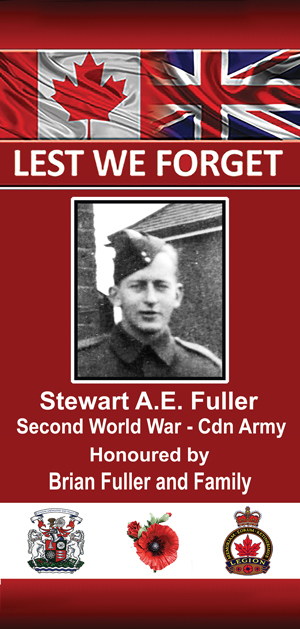 Stewart Fuller was born on December 9, 1916, in Kent, England, to Ernest and Nora Hogg. He was the youngest in a family with four sisters. In the aftermath of the First World War and hardships in England, the British economy made it impossible for many to raise their children. The practice of sending poor or orphaned children to Canada, known as British Home Children, had been long established since the 1800s and continued into the 1930s. Stewart Fuller was born on December 9, 1916, in Kent, England, to Ernest and Nora Hogg. He was the youngest in a family with four sisters. In the aftermath of the First World War and hardships in England, the British economy made it impossible for many to raise their children. The practice of sending poor or orphaned children to Canada, known as British Home Children, had been long established since the 1800s and continued into the 1930s.
In 1941, at 25, Stewart enlisted with the Canadian Army to serve in the Second World War. His background in telecommunications may have played a role in his assignment to the Royal Canadian Corps of Signals. The job of the Signal Corps was to create and manage communications and information systems for the combined arms forces, naval and air force, and the army. Communications technology had significantly advanced since the First World War, particularly radio frequency (RF) transmissions, which became necessary with the combat mobility brought about by armoured units. However, laying landlines was always preferred because messages could not be intercepted, unlike radio frequencies. Technicians had to be very adept at both. Stewart trained in England with a joint assault signal company specializing in linking land, sea and air operational elements. Once ashore in enemy territory, they supported the army’s advances with communications links between the fronts and command posts in the rear. He saw action in North Africa, Sicily and Italy, and again until the end of the Second World War in Northwestern Europe. In 1920, Stewart and three of his sisters were sent to Canada. William and Anne Fuller took in Stewart and one of his sisters. Stewart graduated at the height of the depression and took jobs where he could find them. He married Ellen Temple on April 30, 1938, and raised two children. In 1940, Stewart found employment with Northern Electric, a subsidiary of the Bell Telephone Company that manufactured and installed automated switching equipment. After demobilization, Stewart returned to Scarborough and his employment at Northern Electric. With his experience in RF, he took up amateur radio as a hobby. He retired in 1976 and moved first to Hastings, and then Campbellford. He died in 2006. He was 89. Stewart’s son, a granddaughter and three great grandchildren are long-time residents of Bowmanville. |
| James Geddes |
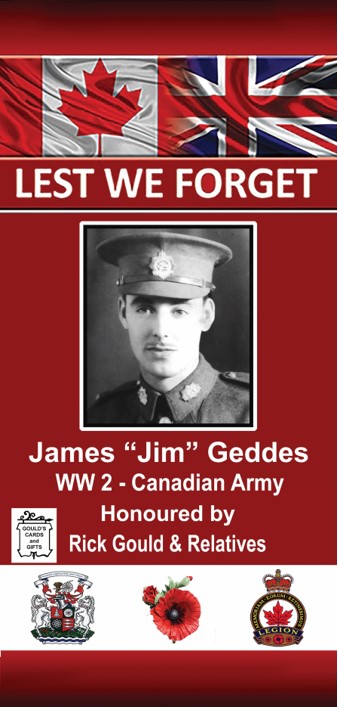 James (Jim) Geddes was born on April 13, 1918, the fifth born of Patrick James Sinclair and Jean Connor (nee Stephens) Geddes. They resided on a property near Newcastle, all the children attending SS#9, a rural schoolhouse situated on Lockhart Rd. between the 3rd an 4th Concessions of Clarke Township. Jim, as well as other family members, worked at Gibson Orchards. He, and his older brother Jack, would get around on motorcycles, but they both eventually found employment at the Goodyear plant in Bowmanville. They both enlisted for WW2 service in October of 1939, Jim being 21 years of age at the time. He was assigned to the Midland Regiment, initially posted to guard the RCAF base in Trenton. On leave, he returned home and married Margaret Christina Colliss on April 19, 1940. Their first son would be born one year later in April of 1941. James (Jim) Geddes was born on April 13, 1918, the fifth born of Patrick James Sinclair and Jean Connor (nee Stephens) Geddes. They resided on a property near Newcastle, all the children attending SS#9, a rural schoolhouse situated on Lockhart Rd. between the 3rd an 4th Concessions of Clarke Township. Jim, as well as other family members, worked at Gibson Orchards. He, and his older brother Jack, would get around on motorcycles, but they both eventually found employment at the Goodyear plant in Bowmanville. They both enlisted for WW2 service in October of 1939, Jim being 21 years of age at the time. He was assigned to the Midland Regiment, initially posted to guard the RCAF base in Trenton. On leave, he returned home and married Margaret Christina Colliss on April 19, 1940. Their first son would be born one year later in April of 1941.
In Trenton, Jim was trained as a combat instructor. The Midland Regiment, as a unit, never served overseas during WW2. Principally, the unit served as a recruitment tool, training volunteers from the area Counties of Durham, Northumberland, Peterborough, Victoria and Haliburton. After basic training, the majority of these recruits went on to serve in active overseas units. Jim would have been part of this regimen of training recruits prior to them being transferred to other units and shipped out. Fifty of these recruits were assigned to the Royal Rifles of Canada that were sent to defend Hong Kong from the Japanese in early 1942, in hindsight described as a suicide mission. All of them were either killed in action or spent the remainder of their service in brutal Japanese POW camps, where several more of them died. Four members of the Midland Regiment served in the Devil’s Brigade, an allied combination of Canadian and American troops, renowned for their actions in Italy. In total, the Regiment reinforced twelve different Canadian units with approximately 1,700 local volunteers. About 600 other recruits remained with the Regiment, assigned to protect Canadian infrastructure, coastlines and other in-country duties. Jim was one of these, he remained at Trenton training infantry tactics. Jim was demobilized on October 2, 1945. He returned to his employment at Goodyear, the family settling in a residence on Brown St. in Bowmanville. With the assistance of a loan pursuant to the Veterans Land Act, a new dwelling was built for the family on Maple Grove Rd. The family expanded by two more children, Jim eventually finding new employment in 1952 at General Motors in Oshawa. He retired from this in September of 1982 after thirty years. Jim passed away on May 11, 1990 at the age of 72 years. |
| John Geddes |
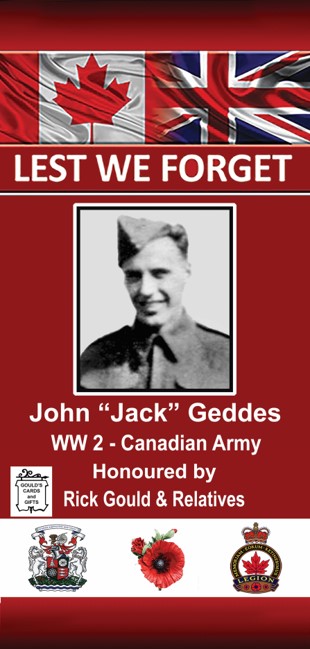 John Geddes, known to one and all as “Jack”, was born along with a twin sister in the year 1917, to Patrick James and Jean Connor (nee Stephens) Geddes of Newcastle. He was raised in a family of five siblings in Newcastle. They all attended SS#9, a one-room schoolhouse situated on Lockhart Rd. between the 3rd and 4th Concessions of Clarke Township. He went on to work at the local Gibson Orchards, eventually finding employment at the Goodyear plant in Bowmanville. At 22 years of age, he enlisted for WW2 service in October of 1939, assigned to the Midland Regiment, initially posted to guard the RCAF base at Trenton. However, prior to enlistment, he had been married to Helena Barrett. John Geddes, known to one and all as “Jack”, was born along with a twin sister in the year 1917, to Patrick James and Jean Connor (nee Stephens) Geddes of Newcastle. He was raised in a family of five siblings in Newcastle. They all attended SS#9, a one-room schoolhouse situated on Lockhart Rd. between the 3rd and 4th Concessions of Clarke Township. He went on to work at the local Gibson Orchards, eventually finding employment at the Goodyear plant in Bowmanville. At 22 years of age, he enlisted for WW2 service in October of 1939, assigned to the Midland Regiment, initially posted to guard the RCAF base at Trenton. However, prior to enlistment, he had been married to Helena Barrett.
The Midland Regiment has historic connections with Durham and Northumberland Counties. In 1812, several local residents helped comprise the York Volunteers fighting the American invasions, a few of them captured in the raid on Fort York (Toronto) in 1813. Again, they were utilized in the suppression of the 1837 Mackenzie Rebellion in Toronto. They were acknowledged as a local militia in 1866 (40th Northumberland Battalion) with members serving in domestic actions against the Fenian Raids and the Northwest Rebellion. A number of officers and other ranks served with The Royal Canadian Regiment in South Africa during the Boer War. The Regiment contributed to a number of battalions of the CEF during WW1, including the 2nd, 39th, 77th, 139th, 155th, 235th and 254th Battalions. WW2 service saw elements of the unit called out on active service as part of the general call-out on 26 August 1939 to guard vulnerable points across Canada. They were initially tasked with security of the RCAF Airdrome at Trenton and the Dominion Arsenal at Lindsay. On 20 July 1940, an active battalion of the regiment was mobilized and by 12 August 1940 had recruited to full strength. The unit trained locally, and troops were billeted in civilian housing. Battalion headquarters was located at Millbrook and moved to Cobourg. In WW2, the unit basically served as a repository for local recruits, expanding to include the Counties of Victoria, Peterborough and Haliburton. The vast majority of these recruits were trained and then transferred to one of twelve different active overseas units, serving in Italy, Northwest Europe and Hong Kong. Those who were not transferred were utilized to guard domestic infrastructure and coastlines. The domestic battalion served in Ottawa, St. John, Niagara, Prince Rupert and at various locations on Vancouver Island. Jack Reddes was one of these individuals. Jack would have served at a few of these locations during his service. He was demobilized in October of 1945 and returned to his employment in Bowmanville at Goodyear. His wife Helena had also worked in the plant during the war. With a loan pursuant to the Veterans Land Act, the couple had a house built in a new Bowmanville subdivision on Jane St. He continued to work at Goodyear until retirement. He enjoyed bowling and was a member of the local Branch 178, Royal Canadian Legion. Jack passed away in 1979 at the age of 62 years. |
| John Frederick Gibbs |
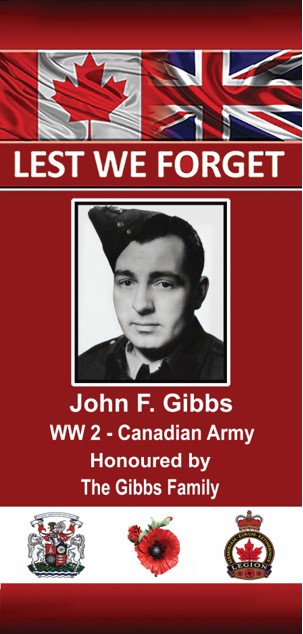
John Frederick Gibbs “Jack” was born in Tyrone, Ontario on January 17, 1916 to Thomas and Clara Gibbs, their third child. At this time his father had already volunteered for service in WW1, departing Canada with the 136th Battalion in September of 1916. Clara raised the three children alone until Thomas returned in January of 1919. The family relocated to Cartwright Township for a short period of time, before purchasing a farm property near Tyrone later that year. Jack was educated locally but was forced to leave school at 13 years of age, the start of the Great Depression, working on local farms for food and lodging. In 1933, he found employment with Goodyear in Bowmanville. Canada declared war on Germany on September 10, 1939. Jack then hitch-hiked to Hamilton, Ontario to join the first Canadian unit destined to deploy overseas, one week later on September 16th. This was the 5th Field Ambulance of the Royal Canadian Army Medical Corps (RCAMC). After local training, they arrived in the UK on December 30th and were stationed near the town of Aldershot. The fall of France occurred in the summer of 1940, Jack’s unit being transported to the south of England to treat casualties from the Dunkirk evacuation. For the next three years the unit remained in southern parts of England treating casualties from locales that were continually subjected to German air raids. During this period of time, he had met Margaret Alice McCarthy “Meg”, who was serving, like many other British women, in the Auxiliary Territorial Service. They married on April 21, 1943 in Manchester. In May 1943, the whole unit was moved to the commando assault and landing training courses at Inveraray, Loch Fyne, Scotland. Training was vigorous, there was a lot of practice in evacuating casualties from the beaches onto hospital ships. This was preparation for Operation Husky, the invasion of Sicily. They went ashore on July 9, 1943 backing up the troops of the 1st Canadian Infantry Division. The job of field ambulance personnel is to hastily evacuate the battle wounded to a regimental aid post or casualty clearing post for treatment, an evacuation chain constantly exposing them to enemy fire with little or no protection. The advance through Sicily was rapid, concluding by mid August of 1943. On September 3rd, the unit crossed the Straits of Messina onto the Italian mainland. Jack’s unit was involved in fierce fighting at Ortona in January of 1944, and again in the Liri Valley in June of that year. The longest sustained battle occurred at Rimini in August and September of 1944. The last Italian action his unit supported was a battle for the city of Ravenna, which was concluded in December of 1944. In February of 1945, the Canadian Corps started to move their troops to northwest Europe. The 5th Field Ambulance embarked on troop transport ships on March 7, 1945, debarking in Marseilles, France, eventually joining the push to liberate Holland. During three days in April of 1945, they were involved in a hotly contested action for the capture of the Dutch town of Apeldoom. Jack’s discharge from service occurred on August 2, 1945. He returned to Tyrone and his employment at Goodyear, eventually becoming a supervisor. Meg followed in 1946, they raised three sons together. Locally, Jack was known as a stalwart of the Tyrone community. If a family was in trouble, it was Jack Gibbs spearheading the drive to provide the help required. In addition he spent years as a school and town hall trustee, was involved in minor hockey and a member of the local Legion branch. He was ill during the last five years of his life, but never stopped helping out or retiring from his employment. He died on January 2, 1979 in his 63rd year. |
| Margaret Alice Gibbs |
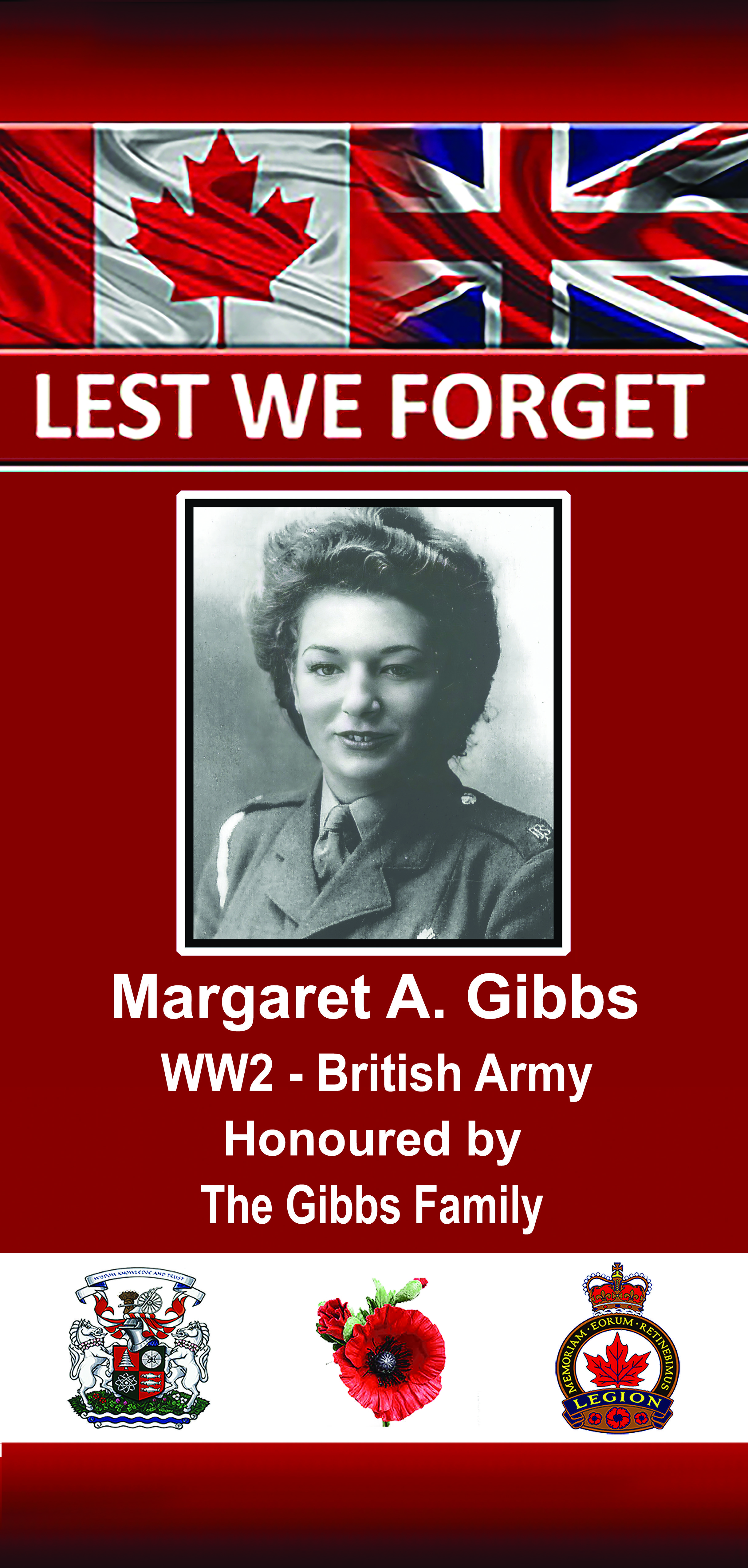 Margaret Alice Gibbs “Meg” was born on February 21, 1921 to Henry and Margaret McCarthy of Manchester, England. She was the youngest of six children, having two brothers and three sisters. Her parents had emigrated from Ireland and as such she and her siblings were subject to prejudice and bullying on a constant basis. She did not tolerate this type of behavior in anyone and as the story goes, she became very feisty, always ready to come to the aid of her brothers and sisters despite being the youngest. Margaret Alice Gibbs “Meg” was born on February 21, 1921 to Henry and Margaret McCarthy of Manchester, England. She was the youngest of six children, having two brothers and three sisters. Her parents had emigrated from Ireland and as such she and her siblings were subject to prejudice and bullying on a constant basis. She did not tolerate this type of behavior in anyone and as the story goes, she became very feisty, always ready to come to the aid of her brothers and sisters despite being the youngest.
Meg enlisted for service with the Auxiliary Territorial Service (ATS) on July 3, 1942 at the age of 21 years. The ATS was the women’s branch of the British Army during WW2, strictly a voluntary service. Initially the ATS worked supporting the war effort at a variety of jobs such as cooks, clerks and storekeepers. In 1941, the duties of the members kept expanding, orderlies, drivers, ammunition inspectors, Queen Elizabeth as a princess was a vehicle mechanic. They were barred from serving in battle but due to shortages of men, took over many support tasks such as forming part of the crews of anti-aircraft gun batteries, searchlight regiments and the military police. Meg was to be trained as a radar operator. Radar, at this time, was relatively a new technology of radio-based detection, but greatly influenced many important aspects of WW2 and becoming fully integrated as part of the national air defence. Operators were employed to detect attacking enemy bomber formations and direct interceptors to them. The learning curve was huge. The radio frequency (RF) output was read on an oscilloscope, a return from an aircraft appearing as a spike on the display. By rotating the receiver goniometer connected to the antennas, the operator could estimate the direction to the target, while the height of the vertical displacement indicated formation size. By comparing the strengths returned from the various antennas up the tower, altitude could be gauged with some accuracy. An understanding of RF was critical as differing frequencies were utilized for ranges close to the English coast as opposed to longer ranges extending over the European coast. Sector stations were able to vector fighter interceptors, often in smaller numbers, allowing the husbanding of resources, both human and material, and only needing to scramble when attack was imminent. This greatly reduced pilot and aircraft fatigue and was critical in enabling the RAF to defeat the much larger Luftwaffe forces. On top of this, frequent upgrades to the system required frequent relearning. In the last few months of the war, their job became even more complicated tracking the V-1 and V-2 missiles that Germany was utilizing. Needless to say, this was a lot of responsibility placed on young women having no background whatsoever in this new field of electronics. Although a serious occupation, Meg did find time for enjoyment. She met a young Canadian soldier, John Frederick Gibbs “Jack”, the two of them eventually marrying on April 21, 1943 in Manchester. He would soon depart for service in Italy. She was discharged from service on July 19, 1945. She emigrated to Canada in 1946, joining her husband in Tyrone, and together they would raise three boys. Meg died on July 4, 2003 in her 83rd year. |
| Thomas Henry Gibbs |
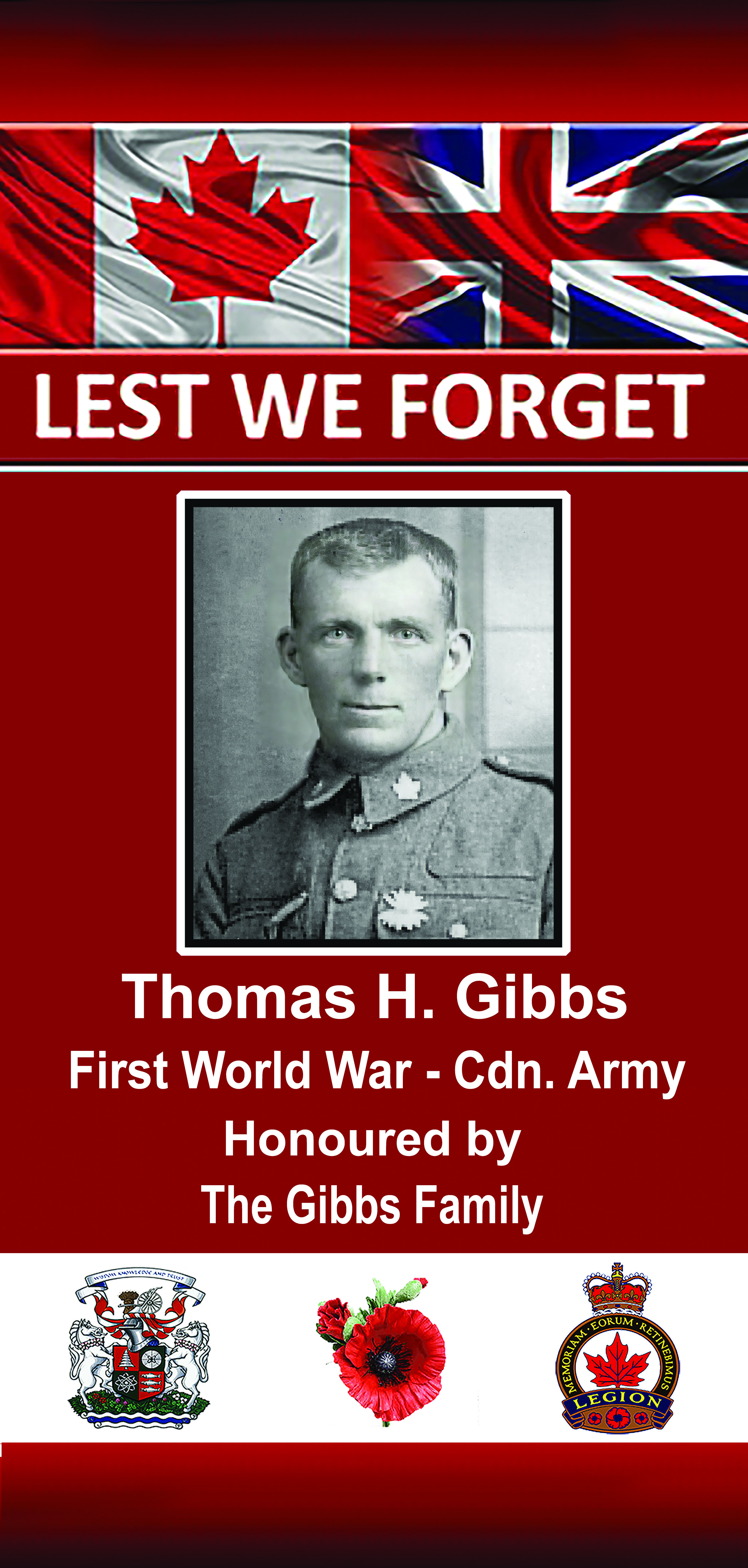 Thomas Henry Gibbs was born on March 18, 1886 in Exmouth, Devonshire, England to Charles and Charlotte Gibbs. There’s little information regarding his English upbringing, but the family totaled seven siblings, he had three sisters and three brothers. On October 19, 1907 he was married to Clara Alice Crowhurst. With two young children in tow, the family emigrated to Canada in 1914, working on farms in the area of Tyrone. Thomas Henry Gibbs was born on March 18, 1886 in Exmouth, Devonshire, England to Charles and Charlotte Gibbs. There’s little information regarding his English upbringing, but the family totaled seven siblings, he had three sisters and three brothers. On October 19, 1907 he was married to Clara Alice Crowhurst. With two young children in tow, the family emigrated to Canada in 1914, working on farms in the area of Tyrone.
Tom enlisted for service in WW1 in Bowmanville on January 15, 1916. At this time he was 29 years of age, listed his occupation as a farmer, he and Clara now had three children. Their youngest was aged six months, John Frederick Gibbs, and he would eventually serve in WW2. Tom signed on with the 136th (Durham) Battalion, the regiment that most local men joined. Initial training took place locally, then at other bases in Canada, eventually being transported to England, arriving on October 6, 1916. In England, his unit was merged with the 39th Battalion (Eastern Ontario), the forerunner of the present day Hastings and Prince Edward Regiment based in Belleville, Ontario. Further infantry training occurred at two British Army Camps on the south coast of England, Seaford and Shorncliffe as part of the 6th Canadian Reserve Battalion. Each reserve battalion was composed of men from the same military district in Canada and the battalion reinforced infantry battalions in France which had been mobilized in the same military district. On March 19, 1917 he was reassigned to the 21st Battalion, a unit that is perpetuated by the present day Princess of Wales’ Own Regiment based in Kingston, Ontario. He arrived in France on March 20th, this front line unit then preparing for the assault on Vimy Ridge. This battle took place between April 9 – 12, 1917 with the 21st in the thick of things, suffering many casualties. On May 8, 1917, Tom was seriously wounded, a gun shot wound to his right hand, arm, shoulder and head. This occurred near the French community of Thélus, about four kilometres from Vimy. Initially treated at a field hospital, he was evacuated back to the army camp at Seaford on May 17th. What followed was more than a year of treatment and rehabilitation at various recovery facilities in England. On August 8, 1918, he was involved in physical training at Seaford when he suffered a left leg fracture. His war was over. He arrived back in Canada on January 30, 1919 and was discharged from service on February 17th. Upon return from overseas, the family moved into Cartwright Township for a short period of time, then purchased a farm property near Tyrone. A fourth child was added to the family. Tom and Clara lived on and worked the farm until 1968, when they took up residence at the Golden Plough Lodge in Cobourg, a long term care facility. Tom passed away on March 11, 1969 in his 83rd year. Clara lived on to her 90th year, passing away in 1976. |
| Frederick W. Gibson |
|
Frederick William Gibson was born to David James and Mary V. 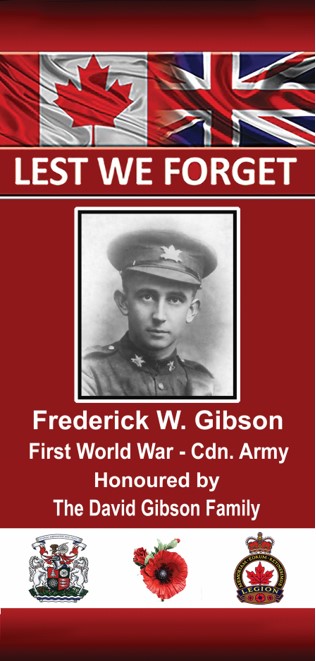 Gibson on January 7, 1894. They farmed outside Newcastle, Ontario, where he was raised with three sisters and two brothers. Gibson on January 7, 1894. They farmed outside Newcastle, Ontario, where he was raised with three sisters and two brothers.
He was educated at SS #9, a local rural schoolhouse. On February 11, 1916, at 22, Fred enlisted for service in the First World War. He had already served a year with the 46th Durham Regiment in what was then known as a militia unit, like present-day reserve units. He was accepted and sworn to duty on February 29, 1916, and assigned to the 136th Overseas Battalion of the Canadian Expeditionary Force. The regiment sailed from Halifax on September 25, 1916, debarking at Liverpool, England. On October 7, the 136th was absorbed by the 39th Eastern Ontario Battalion, forming part of the 6th Reserve Battalion while in the UK. Fred was earmarked for the machine gun corps, which were large field weapons, belt-driven and requiring at least two men to operate. Their principal mission was defensive entrenchment, protecting their lines, and supporting infantry advances. Hauling the heavy weapon from the trenches onto the battlefield and setting up a position to fire from was a difficult burden. After a brief stay at Shorncliffe, a staging base for transport over the Channel, Fred arrived in France on May 12, 1917. By this time, all the Canadian troops had been consolidated under the commander, Canadian General Arthur Currie, fresh from their success at Vimy Ridge a month earlier. At a military base in Camiers, France, Fred was assigned to the 12th Machine Gun Company. These Companies were units attached to the Brigade with the same numeric designation, in this instance, the 12th Infantry Brigade of the CEF. He joined this brigade in the field on June 11, 1917. Fred was rotated between the trenches, spending four to six days in the front trenches before moving back and spending an equal number of days in the secondary and, finally, the reserve trenches, providing a break from combat stress. In August of 1917, British Forces initiated the Third Battle of Ypres, the attack on Passchendaele Ridge in the Flemish region of Belgium. They made little headway for more than two months due to stubborn enemy defences and inclement weather. In October, it was decided to bring in the Canadian Corps under General Currie. The assault began on October 26, 1917. Fred suffered shrapnel wounds to his right hip and left ankle and was evacuated for treatment on that day. In what is known as “bite and hold” tactics, Canadian troops advanced only a few hundred yards each day. They finally seized the ridge and the town of Passchendaele on November 10, 1917, but at a considerable cost of 6,040 casualties, including Fred Gibson. He died from his wounds at Casualty Clearing Station #44 on November 1, 1917. He was only 23. |
| George Grady |
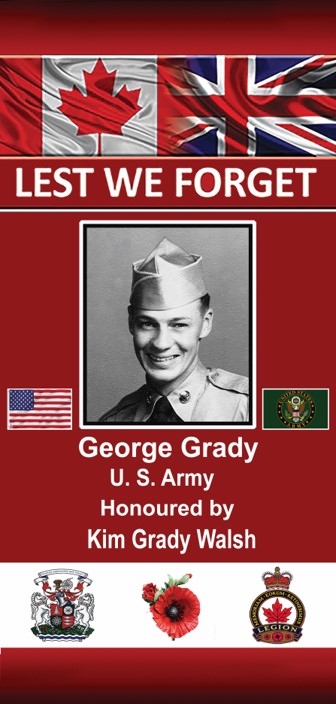
Charles George Grady, known as George, was born on March 1, 1929, in Hamilton, Ontario. He was one of seven children born to John Earle, a supervisor at Stelco Steel, and Mary Lulu Grady, a nurse. Mary’s maiden name was Armstrong, and her parents were the original owners of Armstrong’s grocery store in Orono. Although George’s parents had settled in Hamilton to raise their family, their connection to Orono was strong. George and his siblings spent many holidays and summers at their grandparent’s home in Orono with their cousins. All four Grady brothers worked in their grandparent’s grocery store. After his father’s death, George’s mother returned to Orono to live with her sister. The home in Orono became a familiar gathering spot for her grown children and numerous grandchildren to spend time together. Three of George’s brothers enlisted and served with the Canadian Forces in the Second World War, and his oldest brother, John, was killed in action. At the time, George was too young to enlist. He completed high school and, in about 1950, enrolled at Ryerson Institute of Technology in Toronto, completing a course in electrical engineering. On October 3, 1953, George married his childhood sweetheart, Valerie Ann Lounsbury, and the couple moved to the United States. George enlisted with the United States Army in late 1953. He was assigned to Fort Dix near Trenton, New Jersey. This base was a vast military complex established as a readiness centre and a jumping-off point for troops crossing the Atlantic to war or staffing U.S. bases in Europe. It was also a basic training centre for infantry personnel. In total, George spent two years serving at Fort Dix, the home base for the 9th Infantry Division, U.S. Army, where he was involved in training recruits and reservists. Infantry tactics had dramatically changed after the Second World War, and the “foot soldier” now had to be taught the new battlefield realities, mechanization, infantry fighting vehicles, amphibious seaborne assaults, airborne assaults, communications, etc. In 1955, George attended the University of Missouri, Science and Technology. He graduated as a metallurgical engineer, which is an engineer who specializes in the development, processing, and testing of metals, often working in the industrial sector for manufacturing firms, foundries, mining companies and scientific organizations. George worked in several foundries, first at Dunkirk, New York, then in 1961, he moved to a foundry in Latrobe, Pennsylvania and in 1966 to another in Warren, Pennsylvania. Finally, in 1968, he moved to Ligonier, Pennsylvania, where he worked as a consultant for a firm based in New York City until he retired in 1985. George and Valerie raised two daughters and a son. In retirement, they settled in Cranberry, Pennsylvania, just outside of Pittsburgh. He was an avid golfer, and the family spent time on a property they owned in Florida. George died in 2004 at 76. |
| John Bruce Grady |
|
When the war came in 1939, John enlisted with the Royal Canadian Air Force (RCAF) and was eventually posted in England. He worked as a navigator based out of Tempsford in Bedfordshire. He was a member of one of two “Moonlight Squadrons,” a top-secret ops mission of the British Air Force. They were also known as “Churchill’s Secret Army.” Flying black-painted Halifax bombers, these squadrons helped collect vital and covert information that led to some of the war’s most significant victories and aided a network of resistance movements across Europe. Their missions involved dropping off secret agents, weapons and much-needed supplies, including ammunition, explosives, clothes and typewriter ribbons. The squadron flew mainly on moonlit nights, guided only by local landmarks while flying low to the ground to evade radar detection. Landings were often conducted into small fields with the assistance of the resistance using only the smallest of lights. The squadron stayed on the ground for the briefest time needed to drop off supplies. They occasionally picked up downed allied airmen, who had been assisted by resistance organizations to escape capture and delivered them back to England. In the overnight hours of August 8, 1944, John and his crew took off for what would be their final mission. Southeast of Paris, their bomber was detected and hit by enemy fire. Their cargo that night was explosives for a resistance organization near the village of Cugny. Upon crashing, the aircraft exploded, killing all crew members. Although the Normandy invasion had already taken place in territory occupied by German troops, the writing was on the wall with allied advances. The villagers of Cugny, no longer fearful of the Gestapo, pulled the crew’s remains from the wreckage. Though Nazi occupiers forbade it, the villagers are believed to have conducted a small funeral and buried the remains of the seven in the village cemetery. John was 26 when he died. The French Committee of National Liberation awarded the Resistance Medal to recognize remarkable acts of faith and courage that contributed to the resistance of the French people against the enemy and its accomplices. The medals ceased to be awarded after 1947; however, in August 2019, to commemorate the 75th anniversary of their deaths, the Resistance Medal was awarded posthumously to all seven crew members, including John. |
| William Armstrong Grady |
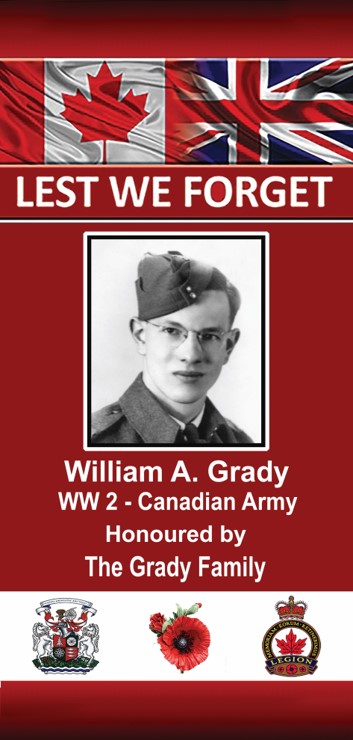 William (Bill) Grady was born on April 11, 1920, in Hamilton, Ontario, to John Earle, a supervisor at Stelco Steel, and Mary Lulu Grady, a nurse. Mary’s maiden name was Armstrong, and her parents were the original owners of Armstrong’s grocery store in Orono. John Earle, originally from Alberta, had met Mary while surveying for the rail line that would eventually come through Orono. The two married and settled in Hamilton, where they raised seven children. Bill was the third child of four boys and three girls. He was raised and went to school in Hamilton, but he and his siblings spent many holidays and summers at their grandparent’s home in Orono with their cousins. After Bill’s grandfather died, his older brother John moved to Orono at 13 to help his grandmother run the grocery store. William (Bill) Grady was born on April 11, 1920, in Hamilton, Ontario, to John Earle, a supervisor at Stelco Steel, and Mary Lulu Grady, a nurse. Mary’s maiden name was Armstrong, and her parents were the original owners of Armstrong’s grocery store in Orono. John Earle, originally from Alberta, had met Mary while surveying for the rail line that would eventually come through Orono. The two married and settled in Hamilton, where they raised seven children. Bill was the third child of four boys and three girls. He was raised and went to school in Hamilton, but he and his siblings spent many holidays and summers at their grandparent’s home in Orono with their cousins. After Bill’s grandfather died, his older brother John moved to Orono at 13 to help his grandmother run the grocery store.
In March 1942, Bill enlisted in the Second World War. His first choice was the Royal Canadian Air Force (RCAF), but instead, he joined Canadian Army and was assigned to the Royal Canadian Engineers. The role of that branch was to conduct combat operations using demolitions and land mines, designing, constructing and maintaining defensive works and fortifications, urban operations (hostile room entry), breaching obstacles, establishing and maintaining lines of communication, and bridging. In total, there are approximately sixteen specialties performed by engineering personnel. They were divided into field companies supporting various front-line infantry and armoured brigades. Part of Bill’s responsibilities was inspecting damaged or captured enemy artillery and examining for weaknesses in design and other vulnerabilities. Bill trained in Kingston and said it took two weeks to travel to England. He likely went ashore in France on D-Day minus two, with a field company seeing action as part of the Second Canadian Division fighting in Northwest Europe until the end of the conflict in May 1945. He and his brother John would take their leaves together and travel to Scotland to go salmon fishing. Bill was severely injured in France when a bomb hit a jeep, leaving him deaf and with two fractured legs. He recuperated at a facility in Northern Ireland. Bill was decommissioned in December 1945. He travelled home on the Queen Mary to New York City and then by train to Toronto. His legs had healed, but his hearing loss remained. Upon returning home, Bill and his younger brother Harry, a Second World War Canadian Navy veteran, looked after one of their grandparent’s orchards on the 6th Concession north of Orono. In 1947, Bill married Ruth Goode, and they raised four children. He was employed at General Motors and worked for 25 years as a supervisor in the truck plant. After retirement, Bill became a real estate agent for a few years and volunteered his time on the Orono Town Hall Historical Board. He was always helping others and was known for his wicked sense of humour. He died on June 27, 1999, at 79. |
| Robert James Hackett |
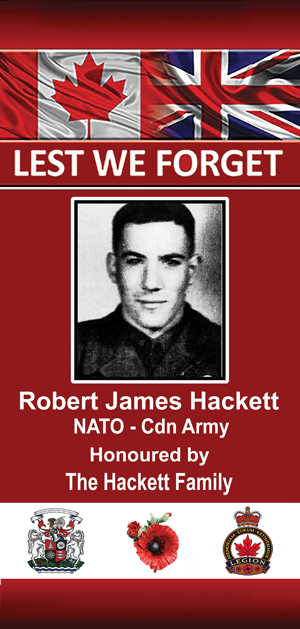 Robert (Bob) Hackett was born on April 30, 1937, in Verdun, Quebec, now part of Montreal. He was one of three children raised by Annie and Joseph Hackett, a delivery driver for Prudential Coal Company. Upon leaving school, he worked briefly as a shunt driver in the local CPR rail yard. Robert (Bob) Hackett was born on April 30, 1937, in Verdun, Quebec, now part of Montreal. He was one of three children raised by Annie and Joseph Hackett, a delivery driver for Prudential Coal Company. Upon leaving school, he worked briefly as a shunt driver in the local CPR rail yard.
In 1954, at 17, he enlisted and was assigned to Princess Patricia’s Canadian Light Infantry (PPCLI) and sent to the Currie Barracks in Calgary for training. Many regular army brigades were converted into airborne mobile striking forces, including Bob, who was sent for paratrooper training in Camp Shilo and Rivers, Manitoba. As a NATO member, Canada maintained a brigade group in Germany from 1950 to 1969. This was a period of geopolitical tensions between the Soviet Union and the Western Allies. Although there was no direct fighting, each side had a sizable military presence in Germany to deter the other. With the 1st Battalion of the PPCLI, Bob served two years in Germany from 1955 to 1957. His unit was based at Dueling Hoffen. It was here that he became a PPCLI boxing champion for his weight class. Bob was demobilized and returned home to Toronto in 1958. He pursued an amateur boxing career while working various jobs. In 1960, he was the national golden gloves bantamweight champion. In 1964, Bob married Joyce, raised two children, and moved to Edmonton. He spent 17 years at Domtar Packaging before returning to Toronto in 1981, where he worked at Corps of Commissionaires, before retiring in 1997. To be closer to his son’s family, Bob moved to the Maple Grove area of Clarington in 2017. He became a member of the Bowmanville Legion, serving on the Colour Party. For the past three seasons, his post has been at the east entrance of the local Walmart store selling poppies. He’s been quite the salesman, and his total raised now exceeds $36,000 in poppy sales. |
| Bruce Gerald Hall |
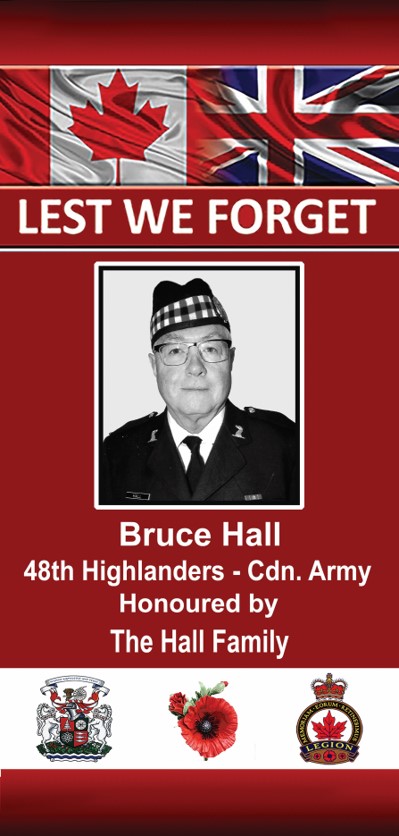
On June 7, 1917, Philip Pattrick was born to George and Georgina Pattrick in Lakefield, Ontario. When Philip was three, they relocated to a property in Bowmanville near Wellington Street and Liberty Street, a lot on which they farmed. Philip went to the Central Public School and attended three years at Bowmanville High School. Leaving school at the height of the depression, he was required to help support the family. He landed a position at the Goodyear plant before enlisting. Enlistment occurred in 1940 when Philip was 23. He signed up with the Midland Regiment, a local unit mostly comprised of Durham and Northumberland Counties recruits. This unit has a long and storied history dating back to pre-Confederation. It mobilized for the Second World War in July 1940. They served in Canada, guarding strategic points in Ontario, the Maritimes, Alberta, and British Columbia, where the unit was engaged on coastal defence duty. These duties were not enough for many men who desired active overseas units. Philip transferred to an infantry unit, the Queen’s Own Rifles, in December of 1942. On March 31, 1943, he arrived in England and trained with his new unit for the eventual Normandy invasion. The Queen’s Own Rifles would be the leading infantry unit on their section (Nan) of Juno Beach on D-Day. They were the only unit of all the allied forces to reach their inland objective. They pushed more than eight miles into France, having to withdraw a few miles as they had outrun their supply chain. They also suffered the highest casualties of any Canadian unit. What followed were eleven months of continuous fighting until the conflict ceased, Germany surrendering in May of 1945. In Normandy, they won honours for the Battle of Caen and the capture of the well-defended airfield at Carpiquet. They then liberated crucial channel ports in France, Belgium and the Netherlands. Their next task was seizing launch sites for V2 rockets and infrastructure for the next version of V3 prototypes. Finally, they liberated the northern provinces of Holland and pushed into Germany at the war’s end. They were demobilized on December 13, 1945. Philip returned to Bowmanville and, in 1946, married Jean Wayling, raising three children. He returned to Goodyear, retiring in 1981. He suffered from what was commonly called shell shock, today is known as PTSD. He was a member of local Branch 178 of the Royal Canadian Legion in Bowmanville. He was a fan of Winston Churchill and liked to stroll through town smoking a big cigar, similar to his hero, and loved to associate with his fellow veterans. He died on August 2, 2001, at 84 |
| Nathan Hircock |
Biography coming soon. 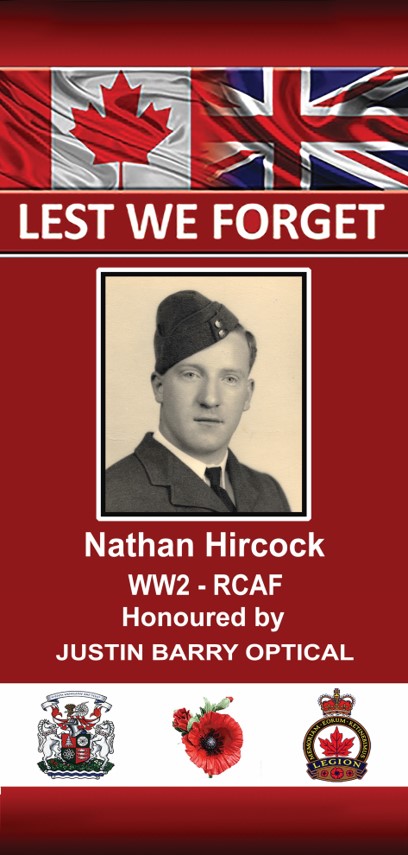 |
| Edward B. Hooper |
Biography coming soon. 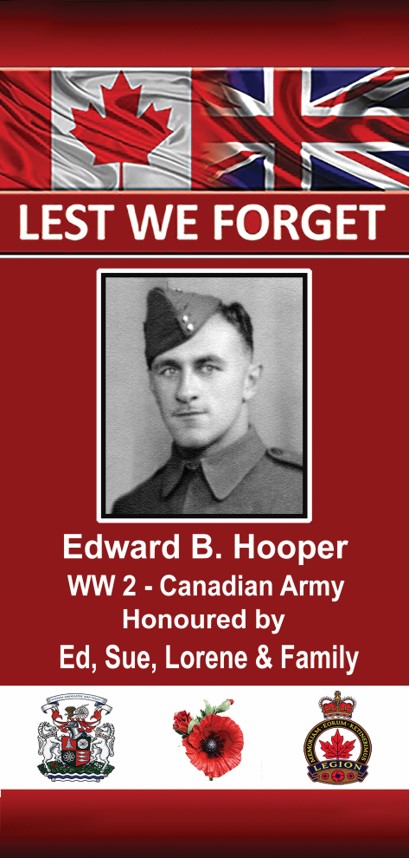 |
| Hubert M. Hooper |
Biography coming soon. 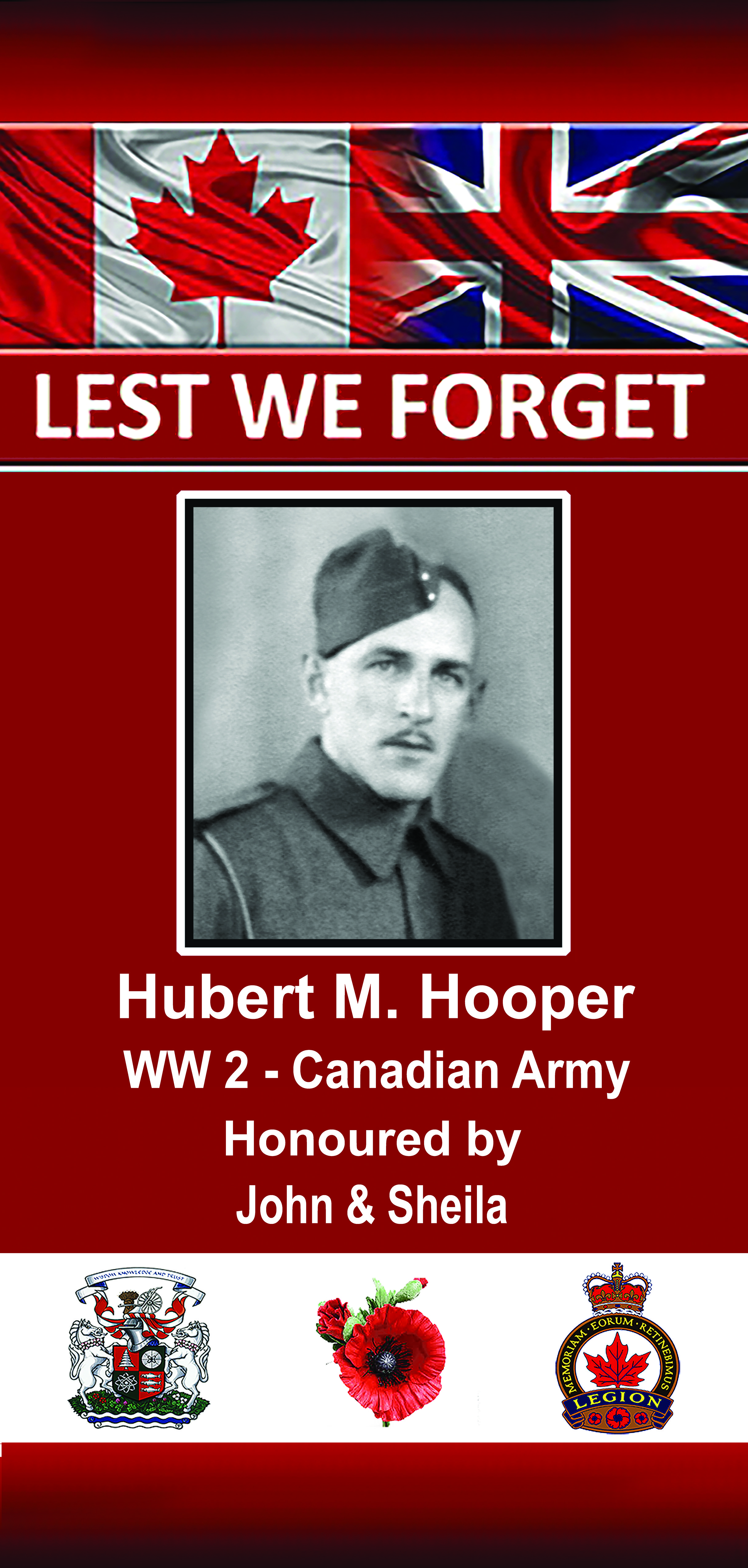 |
| Ronald John Hooper |
Biography coming soon. 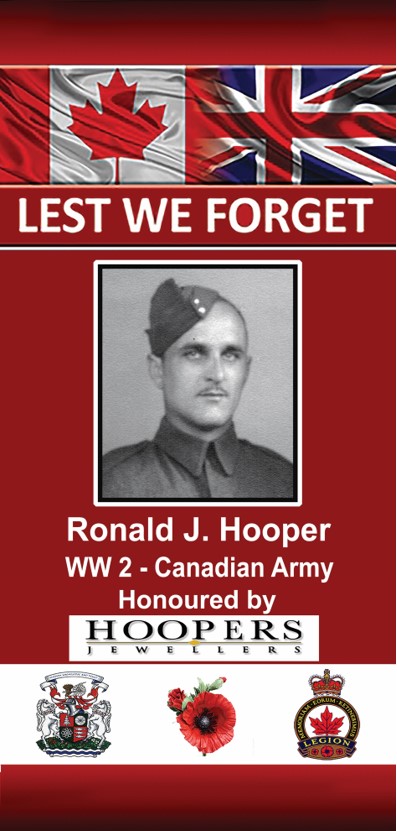 |
| Thomas Henry Hayes |
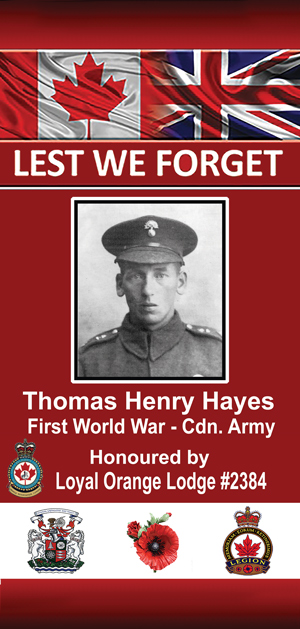 Thomas (Tom) Hayes was born on July 3, 1889, in Coleraine, County Londonderry, Ireland. He served briefly with the Ulster Volunteer Force in 1911 and immigrated to Bowmanville, Canada, in 1912 at 23. He worked at the Goodyear plant. He met and married Mary Dawson, who was born and raised in England before emigrating. Thomas (Tom) Hayes was born on July 3, 1889, in Coleraine, County Londonderry, Ireland. He served briefly with the Ulster Volunteer Force in 1911 and immigrated to Bowmanville, Canada, in 1912 at 23. He worked at the Goodyear plant. He met and married Mary Dawson, who was born and raised in England before emigrating.
Tom enlisted at 26 in Bowmanville with the 136th Battalion on March 18, 1916. He had two children already. Upon arriving in England in 1916, the unit was absorbed into the 39th Battalion of the Canadian Expeditionary Force and eventually became known as the Hastings and Prince Edward Regiment. Their Canadian base was in Belleville, Ontario. On January 2, 1917, the 39th Battalion was absorbed into the 6th Reserve Battalion (Eastern Ontario). This unit’s first active engagement was the 2nd Battle of Arras between April 9 and May 16, 1917. Unified attacks by both French and British forces on entrenched German positions took place over a broad front. For the first time, all Canadian troops were given the responsibility of taking Vimy Ridge. Tom suffered a leg wound at Vimy, an injury that nearly caused an amputation. He was treated and his leg was saved, but he would walk with a limp the remainder of his life. Finally, he evacuated to England for recovery; his war was over. Back in Bowmanville, Tom returned to employment at Goodyear until he retired. He and his wife raised three boys on Elgin Street. Tom did not drive and never owned a car. He enjoyed gardening and was known for his gladioli plants. Tom was one of the founders of the Bowmanville Branch of the Royal Canadian Legion and a lifetime member of the Loyal Orange Lodge 2384. He died in 1987. He was 98. |
| John M. James |
Biography coming soon. 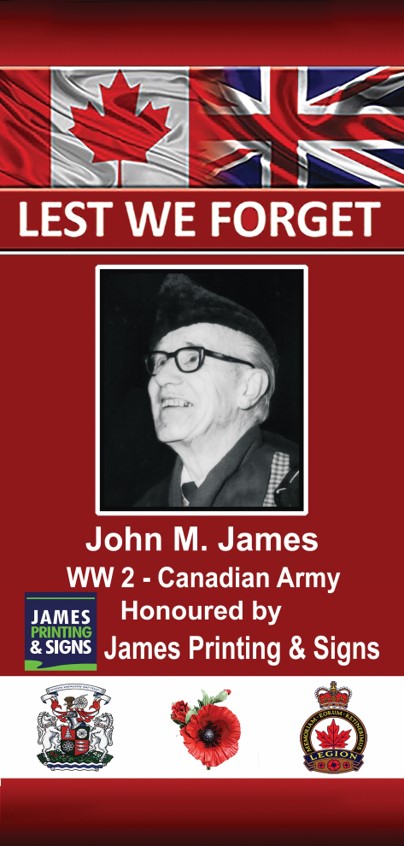 |
| Ritson J. Kinnear |
|
Ritson Kinnear was born in Saint John, New Brunswick, on September 4, 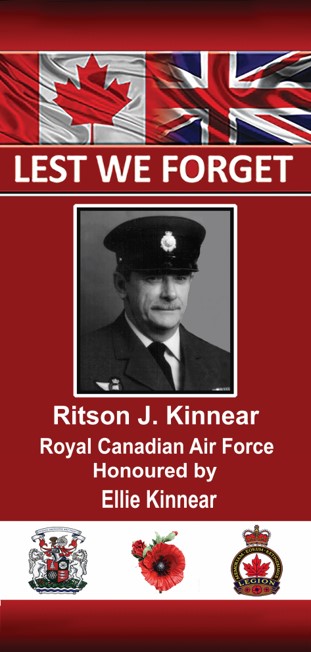 1947, to Robert Kinnear and Elva Fenwick. The family moved to Bowmanville in 1954 when his father, a highly decorated Second World War veteran, took a position as a supervisor at the Bowmanville Training School for Boys. Ritson participated in the local Cubs and Scouts organization. He attempted to join the Canadian Army at 16 but was accepted for recruitment in the regular forces in 1964 when he was 17. 1947, to Robert Kinnear and Elva Fenwick. The family moved to Bowmanville in 1954 when his father, a highly decorated Second World War veteran, took a position as a supervisor at the Bowmanville Training School for Boys. Ritson participated in the local Cubs and Scouts organization. He attempted to join the Canadian Army at 16 but was accepted for recruitment in the regular forces in 1964 when he was 17.
Ritson selected the Black Watch as his active battalion based in Quebec and New Brunswick. He took general infantry training, and in 1966 he served with the Black Watch on a six-month UN peacekeeping mission in Cyprus. In our national centennial year in 1967, he was selected to participate in the national Tattoo, a coast-to-coast historically themed presentation with three centuries of Canadian military tradition. In keeping with the Scottish nature of the Black Watch, Ritson performed as a highland dancer. In 1969, the military amalgamated into the Canadian Armed Forces, and the Black Watch transitioned from an active unit into a militia. Ritson was reassigned to Royal Canadian Regiment (RCR), another infantry unit partially based at Gagetown as a regular force member. In 1970 he served another six-month peacekeeping tour in Cyprus with his new unit. He then guarded the Montreal residence of Prime Minister Pierre Trudeau’s brother Charles during the October Crises. He married his wife Barb in 1971, set up a house in Oromocto, New Brunswick and raised their daughter, Lacia, who now resides in Whitehorse. In 1973, he was selected as part of an eight-man RCR crew to paddle a canoe from Ottawa to Charlottetown, commemorating the centennial celebrations of Prince Edward Island. They carried official messages of congratulations and goodwill from and to the Mayors and Lieutenant-Governors of the cities and provinces involved. Ritson re-mustered in 1979 after fifteen years with active infantry units. He transferred to the Canadian Forces Logistics Branch as a finance clerk. This is the administrative corps of the CAF responsible for finance, human resources, supply, food service, transportation and all related training for these functions. He served until 1990, when he was released from the regular force at NDHQ Ottawa and entered a new phase with the Eighth Air Reserve in Trenton, working full time for Air Transport Group HQ. In 1997 he switched to part-time service with 424 Transport and Rescue Squadron, which provided search and rescue coverage to a million square-kilometre area of Central Canada. In 2006, he was assigned to the Regional Cadets Air Operations at CFB Trenton, responsible for executing and overseeing all flying activities conducted in support of the Air Cadet program. After a remarkable service of 48 years to his country, Ritson fully retired in 2012, resided with his wife in Trenton. He is a ham radio operator, flies model aircraft, and enjoys computer games. |
| Robert J. Kinnear |
|
War broke out in 1939 when Robert was 28, and he enlisted with the Eighth Princess Louise’s Hussars. His unit was mobilized as the 4th Canadian Motorcycle Regiment. In May 1940, the unit was converted to an armoured regiment and trained at Camp Gagetown in New Brunswick and Camp Borden in Ontario. Robert married Elva Fenwick in Sussex, New Brunswick, on December 21, 1940. On October 9, 1941, his unit embarked for Britain. Upon arrival, he was reassigned to the Ontario Regiment, 11th Armoured Regiment. After additional training, his unit was selected to join the British Eighth Army under Field Marshal Montgomery in North Africa, arriving in 1943. In July, Robert and his regiment participated in the invasion of Sicily, known as Operation Husky and in September, they invaded the Italian mainland at Reggio, Calabria. They were soon joined by many other Canadian units, forming the First Canadian Division in Italy. From this point until early 1945, Robert’s unit was actively engaged along the entire Italian peninsula, garnering fifteen battle honours. In March 1945, they were transferred to the Northwest European theatre, accumulating another battle honour in the Netherlands. Like many veterans, Robert never spoke of what he saw or experienced during the war but said he would never forget the “Moaning Minnie” sound, a type of mortar shell utilized by the enemy. At some point during his service, Robert’s tank was hit during a battle, and he was the only survivor, which wounded him physically and mentally. He spent time in the hospital recovering but eventually returned to his unit until the end of the war. Robert carried shrapnel from his injuries with him for the rest of his life. Upon his return from war, Robert and his wife moved from New Brunswick to Barrie, Ontario, where he worked as a foreman at the First Co-Operative Packers. In 1954, Bob took a position as a supervisor at the Bowmanville Training School for Boys and moved to the area with his wife and two children. His son Ritson followed in his footsteps with a lengthy career in the Canadian Armed Forces. Robert was a long-time volunteer driver for the Cancer Society and Bowmanville Community Care until his death in 1988 at 78. He was also a member of the Association of the 8th Canadian Hussars and the Royal Canadian Legion. He loved his country and always wore his medals with great pride. He never considered himself a hero in any way; it was his duty. |
|
George M. Kennedy |
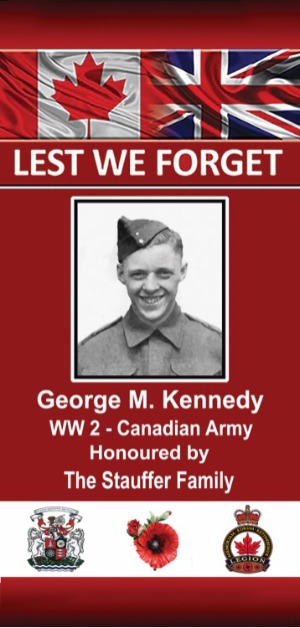 On January 12, 1922, George Kennedy was born in Hespeler, now known as Cambridge, as the second oldest of four sisters and three brothers. His parents, James, born in Ireland, and Jean Kennedy, born in Scotland, immigrated to Canada in 1912. James was also a veteran of the First World War and saw action in France with the Canadian Army. The family relocated to Bowmanville after 1924. George worked at the Bowmanville Foundry along with a few of his other family members, his mother being the foundry nurse at the plant. On January 12, 1922, George Kennedy was born in Hespeler, now known as Cambridge, as the second oldest of four sisters and three brothers. His parents, James, born in Ireland, and Jean Kennedy, born in Scotland, immigrated to Canada in 1912. James was also a veteran of the First World War and saw action in France with the Canadian Army. The family relocated to Bowmanville after 1924. George worked at the Bowmanville Foundry along with a few of his other family members, his mother being the foundry nurse at the plant.
On February 5, 1941, at 19, George volunteered for infantry service in the Second World War and trained with the Hastings and Prince Edward Regiment. These were some of Canada’s most prestigious infantry regiments steeped in history dating back to the defence of Canada in the War of 1812. On September 16, 1941, he married Madeline Margaret Kirby of Cornwall. In 1943, the regiment was selected to participate in Operation Husky, the Allied codename for the invasion of Sicily. The Canadian Army provided one infantry division and one armoured brigade to the effort, under the direction of the British 8th Army. Accordingly, the Hastings and Prince Edward Regiment infantry formed part of the First Infantry Brigade of the 1st Canadian Infantry Division. They stormed the southeastern shore of Sicily on July 10, 1943. On the first day, George’s Brigade seized an airport outside Pachino, which allowed Allied aircraft a base to provide air support for ground troops and resupply logistics. The following two weeks found the Canadian infantry brigades moving inland through the island’s interior, which was rugged and mountainous. George saw action with his brigade, which received battle honours at Grammichele, Valguanera, Assoro and Agira. On July 24, the brigade was advancing on Agira but could get no further than the nearby village of Nissoria due to enemy resistance. Between this village and the objective of Agira there were three ridges the German troops had fortified. George’s brigade initiated an attack on these ridges the following day, July 25, and 80 members of his brigade died in action, including George. He was 21. |
| James Hoskins Kennedy |
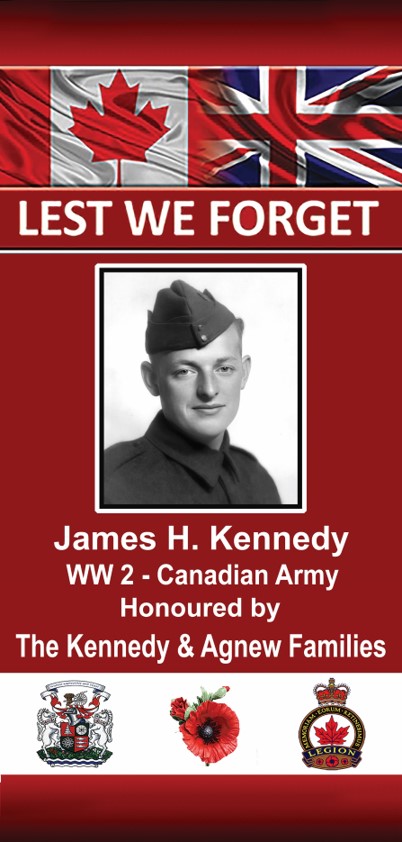 James Hoskins Kennedy “Jim” was born on August 2, 1920 in Hespeler, Ontario, which is situated in present day Cambridge. He was the first-born son of James Martin Kennedy and Jean Esplin Hoskins Kennedy and was one of what were to be eight siblings. The family, then numbering five children, picked up stakes sometime after 1924 and moved to Bowmanville, initially on O’Dell St. and later to Lambs Lane. James and his siblings received elementary schooling in Bowmanville at Central Public and secondary education at Bowmanville High School. As was the case with most males at this time, Jim did not complete high school. This was during the height of the Great Depression and they had to seek employment to support the family, Jim found employment as a grocery store clerk. His mode of transportation was motorcycle, which was about to come in very handy for the Canadian Army. James Hoskins Kennedy “Jim” was born on August 2, 1920 in Hespeler, Ontario, which is situated in present day Cambridge. He was the first-born son of James Martin Kennedy and Jean Esplin Hoskins Kennedy and was one of what were to be eight siblings. The family, then numbering five children, picked up stakes sometime after 1924 and moved to Bowmanville, initially on O’Dell St. and later to Lambs Lane. James and his siblings received elementary schooling in Bowmanville at Central Public and secondary education at Bowmanville High School. As was the case with most males at this time, Jim did not complete high school. This was during the height of the Great Depression and they had to seek employment to support the family, Jim found employment as a grocery store clerk. His mode of transportation was motorcycle, which was about to come in very handy for the Canadian Army.
Jim enlisted for WW2 service on May 8, 1940 and assigned to the local Midland Regiment. This was a domestic unit assigned to guard critical infrastructure and the Canadian coastline. Most recruits wanted transfers out of this unit to join the overseas units, and Jim was no exception. It is not known when this transpired, but he was eventually shipped to England as a member of the Cameron Highlanders of Ottawa, as a dispatch rider. On motorcycles, they were used by armed forces to deliver urgent orders and messages between headquarters and the military field units. They had a vital role at a time when telecommunications were limited and insecure. In active battles, at times they were the only link from front line fighters to command personnel in rear areas. They also assisted artillery and mortar units to aim accurately, relaying enemy positions and results from their shelling. Linemen used them to check telegraph wires, officers as transport, infantry for scouting. Their riders delivered medical supplies and evacuated the wounded. They were a busy bunch. In England, Jim met and married Anne Crowley, an Irish girl who came to England to help during the war, working on a farm and volunteering at a hospital. The Cameron Highlanders were one of the units that went ashore in June of 1944, D-Day at Juno Beach. They were a support unit, principally backing infantry units with heavy machine guns, mortars and anti-tank devices. As such, they were broken up into company and platoon units to assist different infantry units. They garnered many battle honours from the Normandy invasion, through the lowland countries of Belgium and Holland, to the conclusion of the war in May 1945. In October of 1944, probably when Jim was in France, Anne gave birth to a son they named George Martin Kennedy. This was the name of Jim’s brother who was killed in action with the Canadian forces in July of 1943, in Sicily. Jim returned to Bowmanville upon demobilization. He had been injured during his service requiring follow-up treatment at Sunnybrook Hospital in Toronto. His war bride and son followed in May of 1946. He found employment at the Bowmanville Foundry, the couple having a house built on nearby Scugog St., later the family would eventually move to another residence on Parkway Cres. Their daughter Marie was born in 1949. He started to work at General Motors in 1951 and would retire from this in 1981. He also worked on a casual basis delivering heating oil for Sturrock’s Fuels. They parked their tank trucks in a compound immediately north of the Foundry property, when a large fire occurred at the Foundry on March 17, 1960. Jim jumped over his rear fence, then over another into Sturrock’s compound. Knowing where the keys were kept, he had raced to get them and moved the trucks out of harm’s way. It could have proved disastrous otherwise. Jim passed away on March 1, 1982, at 61 years of age. |
| Herbert M. Kewell |
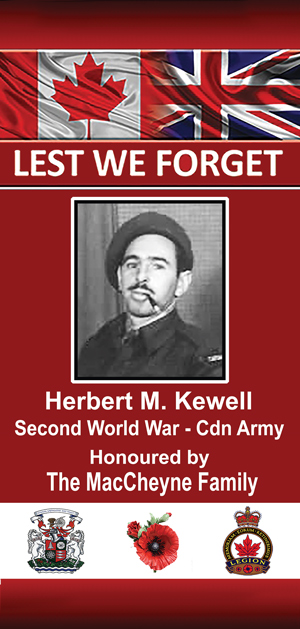 Herbert Kewell was born on December 30, 1920, to John and Rose (Farley) Kewell. His father was a First World War veteran who immigrated from England. Herbert was the oldest of seven children. The family lived in Vaughan Township, north of Toronto in what is now known as Thornhill. Herbert Kewell was born on December 30, 1920, to John and Rose (Farley) Kewell. His father was a First World War veteran who immigrated from England. Herbert was the oldest of seven children. The family lived in Vaughan Township, north of Toronto in what is now known as Thornhill.
On January 12, 1940, at 19, he volunteered to serve in the Second World War with the Canadian Forces. He was assigned to the Royal Canadian Medical Corps and was eventually transported overseas to England. He served with a Field Ambulance Unit, a mobile medical crew that treats wounded soldiers, evacuating them from the combat zone. In 1943, his unit participated in the invasion of Italy, supporting the various infantry divisions of the Canadian Army. Early in 1945, the unit was relocated to the European front serving in France, Belgium and Holland. While serving in Holland, his troops were active in the liberation of Holland. A seven-year-old boy in Nieuwe Pekela watched in amazement as the Canadian soldiers marched through his hometown. Many years later, this same young man would become Herbert’s son-in-law. On September 19, 1945, Herbert was discharged and returned to civilian life. Upon arriving home in Canada, he travelled to Corunna, Ontario, to meet his overseas pen pal, Jessie Violet Hayes. On June 5, 1946, they married and settled in Corunna. Initially, Herbert was the town constable but soon found employment in nearby Sarnia, Ontario, in the petrochemical plants. They have three daughters, nine grandchildren and 12 great-grandchildren. Herbert’s eldest daughter lives in Bowmanville with her husband, child and two grandchildren, who are all very proud of their papa. Herbert enjoyed gardening and playing golf with the Polysar retirees. He was an active member of the Anglican Church in Corunna and the Royal Canadian Legion Branch 447, where he served terms as President and Past President. He felt great pride in being a veteran of the Canadian Army and always participated in the poppy campaign. Herbert died on June 7, 2008. He was 87. |
| Harold Longworth |
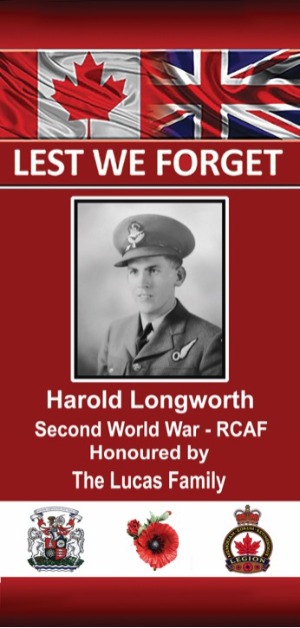 On October 27, 1915, Harold Longworth was born in Woodstock, Ontario, to Harvey Elwood and Hannah Margaret (nee Kirkpatrick) Longworth. Harvey Longworth was an entrepreneur who owned and operated several businesses, including a lumber supply, sawmill, farms, and gravel pits. They had five children, Grace, Marge, John, Harold and Donald. Harold attended the University of Western Ontario, where he won various awards and scholarships and graduated in 1937. On October 27, 1915, Harold Longworth was born in Woodstock, Ontario, to Harvey Elwood and Hannah Margaret (nee Kirkpatrick) Longworth. Harvey Longworth was an entrepreneur who owned and operated several businesses, including a lumber supply, sawmill, farms, and gravel pits. They had five children, Grace, Marge, John, Harold and Donald. Harold attended the University of Western Ontario, where he won various awards and scholarships and graduated in 1937.
He worked as a teacher at Bowmanville High School in 1938 as a modern language specialist for French and German, and in 1940, he coached the high school senior rugby team to the Central Ontario Championship. One of his colleagues at Bowmanville High School was Leonard Lucas. The pair became great friends, and when the second World War erupted in 1939, they volunteered together in June 1941. Harold was 24 when he enlisted for service in the Royal Canadian Air Force. Leonard remained at various bases in Canada, training flight crews, and Harold was posted to England, assigned to the 418 Squadron, based at Bradwell Bay on the coast of the English Channel. The 418 was an intruder squadron, and their aircraft were designed for air-to-air and ground attacks. Their missions were usually night operations at low levels to escape radar detection. They went into the heart of enemy territory to wreak havoc among departing or returning Luftwaffe night-fighter crews or shoot up enemy airfields. Their aircraft did not carry radar sets, meaning at night, targets had to be identified, lined up, and attacked, all with the naked eye, which takes immense skill and knowledge. On October 17, 1942, a cross-country low-level training flight with three men lifted off from Bradwell Bay with a compass and radio bearing as their navigation. Unfortunately, the plane got off course and crashed into a 3,000-foot mountain in northern Wales, killing Harold and one other occupant. Harold was 26 when he died. An avenue and an elementary school in Bowmanville are named in honour of Harold Longworth. |
| Leonard Lucas |
|
When the RCAF realized they had a skilled mathematician, they utilized him for training navigators for the RCAF, Royal Air Force, and Australian and New Zealand forces. Under the British Commonwealth Air Training Program, Canada supplied thousands of skilled pilots and navigators for the war effort. He trained at bases across Canada, including Rivers, Manitoba and L’Ancienne-Lorette, Quebec. Len was also a consultant developing a navigational system known as LORAN (Long Range Navigation), a radio-based system that offered accuracy at ranges up to 1,500 miles.It was first used for ship convoys crossing the Atlantic Ocean and then by long-range patrol aircraft before finding its primary use on the ships and aircraft operating in the Pacific theatre during the Second World War. Following the war, Len continued teaching mathematics at the University of Toronto, instructing returning veterans looking to upgrade their education in civilian life. Later, he returned to high school, teaching at Humberside Collegiate in Toronto, and then, in 1954, he returned to BHS. He resided in Bowmanville and raised a family of four. Len became Vice-Principal of BHS and then Principal before retiring in 1973. There was a strong sense of camaraderie amongst the staff at BHS, and Len carried those memories into his retirement at Shelter Valley near Cobourg until he died in 1987 at 78, not far from his childhood home. |
| Alick Lyle |
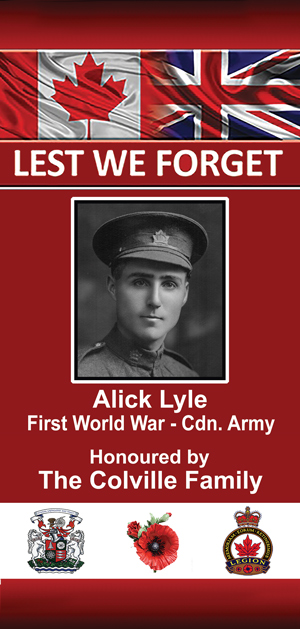 Alick Lyle was born in Bowmanville on December 5, 1890, to John and Mary Lyle. He had one sister, Mary, and attended Central Public School on Wellington Street and Bowmanville High School, when it was located on Queen Street. Following his graduation, he found employment as a clerk at a local bank branch. Alick Lyle was born in Bowmanville on December 5, 1890, to John and Mary Lyle. He had one sister, Mary, and attended Central Public School on Wellington Street and Bowmanville High School, when it was located on Queen Street. Following his graduation, he found employment as a clerk at a local bank branch.
On March 15, 1915, at 24, Alick enlisted with the Canadian Expeditionary Force to serve in the First World War. He was assigned to the 19th Battalion of the Canadian 2nd Division and received his initial training at Exhibition Park in Toronto. This battalion shipped out to Shorncliffe, England, for additional training and then moved on to France in September of 1915, where it served with distinction until 1919. Due to his small stature, Alick was frequently called upon to participate in forward group action. Under cover of nightfall, these soldiers would enter no-man’s land between the trenches, creep close to enemy positions to gather intelligence and then report back. Alick and his battalion participated in many famous battles during the First World War, including:
Throughout his three years of combat, Alick was fortunate to have never been wounded and returned home to Bowmanville, where he was the town clerk for the next 30 years. He was one of the principal founders of the Bowmanville Legion and was the branch president in 1934. In 1936, the Government of Canada invited him to be part of the delegation to unveil the Canadian National Vimy Memorial in France. Alick was never married, but his favourite hobby was fishing with other local First World War veterans. Alick died on November 11, 1968, fifty years, down to the hour, following the signing of the armistice that ended the First World War. Alick was 77. |
| Louis Lyle |
|
His mother, Margaret, was a British Home Child sent overseas, residing with and working for a wealthy Bowmanville family. Father George worked at the Bowmanville Foundry and was the fire chief of the volunteer Bowmanville Fire Department. Louis was educated at Central Public School and another year at Bowmanville High School. Leaving school early was quite common during the Great Depression, with family support as a priority. Their home was on Prospect Street, where they kept a garden. But a few more acres were purchased on what is now Rehder Avenue, where a huge garden was cultivated, with an old shed in which they kept some livestock, things many families did to exist in those tough times. In the late 30s, George suffered a serious injury while operating the fire truck. He was unable to work from that point on. Louis worked two jobs, filling in for his father at the Foundry and the Brookdale Kingsway Nursery on Baseline Road. Theirs was a close-knit family, and like many others, they helped to look after the community, bartering and sharing whatever they could. When the Second World War in Europe erupted in September of 1939, Louis was one of the first to enlist at the age of 19 years. Like most local volunteers, he was probably assigned to the Midland Regiment. This domestic unit was assigned to guard critical infrastructure and the Canadian coastline. He likely served in Ottawa initially, then in St. John and Sussex, New Brunswick, on the east coast, and onto Edmonton, Alberta, Terrace and Prince Rupert in British Columbia on the west coast. Most recruits wanted transfers from the Midland Regiment to join the active overseas units, and Louis was no exception. It is unknown when this transpired, but he was eventually shipped to England as a Cameron Highlanders of Ottawa member. The Cameron Highlanders were one of the units that went ashore in June of 1944, D-Day at Juno Beach. They were a support unit, principally backing infantry units with heavy machine guns, mortars and anti-tank devices. As such, they were broken up into company and platoon units to assist different infantry units. Louis was attached to D Company, a heavy mortar unit. Heavy mortars are large-calibre mortars designed to fire a relatively heavy shell on a high-angle trajectory. Such weapons have a relatively short range and are used as close-fire support for infantry advances. Due to size and weight, individual platoons were required to be mobile. They are referred to as indirect weapons. Aiming is difficult, necessitating spotters on motorcycles to relay information. Louis would have seen action in the Normandy battles of Caen and the Falaise Gap in July and August of 1944, followed up with the clearing of the French channel ports, then battles of the Scheldt Estuary between Belgium and Holland in late 1944 and early 1945, and finally the liberation of the Netherlands in 1945. His unit received the honorarium of being mentioned in dispatches, a tribute to their fighting capability. Upon demobilization, he returned to Bowmanville and his previous job at the Foundry. On August 16, 1947, he married Joyce Buttonshaw. This union eventually added two daughters to the family. He would find employment at the Goodyear factory until retirement in 1980. He also worked occasionally driving and delivering for Sturrock’s Fuels and Petherick’s Water Supply. Louis was hands-on and handy, a woodworker, and built a family cottage. He loved Bowmanville, was active in the local Legion Branch, and was an avid Toronto Blue Jays baseball club fan. He was described as a quiet soul, a loving father and grandfather of three, passing away on December 24, 2016, at the age of 97 years. |
| Sterling Mather |
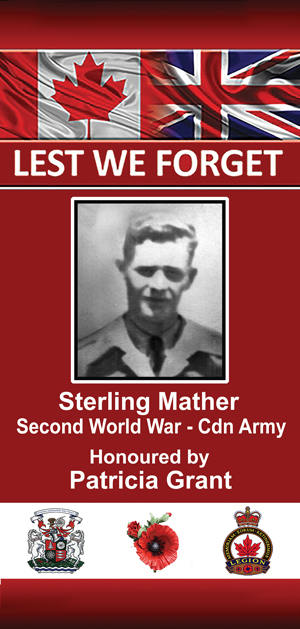 Sterling was born in Newcastle, New Brunswick, on August 19, 1926, to Lawrence and Frances Mather. Sterling was the youngest of nine children. The town, renamed Miramichi, is situated in northeastern New Brunswick and was a logging centre at the time. Sterling’s father died when he was three, and his older siblings helped support the family. Sterling only completed grade eight before finding any work he could to help his family. His mother died when he was 15. Sterling was born in Newcastle, New Brunswick, on August 19, 1926, to Lawrence and Frances Mather. Sterling was the youngest of nine children. The town, renamed Miramichi, is situated in northeastern New Brunswick and was a logging centre at the time. Sterling’s father died when he was three, and his older siblings helped support the family. Sterling only completed grade eight before finding any work he could to help his family. His mother died when he was 15.
Sterling had a great sense of humour, primarily when referring to his youth; this may have been a coping mechanism for his difficult childhood. He only went to school every other day, and there were only a few pairs of shoes for all the kids in the family. He knew when his mother had used up a flour sack because somebody in the family was wearing a new t-shirt with Robin Hood stamped on it. In 1943, Sterling worked at Montreal Locomotive building railway locomotives but switched to armoured tanks for war-time production. Sterling’s brothers had all enlisted to serve in the Second World War, but Sterling wasn’t eligible until 1944. He enlisted in September of 1944, and completed his basic training at Camp Borden. He wasn’t allowed overseas because his brothers were already there, and the government was uncomfortable with having too many immediate family members in active combat. So instead, Sterling became a trainer and spent most of his service in Fredericton, NB, in the Demonstration Platoon, training recruits. After demobilization in October 1945, Sterling returned to Newcastle, NB. He married Kathleen Somers and raised two children. They relocated to Wilberforce in 1947, joining one of his brothers at a veneer mill for 17 years. In Wilberforce, he served on the town council, and coached minor hockey, even though he couldn’t skate. He was managing the mill in 1964 when CurvePly Wood Products purchased it. Sterling and his family relocated to Orono, where he was the general manager of the production facility and later, Sterling retired in 1986 at 60. Sterling’s first wife died in 1981, and he remarried Nancy Barry in 1990, moving to Newcastle. Nancy died in 2009, and Sterling now lives with his daughter in Oshawa. He has been a life-long Royal Canadian Legion member in Haliburton and now Branch 178 in Bowmanville. At 93, he has maintained his great sense of humour and wit. Many Branch members attest to being poked by Sterling’s jokes and how his presence brightens up any occasion. He is a self-taught man who rises from a humble background to success but never loses his common touch. |
| Cpl. Jack McGowan Kay |
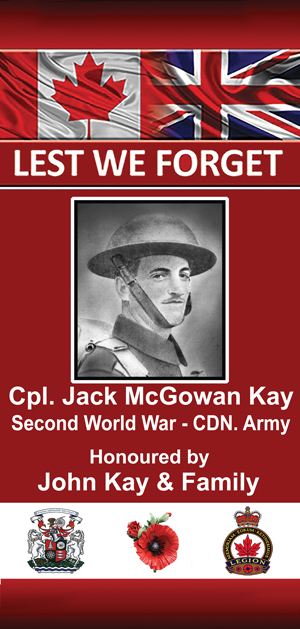 Jack Kay was born in Comrie, Perthshire, Scotland, on April 6, 1913, to William, and Mary (nee Comrie) Kay. William was a renowned writer, publishing as the Ploughman’s Poet. The family farmed the properties they owned and leased the properties where their six children helped with work. Jack attended school, but at 15, he entered an apprenticeship program to become a landscape gardener. Jack Kay was born in Comrie, Perthshire, Scotland, on April 6, 1913, to William, and Mary (nee Comrie) Kay. William was a renowned writer, publishing as the Ploughman’s Poet. The family farmed the properties they owned and leased the properties where their six children helped with work. Jack attended school, but at 15, he entered an apprenticeship program to become a landscape gardener.
His brother, a year younger, applied to come to Canada as an indentured farmhand but failed the physical as he was blind in one eye. With the trip already booked, Jack filled the position and arrived in Canada in 1929. He worked a three-year term on a farm near Norval, Ontario. In 1932, Jack found employment on an estate at Shanty Bay on the Kempenfelt arm of Lake Simcoe, near Barrie, Ontario. He worked there during the summer, moving to work for the estate owner in Toronto in the winter months, and met his wife, Evelyn Leavell. On July 22, 1940, at 27, Jack enlisted to serve in the Second World War with the Grey and Simcoe Foresters, training at Camp Borden. In March 1941, Jack married Evelyn and moved to Collingwood, where they had two children before he embarked for England on June 16, 1943. Jack completed more training at a base near the British town of Aldershot. On November 1, 1943, Jack’s regiment broke up for reinforcements. Consequently, Foresters found themselves represented in tank regiments in almost every theatre of conflict. Jack was assigned to the armoured unit of the 1st Hussars and began training for D-Day. Being an armoured unit, they had to learn to operate amphibious tanks. These tanks would embark deeper water and propel themselves ashore while creating a flotation screen using canvas around the tank as a hull, which enabled them to float. Rear propellers helped it drive through the water, but they were difficult to operate and could not tolerate rough seas, resulting in several losses of tanks and men during training. Jack’s unit departed Portsmouth, England, for the Normandy attack on Juno Beach on June 5, 1944. The following dawn, they entered the water approximately 1,000 metres offshore when a wave swamped the tank, causing the crew to evacuate. Four of the five-person unit, including Jack, were killed by enemy machine-gun fire while attempting to make the beach. Jack was 31. Jack’s son, grandson and two great-grandchildren are long-time residents of Bowmanville. Along with the banner that is displayed in Bowmanville to honour Jack, there is a second banner displayed along the Juno Beach front that is placed by five French villages in honour of Jack’s sacrifice. |
| D. George McDonald |
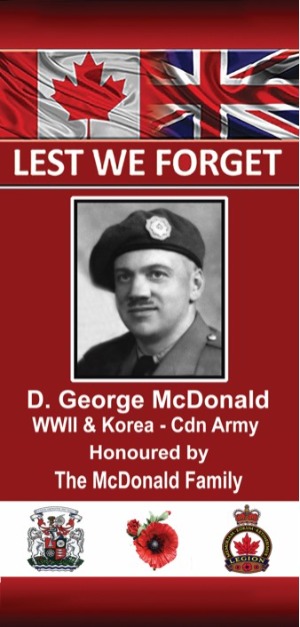 David George McDonald was an only child born in Niagara Falls on April 5, 1913, to Alexander and Jean McDonald (nee Stewart). His father died when George was young. After leaving school, he attended a Bible College in Toronto for three years with aspirations of becoming a missionary. David George McDonald was an only child born in Niagara Falls on April 5, 1913, to Alexander and Jean McDonald (nee Stewart). His father died when George was young. After leaving school, he attended a Bible College in Toronto for three years with aspirations of becoming a missionary.
In 1937, George married Margaret Jean Turnbull of Hamilton and had five children. In 1941, at 28, he enlisted in the Canadian Army to serve in the Second World War. While in training, he developed severe mastoiditis, an ear infection that leads to more infection, principally in the brain. He required surgery and was transported back to Canada in 1943 and received a medical discharge. George returned to employment as a TTC streetcar operator in Toronto until the Korean War erupted. In 1950, he enlisted again with the Canadian Army as a regular service member. He was assigned to the Royal Canadian Army Service Corps and sent to Korea with his unit. Unfortunately, he suffered a head injury when he fell into a crater from a mortar shell. He returned to Camp Borden and was reassigned to the Royal Canadian Army Pay Corps, an administrative corps of the army in charge of finances. He held this position until his honourable discharge in 1961. After returning to Toronto, George found work as an apartment superintendent. Unfortunately, disability from illness and injury had taken its toll on his health, and George died on April 11, 1985. He was 72. He had served his country for 13 years through two wars. George has one grandson and three grandchildren who are long-time residents of Clarington in both Courtice and Bowmanville. |
| Henri McGraw |
|
Henri Joseph McGraw was born on August 5, 1922, in Paquetville, New 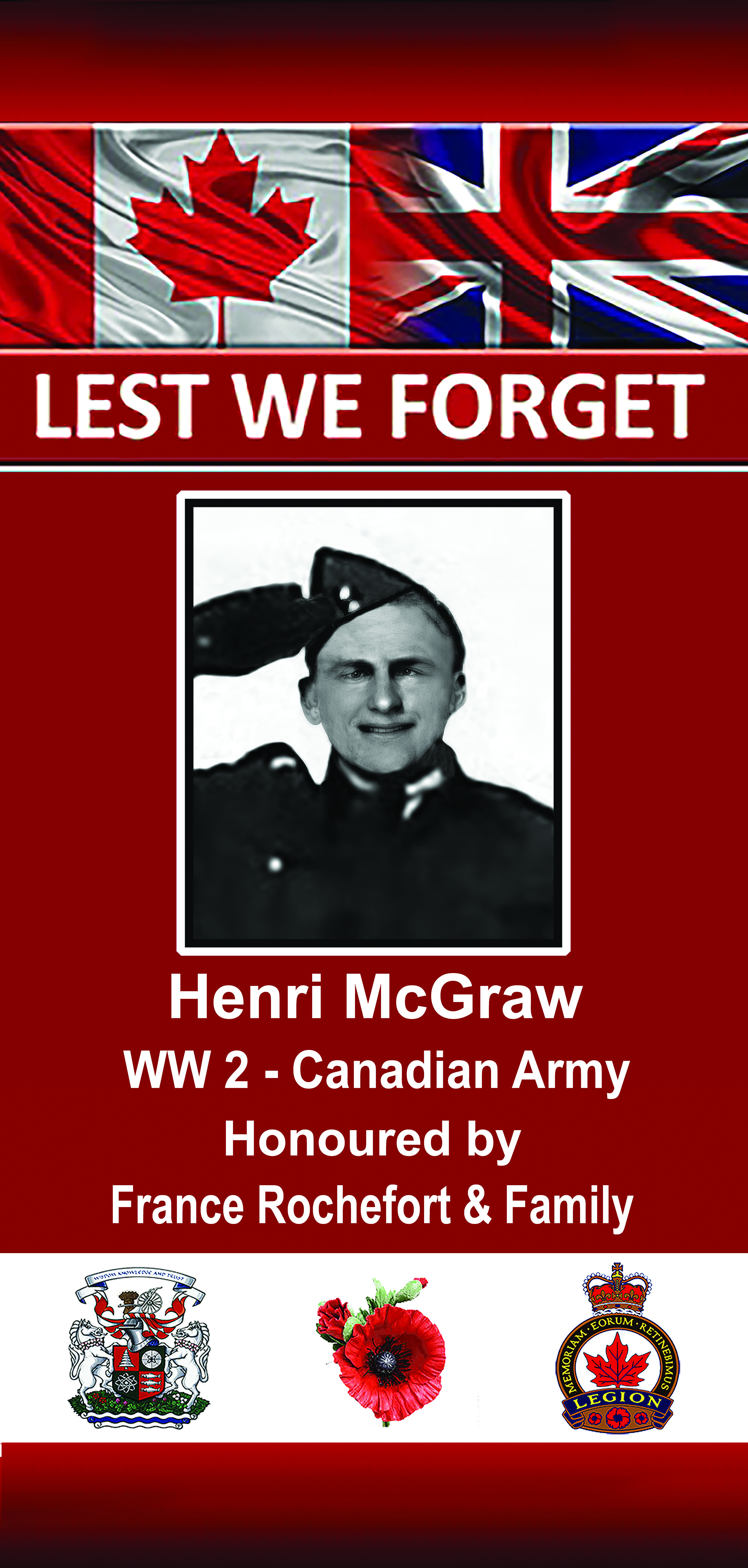 Brunswick, to Amos and Louise (neé Hébert) McGraw, who died early. He completed elementary school in Paquetville just as the family uprooted and moved to Québec City. He left school at 18 and worked in a local grocery store when the family relocated again to Jonquière, Québec. Henri relocated to Sarnia, Ontario, to work at Polymer Corporation. Sarnia needed manpower for a burgeoning petrochemical industry supplying synthetic rubber and other vital materials to the war effort. Brunswick, to Amos and Louise (neé Hébert) McGraw, who died early. He completed elementary school in Paquetville just as the family uprooted and moved to Québec City. He left school at 18 and worked in a local grocery store when the family relocated again to Jonquière, Québec. Henri relocated to Sarnia, Ontario, to work at Polymer Corporation. Sarnia needed manpower for a burgeoning petrochemical industry supplying synthetic rubber and other vital materials to the war effort.
On April 23, 1943, in London, Ontario, he enlisted for service in the Second World War at 20. He requested to be trained at a French-speaking centre, but his English-speaking chums wanted him to remain with them as he was popular with all. He was transferred overseas and assigned to the North Nova Scotia Highlanders (North Novas), already in the UK. Further training and preparation took place for the Normandy invasion. On June 6, 1944, Henri’s unit was part of the Ninth Infantry Brigade of theThird Canadian Infantry Division that stormed ashore on Juno Beach. They were in the first wave ashore, breaching the enemy’s defensive emplacements on the coastline. Securing the beachhead was only the start of the Normandy campaign. The following days saw his unit seize an airfield at Carpiquet, fighting off many enemy counter offences. Capturing the French town of Caen was a crucial element in the allied strategy, the battle occurring for 17 days in July of 1944. In mid-August, Henri participated in the Battle of the Falaise Gap, where allied troops had permitted German divisions to enter a narrow lane surrounding the enemy. Canadian troops closed the gap to complete the encirclement to make this possible. Forty thousand German troops were forced to surrender, Canadian soldiers demonstrated outstanding courage and tenacity, but the cost of victory was high. There were 5,500 battlefield casualties, including 1,500 dead. Closing the gap was the last episode in the Normandy campaign, a crushing defeat for the German army. By this point, the Canadian troops were battle-hardened. Next up was clearing the Channel ports on the French coast. The Ninth Infantry Brigade took the coastal town Boulogne on the Calais de Pas, the narrowest part of the English Channel. The action known as Operation Wellhit commenced on September 17, 1944, and raged for six days before the town was seized from the enemy. The harbour was cleared of wreckage and mines, and an oil pipeline from England was established by mid-October. Canadian casualties numbered 600, including Henri McGraw, killed in action on September 19, 1944. Henri was only 22 and is remembered and honoured by his niece, a Bowmanville resident. |
| John McLean |
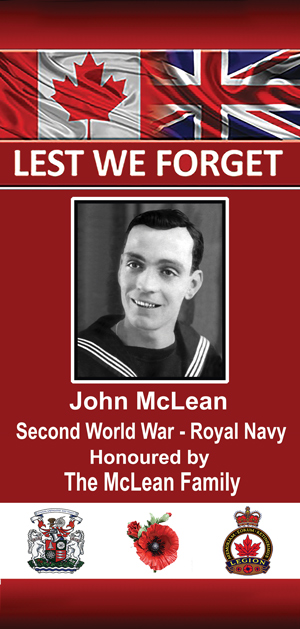 John McLean was born in Belfast, Northern Ireland, on March 20, 1918, where he lived with his parents and his sister Doreen. In 1937, he met his wife, Agnes and married on July 11, 1938. In November of 1940, he enlisted as a volunteer in the Royal Navy to serve in the Second World War. Agnes became a nurse during the German bombing of Belfast throughout the war. John McLean was born in Belfast, Northern Ireland, on March 20, 1918, where he lived with his parents and his sister Doreen. In 1937, he met his wife, Agnes and married on July 11, 1938. In November of 1940, he enlisted as a volunteer in the Royal Navy to serve in the Second World War. Agnes became a nurse during the German bombing of Belfast throughout the war.
John was assigned to a Corvette as an ordinary seaman, performing escort protection for convoys crossing from Halifax to Great Britain. These convoys carried vital war supplies and were under constant threat from German U-boats. In March 1941, John volunteered for the Combined Operations Command and was transferred to HMS Northney on Hayling Island near Portsmouth for initial training on assault landing craft. He then transferred to HMS Quebec, a large, combined operations training base for landing craft training in April. This base was set up at Inveraray on the west coast of Scotland and was named 'The No. 1 Combined Training Centre', of which HMS Quebec was the naval component. This base trained the expanding army invasion force in the latest amphibious landing techniques, including embarkation and disembarkation onto enemy-held beaches. As a result of his combined operations training, John was promoted to Able Seaman and operated a landing craft during the following enemy engagements.
After the war, John was discharged from the Royal Navy in January 1946, and returned to Belfast. He began working for Sirocco Engineering Works, a large engineering company building industrial air conditioning and manufacturing machinery for the tea industry. He died in July 1955. He was 37. John dreamed about immigrating with his family to Canada but sadly passed away before fulfilling his objective. Eventually, his wife and two children came to Canada. His son, now retired, was a long-serving member of the Durham Regional Police Service. John's grandson and family are long-time residents of Bowmanville and the sponsors of his banner in recognition of their grandfather's service during the war. |
| John James Norwick |
|
Jack served as Queen’s York Ranger starting in June 1940 and then enlisted for Canadian Active Service on October 1, 1940, in Toronto, Ontario. He trained and served for nine months at Camp Borden in Ontario before going overseas for 50 months, serving in the United Kingdom, Sicily, Italy and Northeastern Europe. He was a qualified driver in the Royal Canadian Army Service Corps and was proud to be the driver for both General Crerar and General Burns during his time in Italy. His discharge papers note that he had “pre-enlistment experience in driving” as well as a good record in the army driving for General Crerar, which meant Jack would be considered favourable for any driving job. After the war, Jack returned to Canada and secured a job at the Goodyear Tire Factory in Bowmanville. He also worked at General Motors in Oshawa and as a security guard at Camp X. Jack decided to use his driving skills and went into the taxi business and became the owner of Terminal Taxi in Whitby. He then went to work at Fittings Limited in downtown Oshawa and worked there until his retirement. It was while he was driving a taxi in Whitby that he met Gloria Harris, and they married and settled in Oshawa and had six children. Jack died on March 27, 1995, the year marking the 50th anniversary of the ending of the Second World War. He was 77. |
|
Patrick O'Brien |
|
Biography coming soon. |
| Michael Owchar |
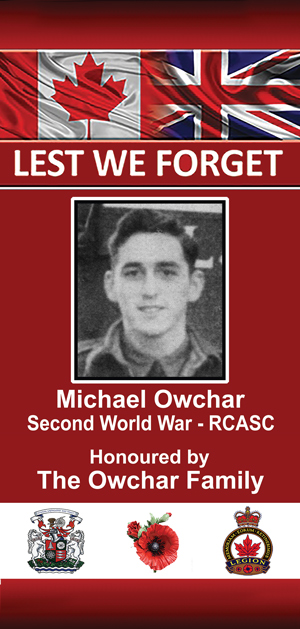 Michael Owchar was born in Montreal, Quebec, on July 27, 1922. He was the eldest boy of five children born to Mafty and Zofia Owczar. When he entered school, Owczar (Ukrainian) became anglicized to Owchar, which became the spelling he would use for the rest of his life. Times were tough during the 1930s and although his father worked on a track crew for the Canadian National Railway and his mother held odd jobs, he left school at 14 to help support his family. Life was not easy, but they always had food on the table and a roof over their heads. Michael Owchar was born in Montreal, Quebec, on July 27, 1922. He was the eldest boy of five children born to Mafty and Zofia Owczar. When he entered school, Owczar (Ukrainian) became anglicized to Owchar, which became the spelling he would use for the rest of his life. Times were tough during the 1930s and although his father worked on a track crew for the Canadian National Railway and his mother held odd jobs, he left school at 14 to help support his family. Life was not easy, but they always had food on the table and a roof over their heads.
In 1942, at 20, Michael enlisted for service in the Royal Canadian Army and entered infantry training. He was very proud to finish finished every 80-kilometre hike with a full pack while other men fell by the wayside. Then, as he was ready to embark for England, he couldn’t walk anymore. He had flat feet. This did not hold him back, and because of his enthusiasm to serve, he was given options, and selected the Royal Canadian Army Service Corps (RCASC). The RCASC was the administrative and transport corps of the Canadian Army. They moved supplies to the frontlines, delivered all rations, ammunition, petroleum products, and all other essentials. They made their deliveries on a variety of vehicles ranging from three to ten-ton trucks, and forty-ton tank transporters. Michael was trained to operate heavy vehicles at Camp Borden in Ontario before being sent overseas. Michael joined his unit, the 3rd Canadian Infantry Brigade Company, entering the fray in Europe from 1944-45, supporting the First Canadian Army to push through Belgium and Holland. One memorable convoy he participated in was bringing food supplies to the starving population in northern Holland. Toward the end of the war, Michael met Johanna, a Dutch girl, the love of his life. Unfortunately, they had no time to marry before he returned to Canada, where he could not remain part of the army due to his feet. Michael worked at the central post office in Montreal for 35 years. Johanna joined him in Canada, and they were married in July 1947, settling in Montreal, where they raised their three children. In retirement, they followed their children to Toronto, eventually living in Bowmanville with their eldest daughter. Wherever he resided, Michael was a member of the local branch of the Royal Canadian Legion, including Branch 178 in Bowmanville. At the end of his life, Veterans Affairs Canada treated him with care and compassion. Michael died at home in Newcastle on April 5, 2018. He was 96. |
| Walter Park |
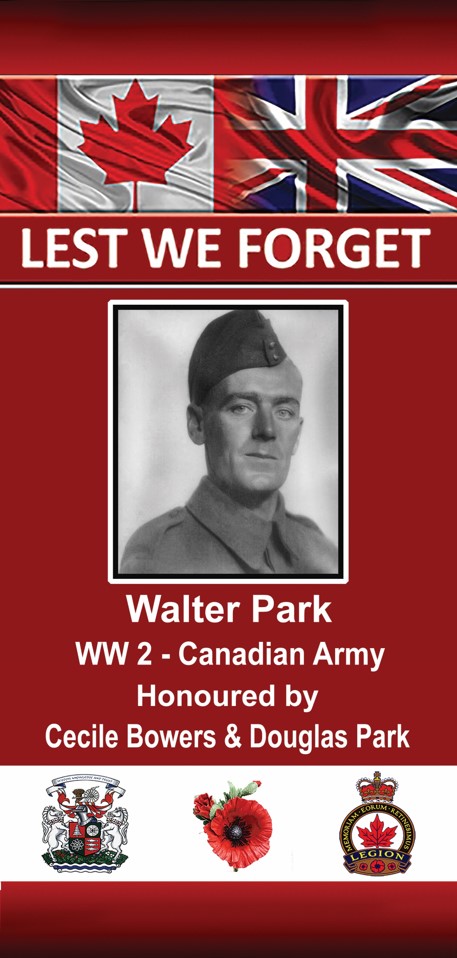 Walter Park was born on November 25, 1913 to Thomas and Georgina Park, in Whitley Bay, England. He was the third child of seven. His father died when Walter was only 11 years of age, he was pulled out of school and went to work in a grocery store to help support the family. In 1927, at the age of 14 and along with a 16 year old sister, they emigrated to Canada sponsored by an uncle living in the Darlington Township village of Tyrone. Walter worked on several farms in the Tyrone area, his sister cleaned houses. They saved enough money to have their mother and three of their siblings come to Canada. Walter had been dating a local girl, Doreen Byam, when WW2 began. Walter Park was born on November 25, 1913 to Thomas and Georgina Park, in Whitley Bay, England. He was the third child of seven. His father died when Walter was only 11 years of age, he was pulled out of school and went to work in a grocery store to help support the family. In 1927, at the age of 14 and along with a 16 year old sister, they emigrated to Canada sponsored by an uncle living in the Darlington Township village of Tyrone. Walter worked on several farms in the Tyrone area, his sister cleaned houses. They saved enough money to have their mother and three of their siblings come to Canada. Walter had been dating a local girl, Doreen Byam, when WW2 began.
Walter enlisted for service on August 1, 1940 at 26 years of age. In Bowmanville, he signed up for the army, the 1st Battalion of the Midland Regiment (Durham-Northumberland). This regiment was an amalgamation of the previous 136th Battalion (Durham) and the 139th Battalion (Northumberland), both with historical military roots in Canada, both sending troops overseas with the Canadian Expeditionary Forces in WW1. However, for WW2 the Midland Regiment remained a domestic unit, guarding strategic infrastructure and the Atlantic and Pacific coastlines. During WW2, the regiment served on guard duty at Ottawa, Saint John, Niagara Falls, Edmonton and Prince Rupert. Walter and Doreen were married on March 22, 1941, a daughter named Cecile born to them in December of 1942 while he was on guard duty in Prince Rupert. Walter’s basic training took place on the grounds of the Cream of Barley Mill, situated where now stands the shuttered Bowmanville Zoo. He was then stationed at these various guard locations, but like most men in the regiment, he wanted to serve in an active overseas unit. Over 1700 of them were transferred to twelve different active Canadian units. Walter went overseas on March 31, 1943. He was initially assigned to the Irish Regiment (Toronto), but then re-assigned to the Argyll and Sutherland Highlanders (Hamilton). More training ensued, preparing for the invasion of Normandy as part of the 4th Canadian Armoured Division. Walter would crew a self-propelled vehicle with an anti-tank gun, their job to knock out enemy tanks ahead of the infantry. His unit arrived in Normandy on July 26, 1944. Less than three weeks later, his anti-tank platoon of six carriers and thirty crew members were engaged in action at the Battle of the Falaise Gap. The enemy was prepared and quickly knocked out five of the carriers, killing or wounding twenty-four of the thirty. At 30 years of age, Walter was the oldster of the group and had assumed the role of taking care of the younger men and emotionally, he never got over this. Physically, he suffered shrapnel injuries, losing the left side of his face, a punctured windpipe, most of his teeth and part of his tongue. After plastic surgery, he was transported back to Canada. He had several more surgeries to repair his face and jaw in Toronto. He was discharged from service in October of 1945 in Kingston, Ontario. The family reunited in Tyrone, with a son Douglas born in 1946. Walter found employment with the Goodyear plant in Bowmanville, working there until retirement. A lifelong resident of Tyrone, he was very active in his community, as well as the local Legion branch in Bowmanville. He passed away on January 16, 2007 at 93 years of age. |
| F. Harvey J. Partner |
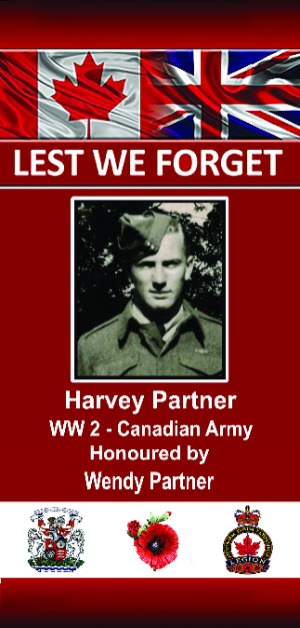 Fredrick Harvey Partner was born on May 22, 1925, to Fred and Hazel (nee Darch) Partner on a rural property near Kirby as the fourth child of five siblings. During the Great Depression, he was educated at the rural Long Sault schoolhouse but was withdrawn after Grade 8 to assist at home on the farm. Three years later, he worked at Goodyear Rubber Company in Bowmanville. On January 25, 1944, he volunteered to serve in the Second World War, assigned to the Royal Canadian Army Service Corps (RCASC). Fredrick Harvey Partner was born on May 22, 1925, to Fred and Hazel (nee Darch) Partner on a rural property near Kirby as the fourth child of five siblings. During the Great Depression, he was educated at the rural Long Sault schoolhouse but was withdrawn after Grade 8 to assist at home on the farm. Three years later, he worked at Goodyear Rubber Company in Bowmanville. On January 25, 1944, he volunteered to serve in the Second World War, assigned to the Royal Canadian Army Service Corps (RCASC).
The RCASC moved supplies to the frontlines, delivering rations, ammunition, petroleum products, and all other essentials. They did so with various vehicles ranging from three to ten-ton trucks and forty-ton tank transporters. Harvey already knew how to operate farm equipment and heavy vehicles and was recognized for his mechanical ability and aptitude for motors. As the only male child in his family, the family needed his assistance on the farm during the growing and harvesting periods, so he was returned home between June and October of 1944. He reported back for service in November 1944, but in July of 1945, he returned home to assist on the farm until October of that year. He returned to base in Kingston and was demobilized on April 1, 1946. After serving, Harvey returned to Goodyear Rubber, opened a business for farm equipment and purchased the mill in Tyrone, working all three simultaneously. He married Bernice Quinney on August 9, 1947, and raised two boys and three girls. He attended trade school and opened Harvey Partner Plumbing, Heating, Electrical and Air Conditioning, which he ran for 40 years until his death on March 19, 1993. Harvey was a member of the Royal Canadian Legion, President of the Bowmanville Rotary Club, Loyal Orange Lodge, and a member of the Masonic Lodge. Harvey was the Commissioner of Hydro for 22 years and was instrumental in amalgamating Newcastle Hydro to Veridian Hydro. Harvey’s service never took him overseas, as the war was almost over when he enlisted. However, food rationing, sending supplies overseas, and local food production was as crucial as sending men into combat. He was likeable, mechanically inclined, and enthusiastic about the Army. He served with honour. |
| Philip Beaufoy Pattrick |
|
On June 7, 1917, Philip Pattrick was born to George and Georgina 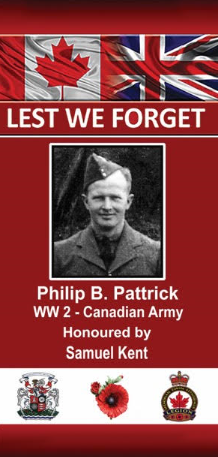 Pattrick in Lakefield, Ontario. Pattrick in Lakefield, Ontario.
When Philip was three, they relocated to a property in Bowmanville near Wellington Street and Liberty Street, a lot on which they farmed. Philip went to the Central Public School and attended three years at Bowmanville High School. Leaving school at the height of the depression, he was required to help support the family. He landed a position at the Goodyear plant before enlisting. Enlistment occurred in 1940 when Philip was 23. He signed up with the Midland Regiment, a local unit mostly comprised of Durham and Northumberland Counties recruits. This unit has a long and storied history dating back to pre-Confederation. It mobilized for the Second World War in July 1940. They served in Canada, guarding strategic points in Ontario, the Maritimes, Alberta, and British Columbia, where the unit was engaged on coastal defence duty. These duties were not enough for many men who desired active overseas units. Philip transferred to an infantry unit, the Queen’s Own Rifles, in December of 1942. On March 31, 1943, he arrived in England and trained with his new unit for the eventual Normandy invasion. The Queen’s Own Rifles would be the leading infantry unit on their section (Nan) of Juno Beach on D-Day. They were the only unit of all the allied forces to reach their inland objective. They pushed more than eight miles into France, having to withdraw a few miles as they had outrun their supply chain. They also suffered the highest casualties of any Canadian unit. What followed were eleven months of continuous fighting until the conflict ceased, Germany surrendering in May of 1945. In Normandy, they won honours for the Battle of Caen and the capture of the well-defended airfield at Carpiquet. They then liberated crucial channel ports in France, Belgium and the Netherlands. Their next task was seizing launch sites for V2 rockets and infrastructure for the next version of V3 prototypes. Finally, they liberated the northern provinces of Holland and pushed into Germany at the war’s end. They were demobilized on December 13, 1945. Philip returned to Bowmanville and, in 1946, married Jean Wayling, raising three children. He returned to Goodyear, retiring in 1981. He suffered from what was commonly called shell shock, today is known as PTSD. He was a member of local Branch 178 of the Royal Canadian Legion in Bowmanville. He was a fan of Winston Churchill and liked to stroll through town smoking a big cigar, similar to his hero, and loved to associate with his fellow veterans. He died on August 2, 2001, at 84. |
| J. Gary Pickard |
Biography coming soon. 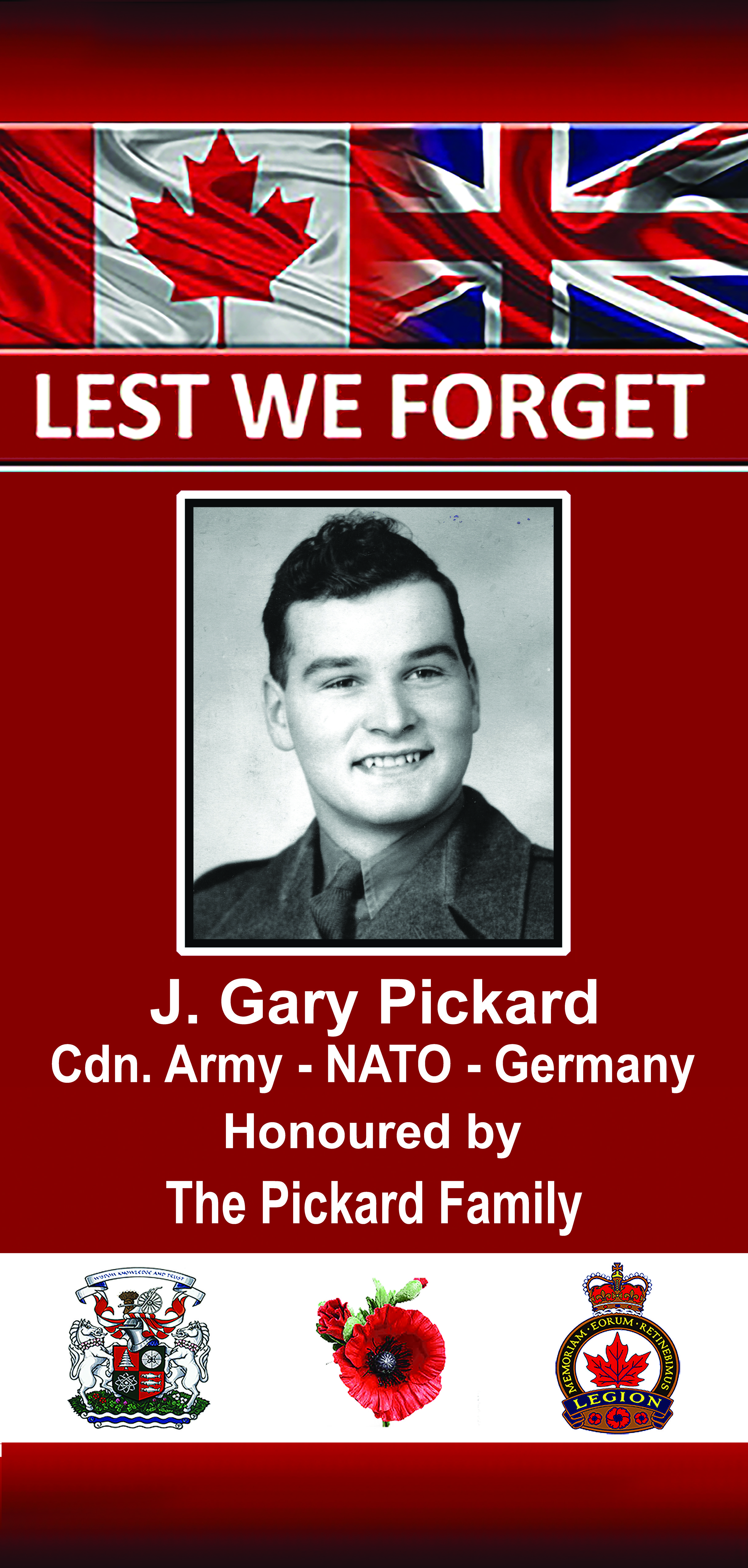 |
| Oscar R. Pingle |
O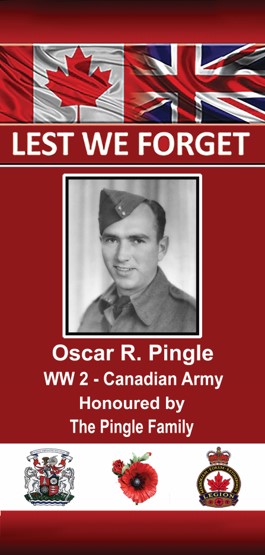 scar Russel Pingle was born on January 30, 1915 in Hansworth, Saskatchewan to Walter & Luella Pingle, the oldest of seven siblings. His father Walter had been born and raised in Bowmanville, moved out west, met and married Luella, and farmed near the town on Stoughton. Oscar was educated in Saskatchewan, along with his brothers and sisters. The Great Depression was not kind to prairie farmers, the family forced to pull up stakes and return to Bowmanville. Oscar was in his early 20’s at the time of this relocation. The family farmed on a rented property near the Bowmanville Boys Training School, Oscar also picking tobacco at local tobacco farms, of which there were quite a few in those days. He eventually found employment at the Goodyear plant in New Toronto. scar Russel Pingle was born on January 30, 1915 in Hansworth, Saskatchewan to Walter & Luella Pingle, the oldest of seven siblings. His father Walter had been born and raised in Bowmanville, moved out west, met and married Luella, and farmed near the town on Stoughton. Oscar was educated in Saskatchewan, along with his brothers and sisters. The Great Depression was not kind to prairie farmers, the family forced to pull up stakes and return to Bowmanville. Oscar was in his early 20’s at the time of this relocation. The family farmed on a rented property near the Bowmanville Boys Training School, Oscar also picking tobacco at local tobacco farms, of which there were quite a few in those days. He eventually found employment at the Goodyear plant in New Toronto.
On May 18, 1942, Oscar volunteered for service in WW2, at 27 years of age. The enlistment centre was in Toronto, he probably underwent basic training on the CNE Grounds. At some point he was earmarked for the Royal Canadian Ordinance Corps (RCOC). Historically, this was the unit that procured all the material goods required by the Army, from clothing to weapons. Up until 1944, the RCOC was responsible for maintenance and repair. Oscar must have had a mechanical background, this skill set much in demand for a modern, mechanized army. With the increase of mobile equipment during World War II, the need for mechanics to service and maintain motorized equipment was becoming increasingly apparent. Trucks had become the de facto means of transportation and logistic support, and armoured vehicles had replaced cavalry. Oscar took further training in Kingston, Ontario before shipping out overseas to the UK. The invasion of Sicily and subsequent conflict on the Italian mainland, started in July of 1943. Oscar was a member of the RCOC corps selected to support this operation. He would have been on constant duty maintaining and repairing mechanized transport and armoured fighting vehicles damaged and ravaged by battlefield action. In total, he spent one and a half years in Italy, before being switched over to the conflict in Northwest Europe in January or February of 1945. During this time, on February 22, 1944, the RCOC and two other specialized units were merged to form the Royal Canadian Electrical and Mechanical Engineers (RCEME). The name change meant little to the specialists who at that time were engaged in the field, probably not even aware of this until long after. Oscar would have seen additional action in France, perhaps the low counties of Belgium and Holland, and finally Germany itself. He remained working in Europe and the UK after the conclusion of fighting, finally returning to Canada and being discharged on December 8, 1945. He returned to work for Goodyear, only this time in Bowmanville, also helping out on the farm with his father and family. The Veterans’ Land Act permitted ex-servicemen to purchase property with only a small down payment coupled with the assistance of a government loan. A dairy farm was purchased near the intersection of Taunton and Courtice Rds., the present site of Pingle’s Farm Market. He met and married Phyllis Frederickson, a Manitoba girl who had relocated to Oshawa to work in wartime production at the Duplate plant. She came from a family of eleven siblings, sending money back to support her family. The marriage took place on February 28, 1947, they would raise six children. Oscar retired from fulltime farming in 1974, then assisting his son, who took over the farm, on a parttime basis, and driving a school bus. He reconnected with a son that he had fathered while in the UK, and this relationship has thrived with the family siblings and their half-brother. He spent as much time as possible enjoying his grandchildren and summering at the cottage on Stony Lake. Oscar was an active member of the Bowmanville Legion, and also a member of the unofficial town council which met regularly around the round table at the rear of Johnny Seto’s Coronation Restaurant. Oscar passed away on October 26, 1999 at the age of 84 years. |
| William Thomas Potter |
|
William (Bill) Potter was born on September 4, 1923, in the village of 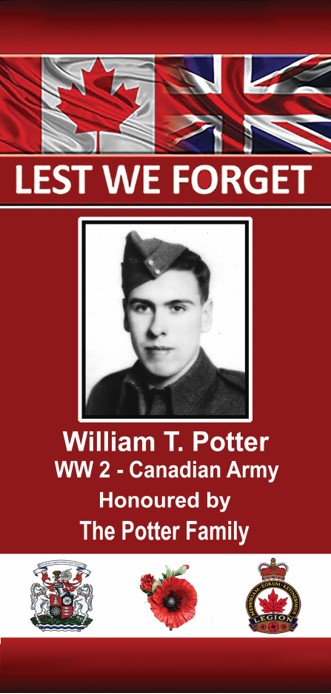 Enniskillen, to Lorne and Ada Potter. They raised a family of eighteen siblings, Bill having six brothers and eleven sisters. Enniskillen, to Lorne and Ada Potter. They raised a family of eighteen siblings, Bill having six brothers and eleven sisters.
He was educated at Central Public School and Bowmanville High School and then worked briefly at Oshawa Wood Products. In July 1942, at 18, he enlisted for service in the Canadian Army. Bill trained with the Midland Regiment, Second Reserve Battalion at Ottawa’s Connaught Camp. The Midland Regiment was primarily composed of recruits from Durham and Northumberland Counties. In the Second World War, it served as a reserve unit, principally performing domestic duties, trained to guard critical infrastructure and repel invasion. This unit saw no active overseas service, but many of its trained recruits were assigned to other active units. Bill was reassigned to the Lorne Scots, a regiment mainly composed of Peel, Halton and Dufferin Counties recruits. Training took place at the Canadian Active Service Force (CASF) Base nearby Liverpool, with all units attending amalgamated into the First Canadian Army. His unit was known as the First Canadian Corps Defence Company. Their responsibility was the ground defence of headquarter locations from which the order of battle was conducted. Bill’s unit arrived in Normandy in July of 1944, after the D-Day Invasion. For the following ten months, the First Canadian Army was involved in clearing the enemy from Normandy, taking channel ports, the Battle of the Scheldt in Belgium, removing the Nijmegen Salient in the Netherlands, forcing into Germany in the Battle of the Rhineland, and finally liberating the northern part of Holland. The First Canadian Army established four different HQs in North-West Europe. On January 4, 1946, Bill returned home and resumed employment with Oshawa Wood Products. On June 6, 1948, He married Florence Heath, raising one daughter. Bill died on September 30, 1968, at 45, from a heart attack. |
| Cyril Quinney |
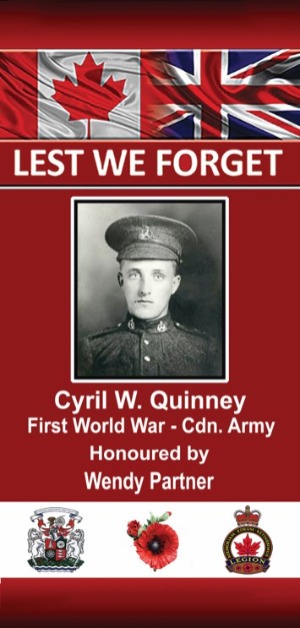 Cyril Quinney was born in 1897, on a farm north of Bowmanville, in Clark Township. In June 1916, at 19, Cyril enlisted with Bowmanville's 235th Battalion. When he volunteered, he knew thousands of Canadians had already died or been injured in some of the most famous battles in Canadian military history. Cyril Quinney was born in 1897, on a farm north of Bowmanville, in Clark Township. In June 1916, at 19, Cyril enlisted with Bowmanville's 235th Battalion. When he volunteered, he knew thousands of Canadians had already died or been injured in some of the most famous battles in Canadian military history.
Cyril arrived in Liverpool in May 1917 and was assigned to the 134th Battalion at Camp Witley. This is possibly the same camp that his son, Howard Quinney, would have been dispatched to 25 years later when he joined the Canadian Army in Holland during the Second World War. On February 28, 1918, Cyril joined the 4th Canadian Mounted Rifles (4th CMR), a storied regiment that had already taken part in iconic Canadian battles at Vimy Ridge and Passchendaele. He would have shared in the emerging national pride and the growing sense that Canada was becoming a distinct country, separate from England and barely more than 50 years old. Cyril saw some of the bloodiest battles in which the Canadian Corps engaged in the final days of the First World War. The first was the Battle of Amiens from August 8 to 14, 1918. At Amiens, Cyril witnessed the beginning of the end for the German Army. German forces suffered a stunning setback there, mainly at the hands of the Canadian Corps, who met and defeated elements of fourteen German divisions. Cyril likely encountered gas attacks, hand-to-hand combat, machine-gun fire, and artillery bombardment during the Amiens campaign. On August 28 at Boiry, the 4th CMR was part of the Allied effort to break through the Hindenberg Line - a series of German trenches 30 kilometres deep along the Canadian section of the Western Front. It was the most heavily defended part of German defences along the front. The German high command knew they would have to hold it or lose the war. The 4th CMR was assigned to break the formidable Fresnes-Rouvroy trench making up part of the Hindenberg Line. Unfortunately, a bullet grazed Cyril's neck during that battle and struck another young Canadian standing directly behind him. That boy died instantly. Cyril was evacuated to a Canadian Casualty Assembly Centre behind Canadian lines with a wound to the neck. From there, he went back to England to recover. With Armistices declared ten weeks later, Cyril was sent back to Canada and discharged from the army in January 1919. On his return to Bowmanville, Cyril met and married Alice Gwilliams. They set up residence on Duke Street, raised seven children, and became grandparents to many more. In civilian life, he worked on the Grand Trunk Railroad until he retired in the late 1950s. He was a proud man and enjoyed life to the fullest. He died in 1966. He was 69. |
| Howard W. Quinney |
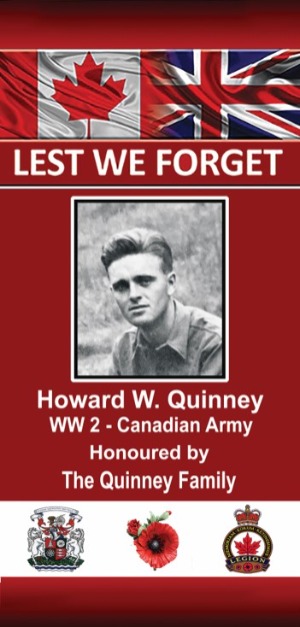 Howard Quinney was born on March 6, 1924, to Cyril and Alice Quinney, Bowmanville residents who raised a family of seven siblings. The family lived on Duke Street during the height of the Great Depression, and the children attended local schools. Howard’s father, Cyril, was a First World War veteran and worked for the Grand Trunk Railway. Howard Quinney was born on March 6, 1924, to Cyril and Alice Quinney, Bowmanville residents who raised a family of seven siblings. The family lived on Duke Street during the height of the Great Depression, and the children attended local schools. Howard’s father, Cyril, was a First World War veteran and worked for the Grand Trunk Railway.
In 1941, at 17, Howard enlisted in the Canadian Army and joined the Royal Canadian Ordnance Corps (RCOC) at Camp Borden, an administrative corps of the Canadian Army. They procured all the materials required by the Army, from clothing to weapons. Up until 1944, the RCOC was responsible for maintenance and repair. Ordnance Field Parks carried everything from spare parts to spare artillery and supported the active Divisions and Corps. In February 1944, a reorganization of the Canadian Army Corps took place. The Ordnance Corps were combined with the Royal Canadian Engineers and the Royal Canadian Army Service Corps, forming a new unit named the Royal Canadian Electrical and Mechanical Engineers. While most enlisted soldiers desired action, this logistics role was vital to the war effort, providing critical support for the frontlines. In January 1945, Howard and his newly designated unit were sent to the Netherlands; at that time, the main Canadian effort was focused on the liberation of Holland. While Howard did not see any action, his knowledge and expertise supported the overall war effort. He returned to Canada in July 1945 and was demobilized on October 23. Howard settled in Newcastle with his wife Kathleen (nee Fenton) in 1956 to raise a family. He was a barber for many years before he and Kathleen established small town department stores under the Stedmans franchise in Newcastle and Bowmanville. Howard and Kathleen are remembered in Newcastle for their volunteer efforts. Kathleen mentored many Newcastle girls as a Girl Guide Leader, and Howard was involved with the Lions, the Masons and the Newcastle Chamber of Commerce. He loved hockey and played the game right up until he died on March 17, 1999. He was 75. Howard won many scoring titles playing in the Newcastle Town League and was reputed to have the sharpest elbows in the league. He was a good man who performed his duty to his country and his community throughout his life. |
| Alexander (Scotty) Reid |
Biography coming soon. -Reid.jpg) |
| John S. Rowlands |
|
On October 3, 1945, John Rowlands was born to Frank and Dorothy 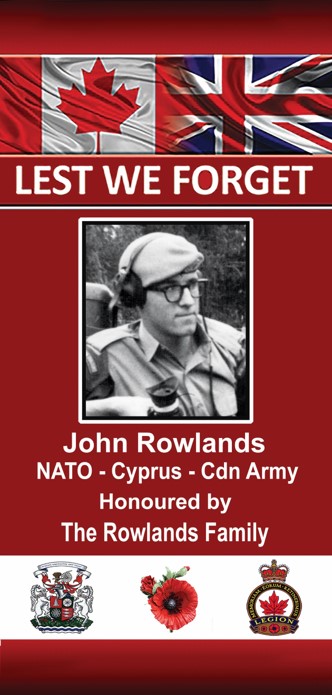 Rowlands. His father ,Frank, was an immigrant from Liverpool, England, who came to Ontario as a farmworker. They raised eleven children while working as a blacksmith at the Burwash Industrial Farm near Sudbury. In essence, Burwash was a correctional centre, a provincial jail where the inmates could receive an education and learn a trade. Rowlands. His father ,Frank, was an immigrant from Liverpool, England, who came to Ontario as a farmworker. They raised eleven children while working as a blacksmith at the Burwash Industrial Farm near Sudbury. In essence, Burwash was a correctional centre, a provincial jail where the inmates could receive an education and learn a trade.
John and his siblings grew up in this environment and were educated at a school on the farm, but attended the last two years of high school in Sudbury. In 1961, John joined the Army Reserves, part of the 2nd Battalion, Irish Regiment of Canada. In 1963 the family moved to Brantford, Ontario, where Frank worked at the Burtch Correctional Centre. That same year, John enlisted in the regular forces in Brantford. He went to an armour corps school in Camp Borden, and in March 1964, he was assigned to the Royal Canadian Dragoons stationed in Gagetown, New Brunswick. Between October of 1965 and April of 1966, his unit was part of Cyprus's United Nations Peacekeeping Force. The mission was to prevent a recurrence of fighting following intercommunal violence between the Greek Cypriots and Turkish Cypriots. In addition, they contributed to the maintenance and restoration of law and order and facilitated a return to normal conditions. John returned to Brantford in September of 1966, where he met and married Joan Steed and raised a family of three girls. John worked locally, eventually finding employment as a correctional officer at the Burtch Correctional Centre in 1971. In 1978 he moved to Bowmanville, transferring to the Whitby Jail, and in 1991, he transferred to the Ontario Provincial Bailiffs, retiring in 1998. John and his wife Joan still reside in Bowmanville, as do one of his daughters and two grandchildren. |
| Ben Severs |
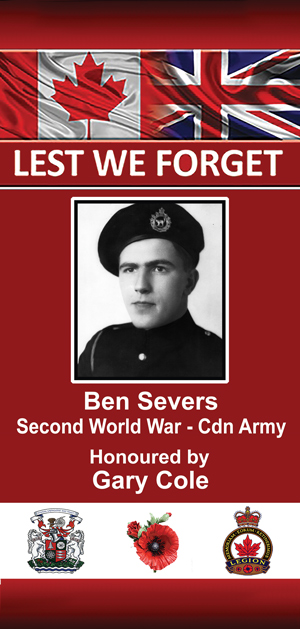 Ben Severs was born in Oshawa on August 25, 1922, after his family emigrated from England. They raised Ben, the youngest of his two brothers and sisters, in Oshawa. He attended O’Neil Collegiate Secondary School, although he never completed high school as he enlisted in September 1939. Ben Severs was born in Oshawa on August 25, 1922, after his family emigrated from England. They raised Ben, the youngest of his two brothers and sisters, in Oshawa. He attended O’Neil Collegiate Secondary School, although he never completed high school as he enlisted in September 1939.
Ben was assigned to the 11th Armoured Ontario Regiment and received tank training at Base Borden. However, he was not fond of driving tanks and compared them with driving around in a cement mixer. He soon transferred to the Lincoln and Welland Regiment. Since Ben was not yet 18, he was not immediately sent overseas and started out guarding various bases in Newfoundland. During this time, he met and married Jean Ferguson. Four days after his wedding in Halifax, he was shipped out to England. His training base was in Sussex, England, where he was assigned to the 4th Canadian Armoured Division. In August of 1941, he participated in Operation Claymore, a raid on the Norwegian island of Spitzbergen. Control of this island was crucial to the northern convoy routes to Russia. Ben’s unit landed in Normandy a few days after the D-Day invasions and engaged in battles that took them from Caen to Falaise in northwest France. Next, they pushed into Belgium, where Ben received wounds at the battle for the Leopold Canal. After treatment, he returned to his unit, which by now had advanced into Holland. He was the only one out of five soldiers aboard a Bren Gun Carrier in Holland to survive an enemy attack, although he was seriously injured. He was evacuated to a hospital in Aldershot, England, to heal and eventually return home. War in the European Theatre ended in May 1945 when Ben and several other recuperating soldiers were still in hospital and anxious to get home. Acts of civil disobedience occurred to stress their frustrations, which resulted in them being sent home in July of 1945. Ben was honourably discharged in September 1945, a full six years after he enlisted. Finally reunited with his wife in Ontario, they settled in Ajax and raised their two sons and daughter. Ben worked various jobs at General Motors and Doughty Equipment before becoming a permanent firefighter with the Ajax Fire Department, and even served as a councillor. He was one of the founders of the Ajax Branch of the Royal Canadian Legion. At his funeral service, his son eulogized him as a good husband, father, soldier, and very good man. His connection to Clarington is his nephew Gary Cole, a Bowmanville native and lifelong resident. |
| Melvin R. Shafer |
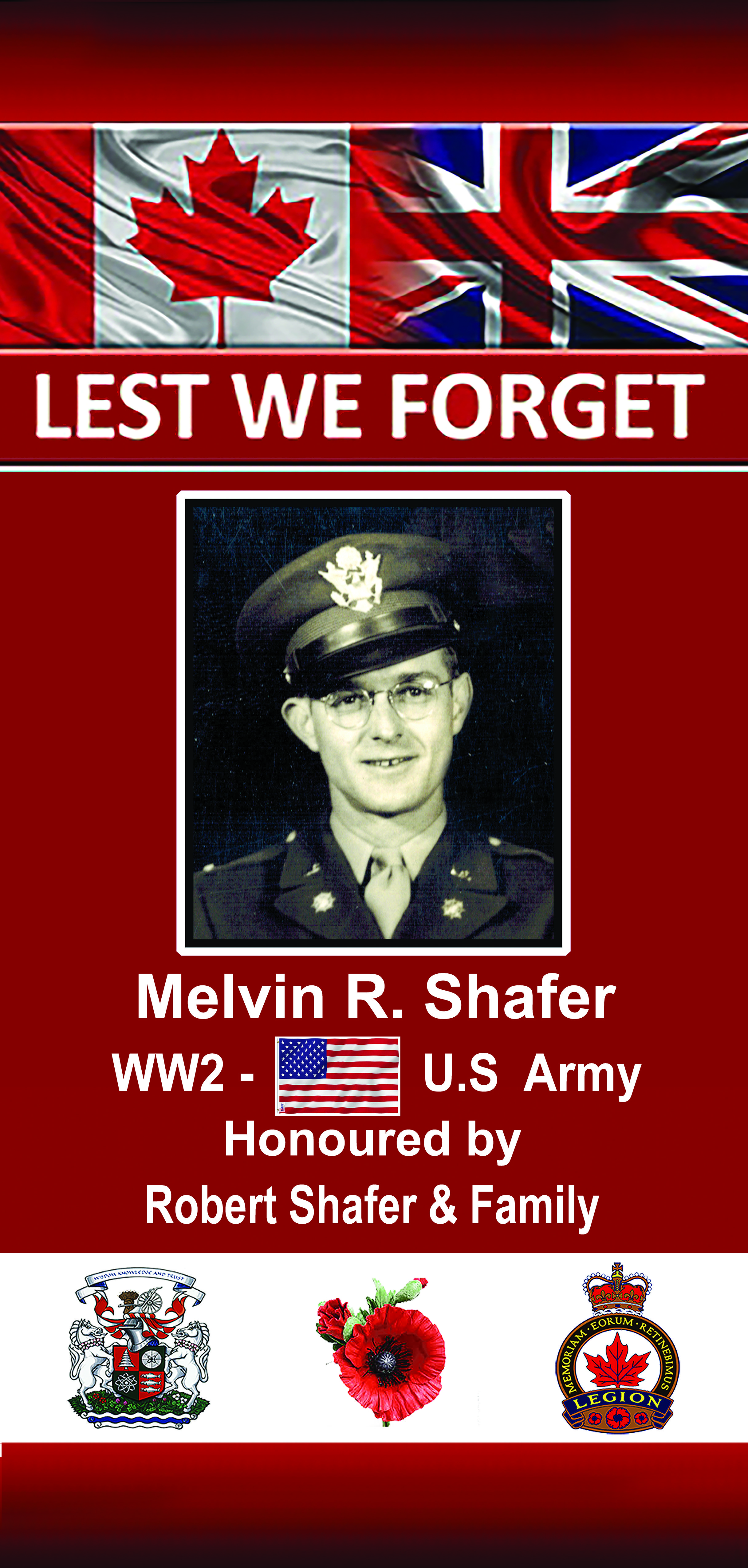 Melvin Raymond Shafer was born on May 26, 1912 in Hastings, Nebraska. His parents, Mabel & John Shafer, although of German heritage, had emigrated to the area from Russia, raising three children. Nebraska is primarily agrarian, however the town of Hastings was a railroad hub, the intersection of two major railways. Melvin’s father worked as a roundhouse foreman for the Burlington, Northern and Santa Fe railway, young Melvin exposed to the railway yard and its operations early in life. Melvin was educated locally, then attending college. Upon graduation, he found employment in a clothing store. Melvin Raymond Shafer was born on May 26, 1912 in Hastings, Nebraska. His parents, Mabel & John Shafer, although of German heritage, had emigrated to the area from Russia, raising three children. Nebraska is primarily agrarian, however the town of Hastings was a railroad hub, the intersection of two major railways. Melvin’s father worked as a roundhouse foreman for the Burlington, Northern and Santa Fe railway, young Melvin exposed to the railway yard and its operations early in life. Melvin was educated locally, then attending college. Upon graduation, he found employment in a clothing store.
The United States entered WW2 as a result of the attack that took place at Pearl Harbour on December 7, 1941. Melvin immediately enlisted for service at the age of 29 years. He was posted to the Hancock Field Army Air Base at Syracuse, New York. At that time, the Air Force was part of the U.S. Army, the USAF did not become a sole military entity until 1947. First phase pilot training for recruits did occur at this location, but Melvin’s eyesight precluded him from this. However, the main function of this base was a staging area for bomber aircraft, B17s and B24s, transports and many other types of aircraft, being prepared for the long hop across the Atlantic. This was a logistical function and no doubt, Melvin was good at this job, his proficiency led to being earmarked for officer training. While serving at this base, he met a local girl, Winnifred Hadfield, and they would eventually marry in October of 1944. After successfully completing the Officer Candidate Training Course at Camp Claiborne in Louisiana, Melvin was assigned to the US Army Transportation Corps, headquartered at Fort Eustis, Virginia. This corps is a combat service support branch of the U.S. Army, responsible for the movement of personnel and material by truck, rail, air, and sea. By the end of the war the Transportation Corps had moved more than 30 million soldiers within the continental United States; and 7 million soldiers plus 126 million tons of supplies overseas. In March of 1945, Melvin was sent to Strasbourg in war torn France as a member of the 766 Railway Battalion. One of the greatest feats of the Transportation Corps, via the Military Railway Service, was the rebuilding of France's shattered railroad network after D-Day, and the transportation of 1,500 locomotives and 20,000 railway cars specially built for the lighter French track system. To speed the process, and avoid delays caused by French channel ports and docks destroyed by the retreating Germans, the Transportation Corps brought the heavy railroad stock across the channel and across the beaches in specially built landing ships. Upon returning home, Melvin remained in the reserves until his discharge on April 1, 1953. He went to work as an estimator for a small iron works company in Syracuse, and by 1973 he was the president of this firm. The family increased with two children. Fishing was a pastime he enjoyed, he belonged to the Masonic Lodge and volunteered his time with the Boy Scouts organization. Melvin passed away in Syracuse in 1980, 68 years of age. His connection to Clarington? His son, the present owner/operator of the Tyrone Mill, and two grandchildren are Clarington residents. |
| Arthur Sheehan |
-Sheehan.jpg) Arthur William (Sonny) Sheehan was born on July 8, 1922, in Bowmanville to Lillian and Thomas Sheehan. His widowed mother raised the family of five boys and two girls while living in an upper story apartment on King Street in Bowmanville, cleaning houses to make ends meet. Sonny was educated locally in town and found employment at the Goodyear plant after leaving high school. Arthur William (Sonny) Sheehan was born on July 8, 1922, in Bowmanville to Lillian and Thomas Sheehan. His widowed mother raised the family of five boys and two girls while living in an upper story apartment on King Street in Bowmanville, cleaning houses to make ends meet. Sonny was educated locally in town and found employment at the Goodyear plant after leaving high school.
Sonny enlisted to serve in the Second World War on January 19, 1942, at 19. He was assigned to and saw action with the 1st and 2nd Canadian Survey Regiments as a despatch rider. Survey troops were attached to Artillery Field Batteries, assisting with spotting enemy artillery. These units were critical and employed when the front became static, holding up the advances of the infantry. Observers of gunshot flashes from three different points (forward units) would provide reference points using triangulation for their artillery regarding the location of enemy guns. The despatch rider, on a motorcycle, co-ordinated communications between forwarding observers and delivered findings to artillery field units. Sonny went ashore in France after D-Day and supported the artillery of the 1st Canadian Division in both France and Germany. He was demobilized in 1946 and returned home to the Goodyear plant until he retired in 1978. He married Nyhl King and raised one daughter, Carol. Utilizing the Veterans Land Act, they built a home on Lambs Lane in Bowmanville. Sonny died on April 29, 2007. He was 84. The Juno Beach Centre is a Canadian Second World War Museum located in Courseulles-Sur-Mer, Normandy, France. It was opened in 2003 by veterans and volunteers with a vision to create a permanent memorial to all Canadians who served during the Second World War. The Centre’s mandate is to preserve this legacy for future generations through education and remembrance. In addition, several kiosks contain donated commemorative bricks paying tribute to individual veterans, with one of them bearing Arthur’s name. |
| Arthur H. Trewin |
|
Arthur (Art) Henry Trewin was born October 11, 1913, to William and 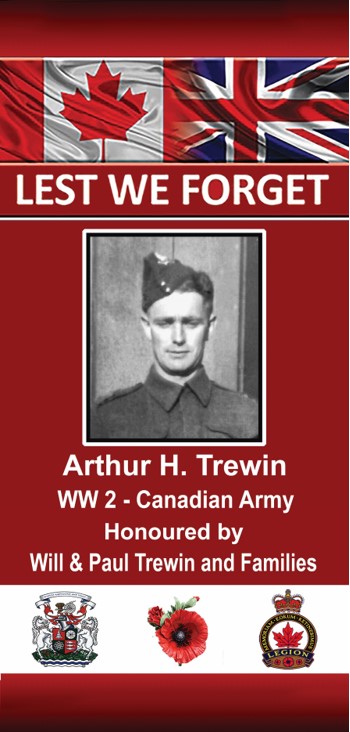 Ida Trewin, in Enniskillen, Ontario, the house immediately south of theEnniskillen General Store. He was the fourth child of 10 siblings. Ida Trewin, in Enniskillen, Ontario, the house immediately south of theEnniskillen General Store. He was the fourth child of 10 siblings.
A year or so later, the family moved to the hamlet of Haydon into a house where Graham’s Garage stands, now occupied by the Oshawa Car Club. He was educated locally, and at 16, he started to work as a farm labourer on various local farms. This was quite common for the older children in large families during the depression years of the 1930s, as their modest incomes were used to support the family. He worked three years on the Mountjoy farm east of Haydon, then three years on the Macklin farm near Tyrone. He moved on to other farms on Scugog Island, Whitby and Brooklin. In October of 1940, he found employment at General Motors in Oshawa. On November 15, 1942, at 29, he enlisted in the Second World War with the Canadian Army. They sailed to England and trained in and around Haslemere, Trowbridge, Lynbrook, and the Salisbury Plains during 1943. He was assigned as a gunner to the eighth Light Anti-Aircraft Regiment of the Royal Canadian Artillery. While in the UK, these anti-aircraft units were frequently utilized on the eastern coastlines and at war production centres to counter German Luftwaffe bombing raids. In June 1944, they went across the English Channel in barges and landed on Juno Beach two days after D-day. He said that the water was red with blood when they arrived. They were involved in actions seizing the town of Caen, which was completed on August 6, 1944. Immediately launched after that was Operation Totalize. The intention was to break through the German defences south of Caen on the eastern flank of the Allied positions in Normandy and exploit success by driving south to capture the high ground north of the city of Falaise. Art’s unit was part of the effort to close the Falaise Gap, resulting in the encircling and surrendering of 80,000 German Troops by mid-August. In September 1944, the next task was to clear the Channel ports on the French coast as part of the Second Canadian Corps. By this point, the destruction of the Luftwaffe was almost complete; most anti-aircraft personnel were then assigned to assist the infantry brigades. Art was in Calais, holed up in an old bus station when allied planes went over and dropped bombs near them. Art was hit in the shoulder by a piece of brick. He fully recovered and carried on, but a hip injury from moving an artillery gun would bother him for the rest of his life. Canadian troops continued along the coasts of both Belgium and Holland, finally clearing the Scheldt Estuary. Inland, Art participated in Operation Plunder, crossing the Rhine River in the central Netherlands. With the cessation of the war, Art returned home in 1945. He purchased the family farm north of Haydon not long after returning home and started farming. In 1950 he went back and worked at General Motors. Art met June Anderson, who was teaching school in Haydon; they were married in July 1951 and had two sons, William and Paul. Art worked for the Ontario Hydro forestry crew from March 1956 until June 1966, when he became a janitor at Bowmanville High School. In the fall of 1966, Ontario Hydro hired him as a maintenance man at their substations, and he worked there until he retired in 1976. Art and June stayed on the farm until he died on March 7, 2016, at 103. |
| Cliff Trewin |
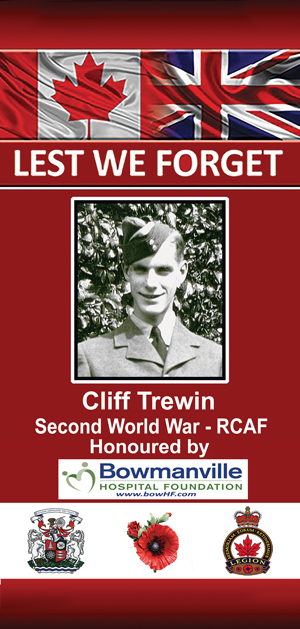 Clifford Trewin (Cliff), a lifelong Clarington resident, was born in Darlington Township on May 28, 1925, in the village of Haydon, or as he refers to it, the mighty metropolis. His father, William Trewin, managed a local farm to support his wife Ida (nee Stainton) and their 10 children. Cliff attended elementary school in Haydon and his first two years of high school in Enniskillen, finishing at O’Neill Collegiate in Oshawa. Clifford Trewin (Cliff), a lifelong Clarington resident, was born in Darlington Township on May 28, 1925, in the village of Haydon, or as he refers to it, the mighty metropolis. His father, William Trewin, managed a local farm to support his wife Ida (nee Stainton) and their 10 children. Cliff attended elementary school in Haydon and his first two years of high school in Enniskillen, finishing at O’Neill Collegiate in Oshawa.
In 1942, at 17, he enlisted to serve in the Second World War. He was assigned to the Midland Regiment and opted to join the Royal Canadian Air Force. He trained in gunnery and bombing in Toronto at Exhibition Park and at bases at Fingal in Ontario, Greenwood in Nova Scotia, Summerside in Prince Edward Island and Goose Bay in Labrador. In October 1943, he was shipped overseas to a base in Bournemouth, England and transferred to Elsham Wolds, where he flew all his operational sorties (missions). Cliff participated in 31 missions as a bomb aimer on a Lancaster Bomber aircraft. In January 1944, after being crippled by enemy flak, his aircraft went down into the North Sea. All seven crew members managed to bail out and scramble aboard a rubber life raft. A Norwegian fishing vessel rescued them and safely returned them to England. Cliff doesn’t dwell on many particulars of his wartime experiences. He considers himself fortunate to have returned home when many aircrews did not. However, there is one mission that Cliff does talk about — an operation named Manna. During the last couple of weeks of the Second World War, fighting was raging in Holland, and the population was suffering from a famine, resulting in thousands of deaths. With the reluctant agreement of the occupying enemy forces, all fighting ceased, permitting bomber aircraft to drop food and medical supplies to the starving Dutch peoples. Cliff marvelled that the war could be turned on and off like a switch. Cliff returned home in February 1946 and was decommissioned in May of that year. He worked at the Bowmanville Training School and took extension courses from McMaster University for labour and industrial relations, which helped him gain employment at General Motors in the labour relations section. Eventually, he worked in the security department until he retired in 1982. Cliff married Aura Prout in 1946 and had one son. Three of his brothers also served during the Second World War. Cliff died on April 21, 2022, at the age of 96. |
| Reid H. Virtue |
Biography coming soon. 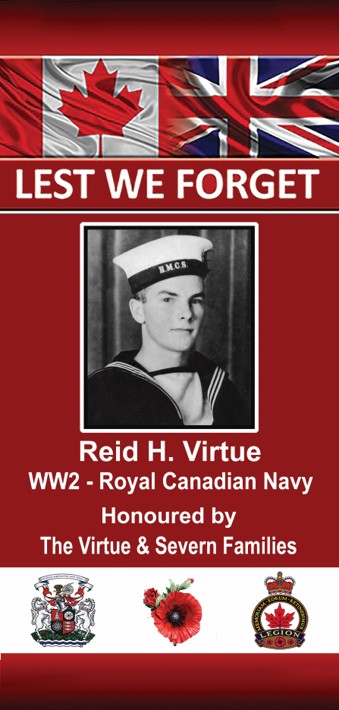 |
| W. R. Glenn Virtue |
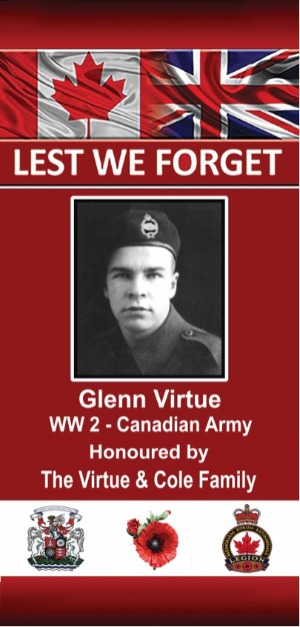 William Russel Glenn Virtue, known as Glenn to his family and friends, was born in Bowmanville on March 25, 1923, to William and Rosamond (nee Howard) Virtue. Glenn had one brother and four sisters and was raised on Scugog Street during the height of the Great Depression. His father, a First World War veteran, owned and operated Virtue’s Parts & Service, an auto garage in Bowmanville. Glenn was educated at local elementary and secondary schools. William Russel Glenn Virtue, known as Glenn to his family and friends, was born in Bowmanville on March 25, 1923, to William and Rosamond (nee Howard) Virtue. Glenn had one brother and four sisters and was raised on Scugog Street during the height of the Great Depression. His father, a First World War veteran, owned and operated Virtue’s Parts & Service, an auto garage in Bowmanville. Glenn was educated at local elementary and secondary schools.
On April 24, 1942, at 19, Glenn volunteered to serve in the Second World War in Kingston. He was assigned to The Canadian Grenadier Guards, a Montreal-based unit with a long and storied past in Canadian history and the second most senior regiment in the Canadian Army. It was first formed in 1859 to counter the threat from Fenian Raids in the southern areas of Quebec. It served with distinction in both the Boer War and the First World War. A Grenadier was a specially trained infantryman equipped to launch and throw small bombs or grenades. In the Second World War, the face of battle had dramatically changed. There would be no static fighting from the trenches as more modern weaponry created the ability to move the fronts, pushing back the opposing enemy. The infantry was still important, but now they were supported with armoured vehicles, more powerful and punishing artillery and aggressive air cover. This required more personnel dedicated to these functions, and the Grenadier Guards were one of the units re-designated, becoming the 22nd Armoured Regiment in November 1940. After initial training in Quebec, Glenn’s unit was shipped to England on September 25, 1942. He trained as a tank operator/mechanic at several bases in England and Scotland, and during this time, he met and married Joan Martin. His unit, the 4th Armoured Brigade of the 4th Armoured Division was deployed to Normandy on July 21, 1944. The unit fought until VE Day on May 8, 1945, through the battles around Falaise, the move into Belgium and the Netherlands, and finally across the Rhine into Germany, earning 12 Battle Honours. Glenn was a boxer and won his brigade title while serving in the Netherlands. After victory in Europe, the unit was allocated for the war in the Pacific, to fight on the islands of Japan, but this conflict ended before his unit could be deployed overseas. Glenn was demobilized on January 25, 1946. His family had expanded to three by the time of his return to Bowmanville, with a daughter born in England in March 1945, and they would also add a son, born in 1948. Glenn worked at the Specialty Paper Company on Temperance Street as an engineer/mechanic, maintaining the production machinery and remained there until his death on July 25, 1978. He was 54. Glenn played the fiddle and took part in many local events. He was a member of Branch 178 of the local Royal Canadian Legion. When their Queen Street building expanded in the 1950s with an addition at the rear, Glenn and three other veterans each took a beer bottle and cemented them into the four corners of the new foundation. |
| James H. G. Wallace |
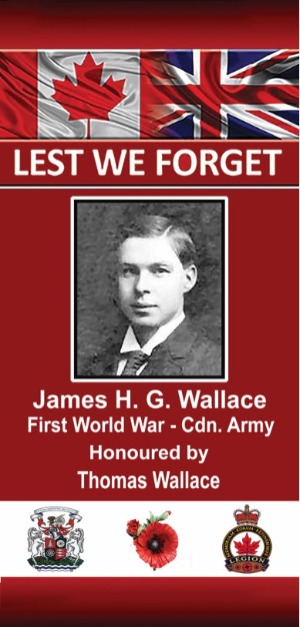 James Wallace was born on December 19, 1885, to Nathaniel and Belinda (nee Gilmore) Wallace. His father, the Honourable Nathaniel Clarke Wallace, was a Member of Parliament for York West from 1878 until he died in 1901. James was raised in Woodbridge with eight siblings and was a prolific sportsman and a lacrosse player with provincial teams. He attended Trinity College at the University of Toronto, where he obtained his undergraduate degree. James Wallace was born on December 19, 1885, to Nathaniel and Belinda (nee Gilmore) Wallace. His father, the Honourable Nathaniel Clarke Wallace, was a Member of Parliament for York West from 1878 until he died in 1901. James was raised in Woodbridge with eight siblings and was a prolific sportsman and a lacrosse player with provincial teams. He attended Trinity College at the University of Toronto, where he obtained his undergraduate degree.
James graduated from Osgoode Hall School of Law in 1908 and became a barrister. In addition to his legal career, James served with two local military units: three years with the 36th Peel Regiment and with the 12th York Rangers as an officer, Lieutenant Wallace. On December 24, 1915, at 30, he volunteered to serve in the First World War with the 127th York Rangers Overseas Battalion of the Canadian Expeditionary Force. Before leaving, James married Kathleen Hartney on July 29, 1916. James and Kathleen arrived in England on August 23, 1916. Usually, a large group of boys from the same town were not allowed to fight together to minimize the impact on the community at home if they suffered mass casualties. Yet, the 127th York Rangers Battalion was kept intact and became the 2nd Battalion Canadian Railway Troops. They built light railway lines close to the front for the rapid movement of troops and supplies from established railway heads. By the end of the war in 1918, Canada had contributed thirteen battalions of railway troops, the only nation possessing this capability. On January 12, 1917, the 2nd Battalion arrived in France. They supported Canadian troops at Vimy Ridge in April of that year and again at Passchendaele in October, where James was severely injured in a poison gas attack. The strenuous conditions took a toll on James, and the recurrence of his phlebitis and the inflammation it caused proved disabling. He was sent back to England on October 29, 1917, declared unfit for service on November 17 and returned to Canada on December 1. They returned as a family of three, welcoming their daughter on September 15 in England. James returned to his legal practice and had two more sons. He died on January 15, 1929, in Toronto due to heart trouble attributed to overseas war service. He was 44. James’ family purchased a summer home in the Village of Newcastle, where his son Tom met and married Mary Toms. They raised their family of five from 1952 until they returned to Toronto in 1964, and to this day, the family continues to holiday at the summer home. |
| Blake N. Walls |
|
Blake Noel Walls was born on June 20, 1921, to John and Rebecca Walls 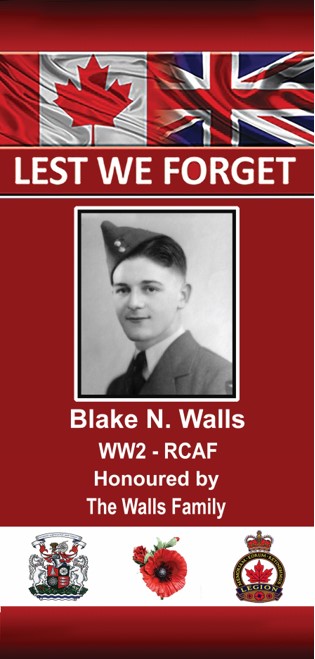 of Parham, Ontario, a rural community north of Kingston. The family relocated to Oshawa after the birth of their second child so that John could get a more permanent job at General Motors (GM). Growing up in Oshawa, Blake was very active in hockey and baseball at competitive levels. He went to Westmount Public School and O’Neill Collegiate. He spent summers in Parham on the farm, where the work was hard—stacking hay after raking it up and pitching it twice your height onto a wagon, piling cordwood to the ceiling of the village shed and bagging 100-pound bags of grain at the feed store. of Parham, Ontario, a rural community north of Kingston. The family relocated to Oshawa after the birth of their second child so that John could get a more permanent job at General Motors (GM). Growing up in Oshawa, Blake was very active in hockey and baseball at competitive levels. He went to Westmount Public School and O’Neill Collegiate. He spent summers in Parham on the farm, where the work was hard—stacking hay after raking it up and pitching it twice your height onto a wagon, piling cordwood to the ceiling of the village shed and bagging 100-pound bags of grain at the feed store.
After graduating high school, Blake put in for the Office Executive training program at General Motors. He spent eight months there, then with a promise to keep his job open at GM, he enlisted in the Royal Canadian Air Force (RCAF) at 18. Blake’s billet was a livestock stall inside the Coliseum Building on the CNE grounds. Here they learned military methods to bathe, shave, shine boots, polish buttons, maintain their uniforms, and otherwise behave in the required manner. There were two hours of physical education every day and instruction in marching, rifle drill, foot drill, saluting, and other routines. After four or five weeks, a selection committee would decide whether the trainee would be placed in the aircrew or groundcrew stream. Blake was sent to air gunnery training at Mountain View, a base situated in Prince Edward County south of Belleville. It was the beginning of the British Commonwealth Air Training Plan (BCATP), the instructors mainly from Britain. Blake was assigned to the 119 Bombing Reconnaissance (BR) Squadron and stationed at Sydney, Nova Scotia. The principal task of this unit was anti-submarine patrol over the Atlantic waters of the coastline and Gulf of St. Lawrence, where German U-boat attacks in the Gulf had become a severe problem. Blake tells the story of a nightclub at St. Flavie, Quebec, with a dance floor on stilts on the St. Lawrence shoreline. One night a German U-boat surfaced, and its crew watched the dancing on their deck. Blake then became an air gunnery instructor at Mont Joli, Quebec, teaching recruits how to fire the twin browning and fire from a plane. Blake was stationed at RCAF Gander, Newfoundland, in his final three years of service. After the war, Blake went to Halifax, where he met Irene, whom he married before coming home. He was also offered a job playing for the New Glasgow Bombers, a Senior A hockey team. The position paid $300 a month, and he had to make appearances as a non-functioning foreman of a coal mine. Blake turned the job down and returned to the security of General Motors in Oshawa for one-third of the salary. Irene helped him save his money, and they were able to build their own house where they raised three children Pat, Mike and Chris. Blake continued playing lob ball into his seventies. He received his 50-year membership medal for the Legion in Oshawa in 2017 and remained as active as possible. Blake died on January 17, 2018, at 96, 10 days after Irene on January 7, 2018. Their marriage had lasted 72 years, and it was the end of lives well lived. His son Mike is a Bowmanville resident. |
| Douglas G. Walton |
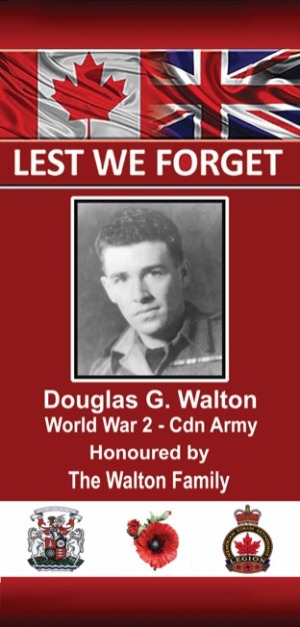 Douglas Walton was born in Newcastle on June 8, 1923, to Earl and Elsie Walton, who had three children. His father worked for the Province in the Department of Agriculture. In April 1942, at 18, he enlisted in the Royal Regiment of Canadian Artillery, 7th Medium Regiment. Douglas Walton was born in Newcastle on June 8, 1923, to Earl and Elsie Walton, who had three children. His father worked for the Province in the Department of Agriculture. In April 1942, at 18, he enlisted in the Royal Regiment of Canadian Artillery, 7th Medium Regiment.
His initial training occurred at Base Petawawa. The 7th Medium Regiment was raised in September 1939 with the mobilization of four Ontario militia field artillery batteries: the 12th (London), 45th (Lindsay), 97th (Walkerton) and 100th (Listowel). During that time at Base Petawawa, there were several organizational changes forming the 7th Army Field Regiment, RCA. Doug was part of the 45th battery in that regiment. Doug went to England in October of 1942, where he spent the next 20 months in training. After that, his battery took part in the major battles such as Normandy, the Seine crossing, the Channel ports (Boulogne and Calais), the Scheldt, Bergen op Zoom, Nijmegen salient, the Rhineland, the Rhine crossing, the advance through central and northern Netherlands, and finally across the Ems River into northwest Germany. Within 10 months, the 7th occupied about 60 gun positions and fired nearly 70,000 rounds of 100-pound shells. On November 29, 1945, Doug returned to Canada and was honourably discharged on January 21, 1946. After settling again in Newcastle, he married Marilyn Enwright in 1946 and raised a family of four boys. In town, he ran a taxi service and operated a convenience store. In 1950, he was hired by General Motors and worked in Oshawa until retirement in 1980. He was a member of the Royal Canadian Legion Branch 178 in Bowmanville and served as president from 1980 to 1984. In the 1960s, he was a committee member responsible for creating a cenotaph in the village of Newcastle. Doug died on March 24, 2002. He was 79. |
| Ross Wright |
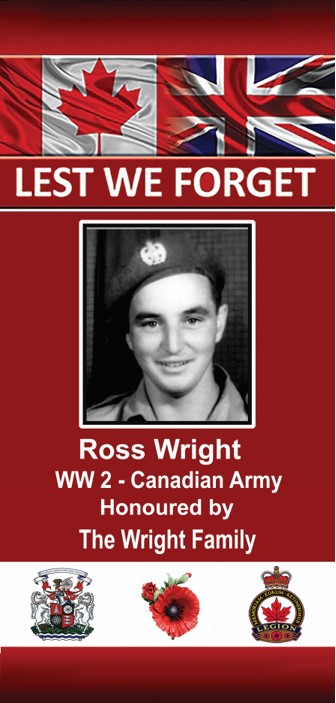 Thomas Ross (Rossy) Wright was born on January 15, 1922, in Bowmanville to Thomas Robinson and Annie (nee Humphrey) Wright, one of seven siblings, two brothers and four sisters, raised by them. His father was a World War One veteran. Ross was raised and received his elementary schooling in Bowmanville. It is unknown how far his education went, but like many young people raised in the Depression era, especially those in large families, finding work to support the family was imperative. He eventually found employment at the Goodyear plant in Bowmanville. Thomas Ross (Rossy) Wright was born on January 15, 1922, in Bowmanville to Thomas Robinson and Annie (nee Humphrey) Wright, one of seven siblings, two brothers and four sisters, raised by them. His father was a World War One veteran. Ross was raised and received his elementary schooling in Bowmanville. It is unknown how far his education went, but like many young people raised in the Depression era, especially those in large families, finding work to support the family was imperative. He eventually found employment at the Goodyear plant in Bowmanville.
Ross enlisted for service in WWII on June 26, 1940, at 18 years of age. His two brothers also enlisted. Initially, he was assigned to the Midland Regiment, as were many local recruitments. This Regiment has a history dating back to the Riel Rebellion in Manitoba and Saskatchewan in the 1880s, and a lengthy list of battle honours in WW1. However, in WW2 they were limited to domestic service, guarding critical infrastructure and coastlines. Most members wanted out to serve in active overseas units, and Ross was no exception as he was transferred to the Hastings and Prince Edward Regiment (Hasty Ps). This unit was already serving in England and Ross would have joined them there probably in 1941. While training in England, he told the story of meeting up with his two brothers while on leave and somehow they had purloined a roast of beef for the occasion, no doubt a joyous reunion ensued. In July of 1943, the Regiment landed in Sicily with the British 8th Army. After liberating the island, they joined the 1st Canadian Division on the Italian mainland in September of 1943. What followed was a brutal slog up the Italian peninsula for almost two years of action, his unit receiving battle honours no less than eleven times. Early in 1945 the unit was removed from Italy and sent to assist in the liberation of Holland, where another battle honour was earned. It is likely that Ross participated in most, if not all, of these engagements. Ross returned to Bowmanville after demobilization on November 12, 1945, and back to work at Goodyear. He met his wife, Helen Margaret (Peggy) Street at the West Beach, possibly in 1946 and they were married the following year. They lived with his in-laws on Scugog Rd. while having a house built on Southway Dr. Together, they raised a family of four children, three girls and a son. Ross retired from Goodyear in 1980 and worked part-time in the local Beer Store. He was a member of the local branch of the Royal Canadian Legion, serving a term as its president. He enjoyed the local bowling league and took up golfing. He died on February 7, 2017 at the age of 96 years. |
| Alvin Bruce Yeo |
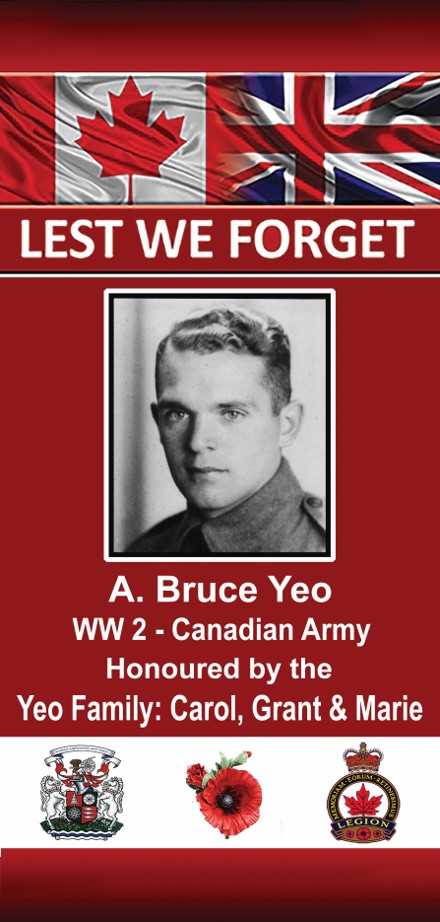 Alvin Bruce Yeo was born on March 20, 1919, to William and Emma Yeo (nee Prout) of Bowmanville, Ontario. He was the fifth of six children having four brothers and one sister. The family was raised on O’Dell Street, and when the boys reached fifteen or sixteen, they were placed on farms rented or bought by their father. Bruce met his wife Beatrice Ruth Colwill at a Young Peoples group at the Hampton United Church, and on November 25, 1940, they married. Beatrice gave birth to their daughter Carol in October 1941, the same day Bruce enlisted for service in the Second World War. Alvin Bruce Yeo was born on March 20, 1919, to William and Emma Yeo (nee Prout) of Bowmanville, Ontario. He was the fifth of six children having four brothers and one sister. The family was raised on O’Dell Street, and when the boys reached fifteen or sixteen, they were placed on farms rented or bought by their father. Bruce met his wife Beatrice Ruth Colwill at a Young Peoples group at the Hampton United Church, and on November 25, 1940, they married. Beatrice gave birth to their daughter Carol in October 1941, the same day Bruce enlisted for service in the Second World War.
Bruce was assigned to the Royal Canadian Ordnance Corps (RCOC), where he received 30 days of basic training and was sent to England. The task of the RCOC was to procure all the material goods required by the Army, from clothing to weapons. Also, up until 1944, the RCOC was responsible for maintenance and repair. Bruce received training and certification as a fitter, mechanic and heavy-duty diesel equipment operator. On February 22, 1944, the Royal Canadian Electrical and Mechanical Engineers began to combine various elements from the Royal Canadian Engineers, Royal Canadian Army Service Corps and Royal Canadian Ordnance Corps. In total, Bruce spent 42 months in the UK, once visiting his brother Keith, serving with the Royal Canadian Air Force (RCAF). With victory in Europe in 1945, he volunteered for service in the Pacific theatre, which never materialized with Japan's surrender a few months later. He returned home to his wife and four-year-old daughter. Ruth had also been busy working at two jobs, assisting the war effort working in a munitions factory and driving a truck for Chants Dairy. With her savings and a loan from the Veterans Land Act, they purchased a 57-acre farm on Main Street in Hampton, where they had two more children. Bruce worked at the Bowmanville Foundry and later General Motors but wanted a bigger farm. In 1950 they purchased a farm outside of Orono which Ruth stayed home and worked. They changed from being a general farm to breeding and selling beef cattle. They were proud of their prize-winning purebred Hereford herd and were the first in the area to pay off their loan. When Ruth passed away in 1994, Bruce continued to farm with his herd reaching 200 cattle on 500 acres owned or leased. Bruce died on their anniversary, November 25, 1999, at 85. |
| Harvey Keith Yeo |
|
Harvey Keith Yeo, best known as Keith, was born on December 16, 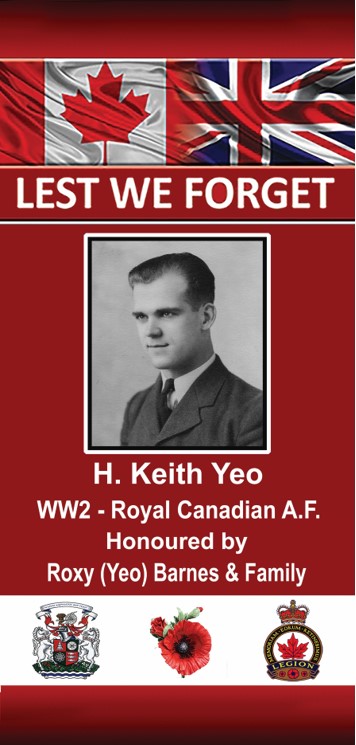 1920, in Bowmanville, Ontario. He was the youngest of six children born to Emma (nee Prout) and William (Bill) Henry Yeo. Keith’s earliest years were spent residing on O’Dell St. in Bowmanville, and his father Bill was employed at the Bowmanville Foundry. Keith attended Central Public School and Bowmanville High School before working at a garage in Hampton, training as a mechanic. 1920, in Bowmanville, Ontario. He was the youngest of six children born to Emma (nee Prout) and William (Bill) Henry Yeo. Keith’s earliest years were spent residing on O’Dell St. in Bowmanville, and his father Bill was employed at the Bowmanville Foundry. Keith attended Central Public School and Bowmanville High School before working at a garage in Hampton, training as a mechanic.
Keith signed up with the Royal Canadian Air Force (RCAF) in 1941 but wasn’t assigned to mechanic training until February 1942. He was sent to the Galt Aircraft School, part of the Galt Collegiate Institute. While billeted at a boarding house in Galt, he met his wife Alyce Cameron, his landlady's daughter. He was sent to a few other locations under the Commonwealth Air Training Program for further training, including the RCAF Technical Training School producing skilled ground crews for active wartime service. In late 1942 or early 1943, Keith deployed to England and was assigned to the RCAF 420 Squadron, known as the Snowy Owl Squadron, a bomber aircraft group. Keith served on the ground crew with his new RCAF squadron to keep the planes maintained and ready. Further, the squadron replaced older aircraft three times with newer, more powerful models. It was always a learning curve for them. In addition, his squadron was posted to Tunisia in North Africa from May to November of 1943, supporting the allied invasions of Sicily and the Italian mainland. The aircrews used to joke about how the ground crews treated the bombers as their own. They lectured many a pilot if damage occurred due to an accidental error. Keith was discharged as a Leading Aircraftsman, September 16, 1945, from Moncton with 1208 service days. On his return, Keith and Alyce married July 16, 1945, in the Hampton United Church parsonage. He and Alyce got an apartment in Bowmanville, then shortly afterwards, they moved into an apartment on the back of his family’s home on O’Dell St. On the passing of his father in 1958, Keith and Alyce bought the house, remaining there for the rest of their married lives. They adopted their daughter Roxanna Carol in 1949 when she was two and a half. Keith’s work experiences were varied, but he was brilliant and always well-liked. After returning from overseas, he worked at the Bowmanville Goodyear plant for months but found the rubber smell very difficult. He then worked as a supervisor at the Boys Training School for seven months and then GM, where he worked for seven years in heavy reject and testing army trucks. In the late 50s Keith went into the oil business, delivering oil and gas to homes and farms. He sold his business after 11 years. For the remainder of his working life, he was with Snowden Industrial Rubber in Oshawa. He learned to work on large industrial belts and travelled to factories to repair and replace their conveyor belts. Keith retired from Snowden’s December 24, 1986. In retirement, Keith travelled with Alyce, became active with Community Care Clarington, and was a life-long member of the local Legion Branch. He passed away on December 27, 2009, at 89. His biggest tribute came from his family; he was a wonderful husband, father, grandpa and great-grandpa. |
| Lorne E. Yeo |
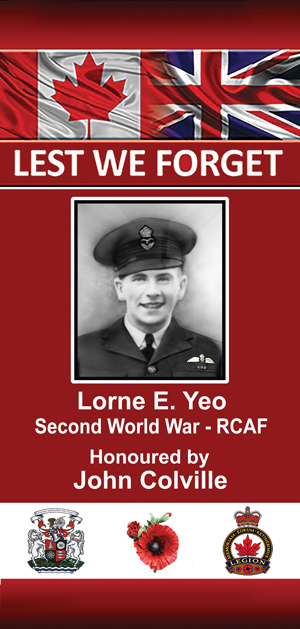 Lorne Yeo was born in Bowmanville on August 30, 1923, to Richard and Bertha May (nee Short) of Tyrone. They raised a family of nine children, Lorne was the youngest. He worked briefly at the local Goodyear plant before enlisting to serve in the Second World War in 1941, at 18. He was trained as an air gunner and transported overseas, where he was assigned to the Royal Canadian Air Force (RCAF) 426 Squadron. Lorne Yeo was born in Bowmanville on August 30, 1923, to Richard and Bertha May (nee Short) of Tyrone. They raised a family of nine children, Lorne was the youngest. He worked briefly at the local Goodyear plant before enlisting to serve in the Second World War in 1941, at 18. He was trained as an air gunner and transported overseas, where he was assigned to the Royal Canadian Air Force (RCAF) 426 Squadron.
On the evening of March 15, 1944, the operational Lancaster Bombers of 426 Squadron lifted off from their base at Linton-on-Ouse, England. Lorne was the tail gunner on one of these aircraft, and the squadron met up with other Bomber Command aircraft that had left their bases, about 860 bombers in total. The mission was a bombing raid on the southern German city of Stuttgart. This force was routed over southern France, almost to the Swiss border, before turning northeast for the attack on Stuttgart. This also served to delay the German night fighter aircraft, but when they arrived over the target, brutal air combats ensued. Thirty-seven bombers were lost in action, approximately 4.3 per cent of the raid force. Lorne’s aircraft was shot down and crashed into the Boblingen Forest, an area southwest of Stuttgart. All seven crew members died. Lorne was 20. It was a terrible night for Bowmanville, as two of the other aircraft lost on this raid contained local boys. Alec Colville and Kenneth Cole also died in the same action on this date. In 1947, the RCAF received a letter from a local resident of the German village of Steinenbronn, near the crash site of Lorne’s bomber. Although sheltering during the raid, the townspeople were aware that one of the aircraft had come down in the wooded area close to town. When the raid ended, they immediately searched for the aircraft to give aid to any surviving airmen. The letter explains that the townspeople took photos at airmen’s places of death and retrieved the identity disks and other personal effects. The airmen’s remains were treated with respect until they were turned over to authorities the following day. The Gestapo confiscated the cameras, but the townspeople managed to hold onto and return the personal property of the airmen. Part of the correspondence reads: “The time has come now that the war is no longer separating nations, and even the German people dare hope they will be trusted and humanly recognized again by others, and so we will write down this story for the next-of-kin of the dead airmen and the Royal Canadian Air Force.” |
Contact Us





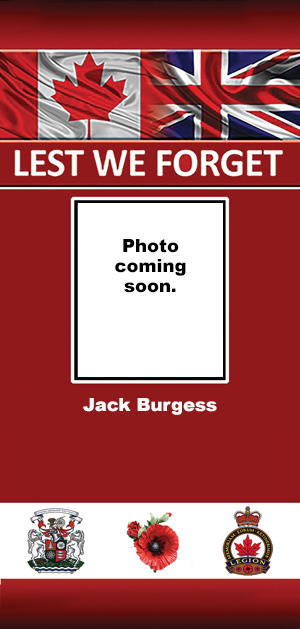
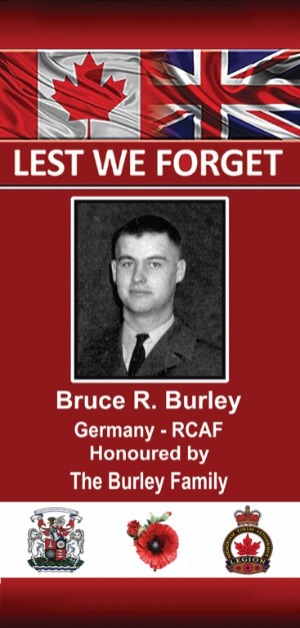 Bruce Burley was born on January 4, 1946, in Newtonville to Ron, a Royal Canadian Air Force (RCAF) veteran from the Second World War, and Mary Jane (nee Denault). Ron and his brothers operated a family garage business in Newtonville, eventually founding a transit business, the Burley Bus Lines.
Bruce Burley was born on January 4, 1946, in Newtonville to Ron, a Royal Canadian Air Force (RCAF) veteran from the Second World War, and Mary Jane (nee Denault). Ron and his brothers operated a family garage business in Newtonville, eventually founding a transit business, the Burley Bus Lines.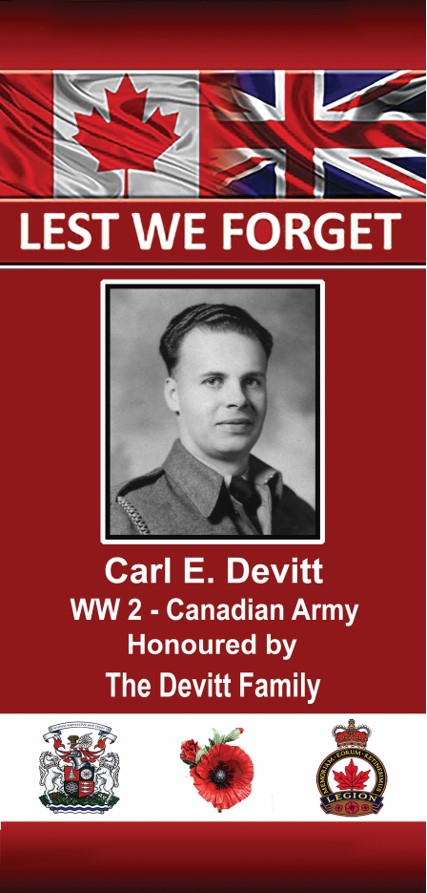 Carl Evans Devitt was born on October 7, 1919, to Andrew and Mabel Devitt, farmers near Blackstock on Concession Road 3 in Cartwright Township, presently known as Devitt’s Road. After Carl’s father died, Carl moved with his mother and sister to Bowmanville when he was eleven. His mother opened a boarding house on Scugog Street near the present-day CPR tracks. Carl completed his education at Bowmanville High School and worked at the Goodyear plant when he was 17.
Carl Evans Devitt was born on October 7, 1919, to Andrew and Mabel Devitt, farmers near Blackstock on Concession Road 3 in Cartwright Township, presently known as Devitt’s Road. After Carl’s father died, Carl moved with his mother and sister to Bowmanville when he was eleven. His mother opened a boarding house on Scugog Street near the present-day CPR tracks. Carl completed his education at Bowmanville High School and worked at the Goodyear plant when he was 17.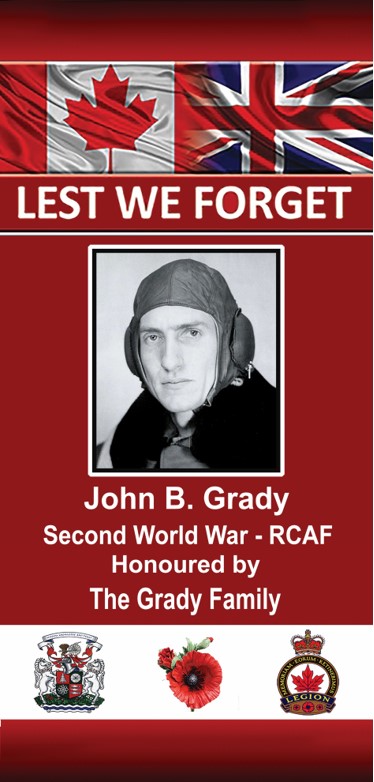 John Bruce Grady was born in Hamilton, Ontario, on April 28, 1918. He was the second oldest of seven children to John Earle and Mary Lulu Grady. At 13, following the death of his maternal grandfather, John left home and moved to Orono to live with his grandmother. He helped run the Armstrong family general store. He soon became well-known around Orono as he delivered groceries and became a popular figure over the years.
John Bruce Grady was born in Hamilton, Ontario, on April 28, 1918. He was the second oldest of seven children to John Earle and Mary Lulu Grady. At 13, following the death of his maternal grandfather, John left home and moved to Orono to live with his grandmother. He helped run the Armstrong family general store. He soon became well-known around Orono as he delivered groceries and became a popular figure over the years.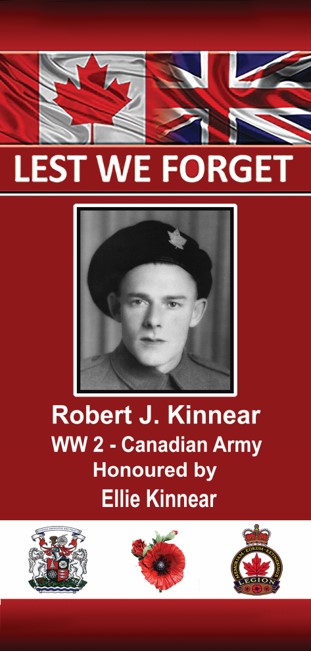 Robert Kinnear was born in Tattynure, Northern Ireland, on December 28, 1910. He moved to Canada with his parents and eight siblings in 1927 when he was 17, and the family settled in Jolicure, New Brunswick, where they farmed a small property. Robert worked hard to find employment at local logging camps to help support his family during the Great Depression.
Robert Kinnear was born in Tattynure, Northern Ireland, on December 28, 1910. He moved to Canada with his parents and eight siblings in 1927 when he was 17, and the family settled in Jolicure, New Brunswick, where they farmed a small property. Robert worked hard to find employment at local logging camps to help support his family during the Great Depression.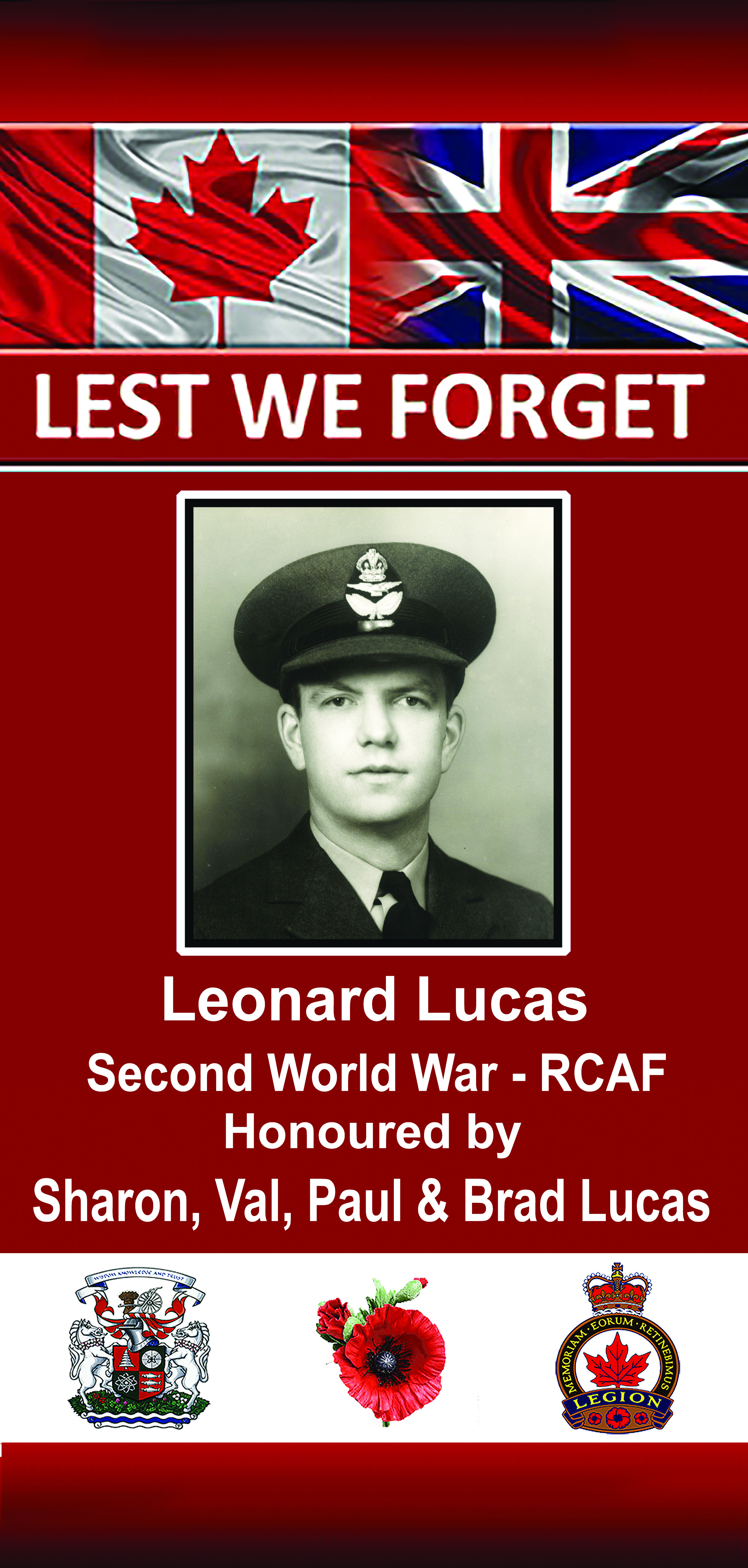 On December 31, 1908, Leonard (Len) Lucas was born in Kent County, England, before moving to Canada as a young child. His family settled on the Dungannon Farm estate, owned by a wealthy American industrialist near Cobourg, Ontario. Len’s father farmed the property, and Len grew up working alongside him on the farm. Len studied mathematics at Queen’s University and graduated in 1936. After graduating, he taught math at Bowmanville High School (BHS) and, while there, met his wife, Patricia Emmett. One of his colleagues at BHS was Harold Longworth, who joined the Royal Canadian Air Force (RCAF) with Len in June of 1941. The pair remained friends until Harold died in a plane crash on a training flight in 1942. Len was 32 years when he enlisted.
On December 31, 1908, Leonard (Len) Lucas was born in Kent County, England, before moving to Canada as a young child. His family settled on the Dungannon Farm estate, owned by a wealthy American industrialist near Cobourg, Ontario. Len’s father farmed the property, and Len grew up working alongside him on the farm. Len studied mathematics at Queen’s University and graduated in 1936. After graduating, he taught math at Bowmanville High School (BHS) and, while there, met his wife, Patricia Emmett. One of his colleagues at BHS was Harold Longworth, who joined the Royal Canadian Air Force (RCAF) with Len in June of 1941. The pair remained friends until Harold died in a plane crash on a training flight in 1942. Len was 32 years when he enlisted.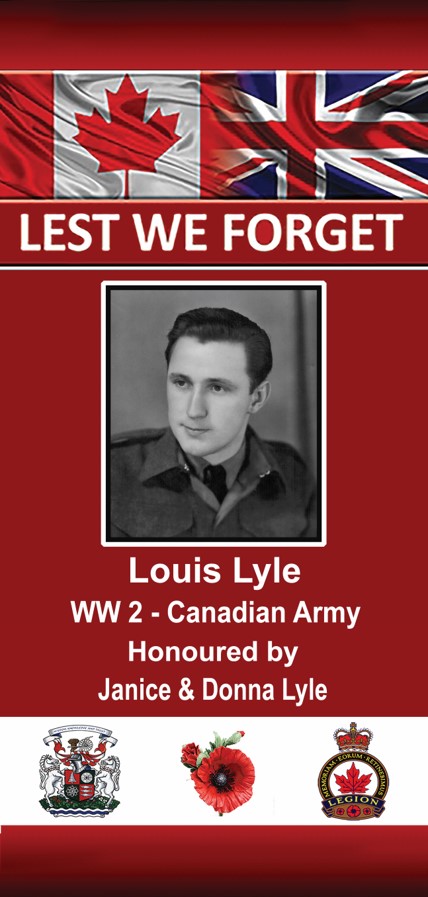 Louis Lyle was born on October 8, 1919, in Bowmanville to George and Margaret (nee Chapman) Lyle. The family totalled eleven siblings.
Louis Lyle was born on October 8, 1919, in Bowmanville to George and Margaret (nee Chapman) Lyle. The family totalled eleven siblings.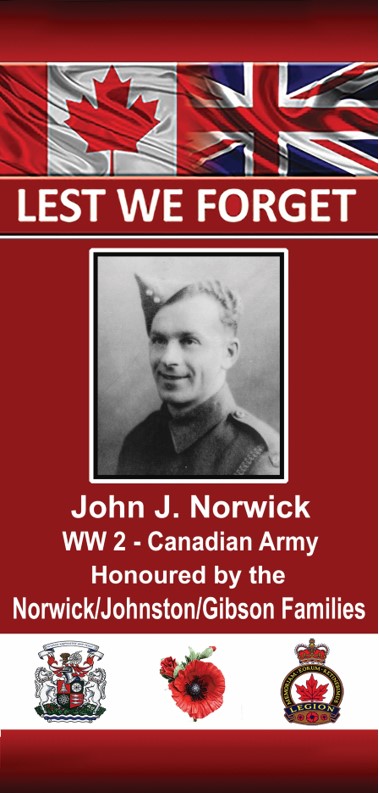 John James “Jack” Norwick was born on April 4, 1917, in Fort William, now known as Thunder Bay. He was the first son and second of nine children. His parents came to Canada in 1914 from Romania, and the family moved to the area now known as Durham Region around 1918 and lived on a series of farms in Whitby, Oshawa, Bowmanville and Pontypool. Because the family was quite poor and the children were needed to work on the farm, Jack only had a seventh-grade education. He left home at 13 to work on a nearby farm for room and board.
John James “Jack” Norwick was born on April 4, 1917, in Fort William, now known as Thunder Bay. He was the first son and second of nine children. His parents came to Canada in 1914 from Romania, and the family moved to the area now known as Durham Region around 1918 and lived on a series of farms in Whitby, Oshawa, Bowmanville and Pontypool. Because the family was quite poor and the children were needed to work on the farm, Jack only had a seventh-grade education. He left home at 13 to work on a nearby farm for room and board.